Editor Guest Co-Editors
Executive Editor
Art Director
Managing Editor
Associate Editors
Assistant Editor
Production Fulfillment

Charles Newman
Lawrence Levy
John Perreault
Elliott Anderson
Lawrence Levy
Theresa Maylone
Michael McDonnell
Allan Gray
Mary Elinore Smith
Cynthia Anderson
Mary M. Zakrasek
TriQuarterly is an international Journal of arts, letters, and opinion published in the fall, winter, and spring at Northwestern University, Evanston, Illinois 60201. Subscription rates: One year $10.00; two years $15.00; three years $20.00. Foreign subscriptions $1.00 per year additional. Single copies usually $3.50. Back issue prices on request. Contributions, correspondence, and subscriptions should be addressed to TriQuarterly, UniverSity Hall 101, Northwestern University, Evanston, Illinois 60201. The editors invite submissions, but queries are strongly suggested. No manuscript Will be returned unless accompanied by a stamped, self-addressed envelope. All manuscripts accepted for publication become the property of TriQuarterly, unless otherwise indicated Copyright © 1975 by TriQuarterly. All rights reserved. The views expressed in this magazine are to be attributed to the writers, not the editors or sponsors. Printed in the United States of America. Claims for missing numbers will be honored only within the four-month period after month of issue.
National distributor to retail trade: B. DeBoer, 188 High Street. Nutley, New Jersey 07110. Distributor for west coast retail trade: Book People, 2940 7th Street Berkeley, California 94710. Distributor for Great Britain and Europe: B. F Stevens & Brown, Ud., Ardon House, Mill Lane, Godalming, Surrey, England.
Reprints of back issues of TflQuarterly are now available in full format from Kraus Reprint Company, Route 100, Millwood, New York 10546, and in microfilm from University Microfilms, A Xerox Company, Ann Arbor, Michl' gan 48106.
John Perreault
Ira Joel Haber
Lawrence Weiner
Joseph Beuys
Christo

Agnes Denes
Marjorie Strider
Douglas Huebler
Gregg Powell
Brenda Miller
John Baldessari
Gilbert and George
LeAnn Bartok WiIchusky
Vito Acconci
Hans Haacke
Richard Serra
Will Insley
Phil Berkman
Michael Crane
Michael Kirby
Stephen Zaima
Eleanor Antin
Jan Sullivan
Nancy Holt
Adrian Piper
Robert Barry
Richard Long
Sol LeWitt
Robert Smithson
Joseph Kosuth
Alice Aycock
A. Ribe
Daniel Buren
Rafael Ferrer
Scott Burton
Les Levine
John Perreault
Introduction

This issue of TriQuarterly is devoted for the most part to kinds of recent art that operate from the premise that the art idea is more important than, or as important as, the physical or the visible expression of that idea. Ideas have always been an important aspect of art: ideas about society, the self, the world. Ideas about art itself in art have always been part of art. In the past, most ideas about art itself in art have been received and implicit. Very few artists until the modern period were able to question inherited or imposed notions of what art was supposed to be, or what it was to be composed of, or what purposes it was required to serve. Some recent art however, is based upon or proceeds from not only the questioning of these assumptions, but the questioning of all assumptions about art leading to the proposition that an art work need not be particularly physical or particularly visual, but may be an idea, presented as efficiently as possible. We know that we can have painting that is not narrative, that does not use traditional perspective and modeling, that does not represent persons or things. We also already know that we can have painting that virtually eliminates internal relationships of color and form. We already know that we can have sculpture that is almost completely sculptural. In many ways, various artists have eliminated color, composition, personal touch and obvious kinds of personal expression. Personal fabrication is also no longer necessary. What is left? The art idea. Can we then have kinds of art that are mainly ideas? The answers are on the following pages. Here, the words are meant to point to art ideas. The photbgraphy is not photography as an art form in itself but photography used as documentation and as a source of art information. This issue of TriQuarterly is not "about" art butis art. It is a portable exhibition, rather like a major museum show, but with one significant difference: it takes up very little space. All of the art is accessible within the reader/viewer's own time and space and at the reader/viewer's convenience. This is an exhibition that takes place simultaneously in many places at once - wherever this issue is seen - but it takes

place mainly in the mind, the realm of ideas. In most cases, the pages that follow are art works in themselves or extensions or reflections of inaccessible or ephemeral art works. A number of the works were made specifically for this issue. Although TriQuarterly itself is a portable object, it is much less an object than a painting or a sculpture on a pedestal. The works included are not discrete, portable objects themselves. They are anti-objects or non-objects. They are art ideas communicated by documentation, proposals, or instructions, using language and/or photographs, or are in the form of language and/or photographs themselves. With the exception of the large outdoor pieces that are documented and some of the performances, materiality is of slight consequence beyond what is necessary for communication. We have included earthworks, conceptual art, performances, and some as yet unnamed and perhaps unnameable forms and formats. Earthworks, sometimes called earth art, are large outdoor sculptures using the land and the landscape as materials, such as the late Robert Smithson's "Spiral Jetty" and "Amarillo Ramp." These qualify as non-objects because of their scale and their interdependent relationships with geographical sites. In some sense, earthworks are attempts to operate outside the lim�ed art system of galleries and museums and precious object commodities. Nevertheless, they are mainly communicated through the art system, at this point, by photographs, films and other documentation, since scale and materials usually necessitate distant and often inaccessible locations.
Conceptual art is more an attitude than a style. Those who are called conceptual artists often disagree with each other, some preferring to limit their pursuits to what amounts to philosophical investigation (Kosuth, for example), whereas others use graphic and verbal methods to communicate relationships and situations. Sol LeWItt is usually credited with being the first to use the term "conceptual" in art. His early insistence on the importance of the systems and ideas behind his sculptures and wall drawings, and not their visual results, was seminal. Comparing the works of Joseph Kosuth, Douglas Huebler, Robert Barry, and Lawrence Weiner, who were among the first actually to be called conceptual artists, will give some idea of the diversity w�hin this category. Performances can be looked upon as theater pieces, by artists, related to Happenings perhaps, but far more structured and stark,

or as works of kinetic, environmental sculpture. They are usually non-matrixed: the activities performed by the artist are clearly performed by the artist as himself rather than as some fictional character. They are often of considerable duration. Joseph 8euys' piece, documented here, continued for three days. "Gilbert and George, 'The Singing Sculpture' ". was performed at rock concerts and in galleries, using stylized, robot-like movements and a taped song called "Underneath the Arches," repeated over and over again.
Obviously, the art here does not conform to any strict program, either that of the editors or of any of the artists included. A conference of all the artists included, called to discuss art or the contents of this issue, would, I am sure, result in sheer mayhem. What unites the selection is the emphasis upon the art idea as opposed to the art object.
I myself find it inspiring, if a bit paradoxical, that so much of the art we are presenting, which has eliminated so much of the expected qualities or properties of traditional art is able to say so much about art and about the world. Sometimes, the search for original art solutions opens up references once thought beyond the permitted range of serious modern art. Since the work of art is firmly imbedded in the art context which in turn is firmly imbedded in life, it is not surprising that art investigations should yield some rich material about the art system and the sociology of the art context which in turn offers implications about other systems and contexts and perhaps civilization itself. Hans Haacke's listing of the trustees of the Guggenheim Museum, Rafael Ferrer's bilingual invective, and Ira Joel Haber's documentation of his dealings with a German art gallery are examples of such investigations. Les Levine's analysis of a news photo says a great deal about some methods of art analysis in an amusing and an ironic manner. Eleanor Antin, Adrian Piper, and Vito Acconci investigate the slippery, sometimes murky world of the self. Joseph 8euys, possibly the most highly regarded European artist to emerge after the Second World War, has been confounding and provoking his German countrymen and all of Europe with his non-stop performances, his grease and felt sculptures, and his recent political efforts towards referendum democracy.
Marcel Duchamp (1887-1968) became the star of the Armory Show of 1913 with his painting "Nude Descending a Staircase". Around

the same time, he discovered the "readymade", ordinary manufactured objects such as a bicycle wheel mounted on a stool, a bottle-rack, a snow shovel, a typewriter cover, which he signed, titled, and placed in the art context, thereby making them art no matter what his aggressive intentions may have been. As the artist who insisted that art should be in the service of the mind and as the artist who disdained what he called retinal art, he established the precedent for much of the art in our collection. Willem de Kooning, the great painter of the New York School, or of Action Painting, once said that Duchamp was a one-man art movement. I think of most of the artists we have included here as one-man art movements - one-person art movements - for they are so diverse and so individual. Reduction, or the logic of the process of elimination, and the precedent of Duchamp's linguistic and metalinguistic art, does not explain away the art that follows. Instead of explanations, I am trying to offer various approaches to the art works themselves.
Here is another approach. Since most people experience art second-hand through other media, through photographs in magazines and books and through verbal descriptions, why not make art that is mainly photographs and verbal description? It is much easier to send a photograph by mail than it is to ship a chunk of marble or a painting. Given the enormous difficulties in storing, shipping, protecting, and even merely accounting for art objects, this is no longer a trivial consideration. Ira Joel Haber, who began as an information artist and then started making sculpture, has documented this quite well in his present return to conceptual art which is included in this issue. But if the idea is all-importantwhy bother with the object? It has long been a practice for art works to be constructed from diagrams and instructions, often without the artist present sometimes merely communicated by letter or telephone. For those not committed by aesthetics or proclivity to the direct manipulation of materials, it is only one small step then to dispense with the art object entirely. I once thought that this kind of art represented an art and literature hybrid. I was mistaken. It has practically no literary value at all. Narrative, perhaps, but not literary. Some persist in seeing it as philosophy. I have grave doubts about this, too. I also thought that earthworks, conceptual art and performances were a direct challenge to the art system that depends so much upon precious
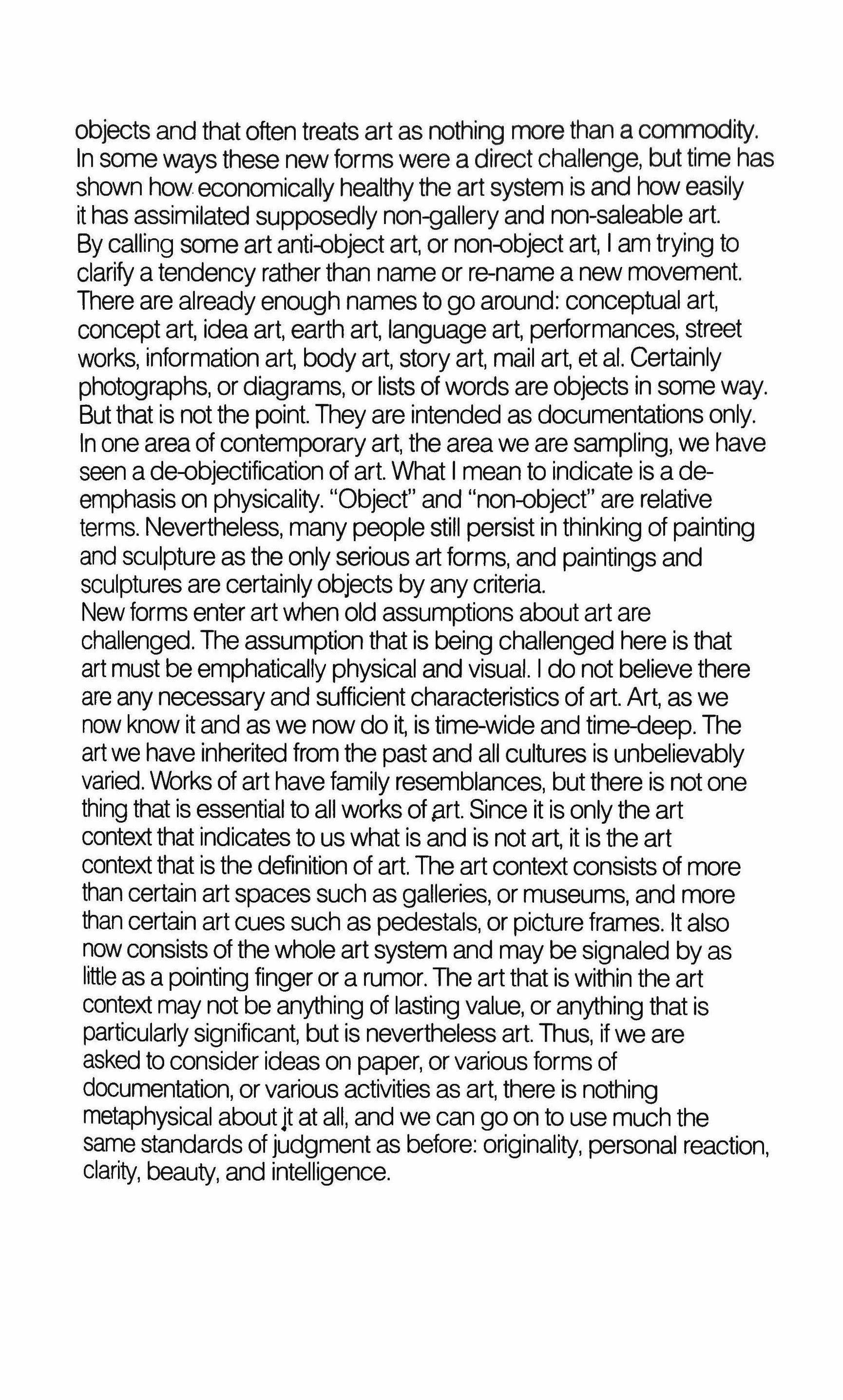
objects and that often treats art as nothing more than a commodity. In some ways these new forms were a direct challenge, but time has shown how economically healthy the art system is and how easily it has assimilated supposedly non-gallery and non-saleable art. By calling some art anti-object art, or non-object art, I am trying to clarify a tendency rather than name or re-name a new movement. There are already enough names to go around: conceptual art, concept art, idea art, earth art, language art, performances, street works, information art, body art, story art, mail art, et al. Certainly photographs, or diagrams, or lists of words are objects in some way. But that is not the point. They are intended as documentations only. In one area of contemporary art, the area we are sampling, we have seen a de-objectification of art. What I mean to indicate is a deemphasis on physicality. "Object" and "non-object" are relative terms. Nevertheless, many people still persist in thinking of painting and sculpture as the only serious art forms, and paintings and sculptures are certainlyobjects by any criteria. New forms enter art when old assumptions about art are challenged. The assumption that is being challenged here is that art must be emphatically physical and visual. I do not believe there are any necessary and sufficient characteristics of art. Art, as we now know it and as we now do it, is time-wide and time-deep. The art we have inherited from the past and all cultures is unbelievably varied. Works of art have family resemblances, but there is not one thing that is essential to all works ofart Since it is only the art context that indicates to us what is and is not art, it is the art context that is the definition of art. The art context consists of more than certain art spaces such as galleries, or museums, and more than certain art cues such as pedestals, or picture frames. It also now consists of the whole art system and may be signaled by as little as a pointing finger or a rumor. The art that is within the art context may not be anything of lasting value, or anything that is particularly significant, but is nevertheless art. Thus, if we are asked to consider ideas on paper, or various forms of documentation, or various activities as art, there is nothing metaphysical aboutjt at all, and we can go on to use much the same standards of judgment as before: originality, personal reaction, clarity, beauty, and intelligence.
Ira Joel Haber
The M. E. Thelen piece
Introduction

105 West 27th Street
New York, New York 10001
December 28, 1973 -
Dr. Klaus Hennig
Attorney at Law 43 Essen Klarastrasse 29 West Germany
Dear Dr. Hennig,
1 am writing to you on the recommendation of D. Thomas Longo Jr., the American Consul in Dusseldorf. The problem 1 have is a financial matter that has to'do with my deal ings as an American artist with the M.E. Thelen Gallery in Essen.
The problems cover a long period and much correspondence on my part with M.E. Thelen, so I will try to discuss the situation as simply as possible.
I was recommended to M.E. Thelen by another American artist and sent photographs of my work to Mr. Karl Jollenbeck, the director of the galler� on February IS, 1971. On March 5, 1971,1 received a letter from Mr. Jollenbeck offerin� me a one-man exhibition in his gallery. He assured me "that we are reliable persons so that you have not have fear that some happens to your work."
Consequently, I had a one-man exhibition of my sculpture at his gallery from January to February 1972. There were twenty-eight pieces in the show, including four drawings. The total retail price for all the work came to $11,850. M.E. Thelen was to get 30% of the retail price of any work sold. I was to get 70%, with 20% of my share going to the gallery that exhibits my work in New York City.

I went to Cologne to supervise the installation of my work, paying for my flight over and back. While I was there I was told that four pieces of sculpture and one drawing were sold. The total amount for these pieces came to $2,750. My percentage (70%) comes to $1,925. As of today they have sent me $1,600. which means that they owe me $325.
In a letter of November 26, 1971, Jollenbeck stated that "The show should stay in Europe one year after the end of the show in our gallery. Payment have to be settled for all sales at this time too." I have written to Mr. Jollenbeck many times asking him to send me an itemized list of all the work that has been sold, so I would know how much money he actually owes me, and which of my pieces are to be returned. I have even called him long distance. I have had no response. He has also refused to tell me who has bought my work, and he has made no arrangements for sending my work back to me. I have tried every way to get my money and my work back. I've written to German art collectors who have bought my work in the past, other German art dealers. and art critics. If you wish I can send you copies of my letters to Mr. Jollenbeck and the persons mentioned above. I want to sue them for $10,250 which represents the original price of the work they still have. I would also like my work back. They were located in Cologne and Essen, but Mr. Longo informed me that they have since left Cologne and are only in Essen now. The address in Essen is as follows: Mr. Karl E. Jollenbeck, Director
Galerie M.E. Thelen
36 Saarbruecker strasse
43 Essen Germany
I do not have much money, but this means a great deal to me, and I would be willing to do whatever is necessary. I would appreciate any help you might offer.
Sincerely yours,
Ira Joel Haber

Persons involvoo
Rafael Ferrer: artist �U1d friend. Recommended me to the M. E. Thelen Gallery.
Dr. Klaus Hennig: German lawyer, practicing in Essen, West Germany.
KarlJollenbeck: director ofthe M. E. Thelen Gallery, Cologne, West Germany.
Barbara Kuckels: secretary for the M. E. Thelen Gallery.
Dr. Udo Kultermann: German art critic and art historian living in the United States. Wrote several catalog introductions for the M. E. Thelen Gallery. us Levine: artist and friend. Had several shows with the M. E. Thelen Gallery.
D. Thomas Longo, Jr.: American Consul, Dusseldorf, West Germany.
Dr. Peter Ludwig: important German collector ofcontemporary art. His two public collections are housed in the Neue Galerie, Aachen, and the WallrafRichartz Museum, Cologne, West Germany.
Aladar Marberger: director ofthe Fischbach Gallery, New York City.
Michael Nickel: assistant director ofthe M. E. Thelen Gallery.
Dr. AlfObbelode: German art collector.
Henry Odell: husband of Lil Picard.
Lil Picard: artist and art critic.
Edith Reichmann: friend of Michael Nickel.
Dr. Peter Sager: German art critic who interviewed me when I was in Cologne. Hannes Von Gosseln: directorofthe Galerie De Gestio, Hamburg, West Germany.
Dr. Maria Wellershoff: "Girl Friday" for the M. E. Thelen Gallery.
Summaries ofletters
February 15, 1971. Letter to KarlJollenbeck, Cologne, West Germany. A follow-up letter after Rafael Ferrer recommended me to the M. E. Thelen Gallery. Enclosed with the letter were photographs ofmy work from 1969, a resume, and a copy ofmy latest booklet, Films No.1. Wrote to Jollenbeck that he should feel free to contact me by mail or in person.
February 19,1971. Letterfrom Dr. Udo Kultermann, Washington University, S1. Louis, Missouri. Kultermann said he was very interested in my work and requested photographs, and information concerning my sculpture for publishing exhibition purposes. He asked if I would like to have a show in Europe and to let him know.
March 5,1971. Letter from Karl Jollenbeck, Essen, West Germany. A long letter, in which Jollenbeck thanked me for the photographs and biography I had sent him. Asked if I would like to have a show with his gallery, M. E. Thelen, and requested information about the kinds ofmaterials I work with and how much my work sold for in New York. He said he was anxious to show my work as soon as possible, and said that they were a reliable gallery and I wouldn't have to worry about anything happening to my work. Also suggested I send photographs to Dr. Udo Kultermann, who wrote their catalogs,
March 9, 1971. Letter from Dr. Maria Wellershoff, Cologne, West Germany. Short note thanking me for my letterof March 7th. (There is no record in my file of a letter being sent on March 7th, she probably meant the letter of February 15th.) She told me that Mr. Jollenbeck would write to me as soon as he carne back from "hisjourney."
March 11, 1971. Letter to Dr. Udo Kultermann, Washington University, S1. Louis, Missouri. I thanked him for his interest in my work and told him that I would like to have a show in Europe very much, but it would have to take place after I had my first one man exhibition with the Fischbach Gallery in New York City, who hadjust taken me on as one oftheir artists. I. told him I had written to Mr.
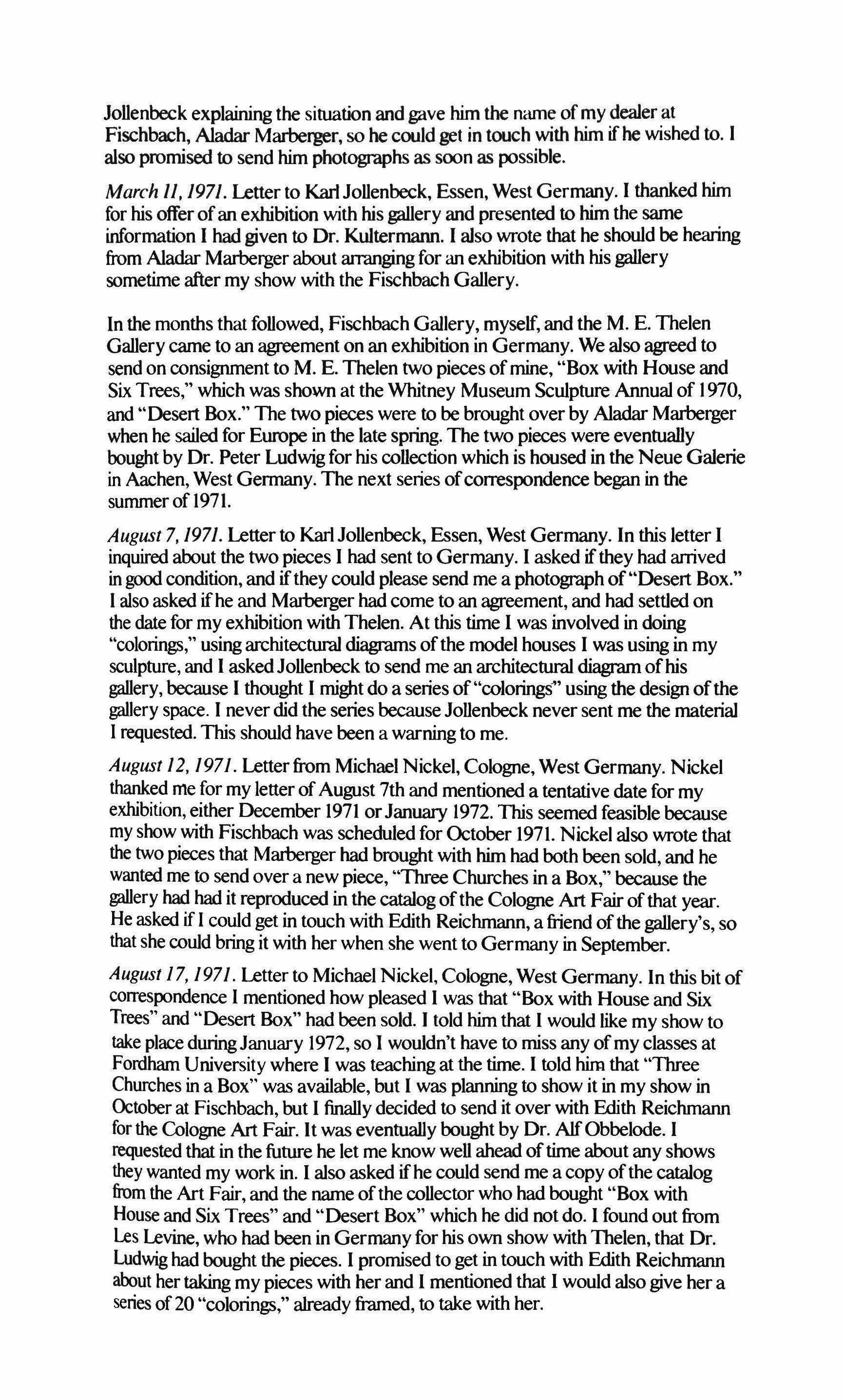
Jollenbeck explaining the situation and gave him the name of my dealer at Fischbach, Aladar Marberger, so he could get in touch with him if he wished to. I also promised to send him photographs as soon as possible.
March 11, 1971. Letter to Karl Jollenbeck, Essen, West Germany. I thanked him for his offer of an exhibition with his gallery and presented to him the same information I had given to Dr. Kultermann. I also wrote that he should be hearing from Aladar Marberger about arranging for an exhibition with his gallery sometime after my show with the Fischbach Gallery.
In the months that followed, Fischbach Gallery, myself, and the M. E. Thelen Gallery came to an agreement on an exhibition in Germany. We also agreed to send on consignment to M. E. Thelen two pieces ofmine, "Box with House and Six Trees," which was shown at the Whitney Museum Sculpture Annual of 1970, and "Desert Box." The two pieces were to be brought over by Aladar Marberger when he sailed for Europe in the late spring. The two pieces were eventually boughtby Dr. Peter Ludwigfor his collection which is housed in the Neue Galerie in Aachen, West Germany. The next series ofcorrespondence began in the summer of 1971.
August 7, 1971. Letter to Karl Jollenbeck, Essen, West Germany. In this letter I inquired about the two pieces I had sent to Germany. I asked ifthey had arrived in goodcondition, and ifthey could please send me a photograph of"Desert Box." I also asked ifhe and Marberger had come to an agreement, and had settled on the date for my exhibition with Thelen. At this time I was involved in doing "colorings," using architectural diagrams ofthe model houses I was using in my sculpture, and I asked Jollenbeck to send me an architectural diagram ofhis gallery, because I thought I might do a series of"colorings" using the design ofthe gallery space. I never did the series because Jollenbeck never sent me the material I requested. This should have been a warning to me.
August 12, 1971. Letter from Michael Nickel, Cologne, West Germany. Nickel thanked me for my letter ofAugust 7th and mentioned a tentative date for my exhibition, either December 1971 or January 1972. This seemed feasible because my show with Fischbach was scheduled for October 1971. Nickel also wrote that the two pieces that Marberger had brought with him had both been sold, and he wanted me to send over a new piece, "Three Churches in a Box," because the gallery had had it reproduced in the catalog ofthe Cologne Art Fair ofthat year. He asked if I could get in touch with Edith Reichmann, a friend ofthe gallery's, so that she could bring it with her when she went to Germany in September.
August 17,1971. Letter to Michael Nickel, Cologne, West Germany. In this bit of correspondence I mentioned how pleased I was that "Box with House and Six Trees" and "Desert Box" had been sold. I told him that I would like my show to take placeduringJanuary 1972, so I wouldn't have to miss any ofmy classes at Fordham University where I was teaching at the time. I told him that "Three Churches in a Box" was available, but I was planning to show it in my show in October at Fischbach, but I finally decided to send it over with Edith Reichmann for the Cologne Art Fair. It was eventually bought by Dr. AIfObbelode. I requested that in the future he let me know well ahead oftime about any shows they wanted my work in. I also asked ifhe could send me a copy ofthe catalog from the Art Fair, and the name ofthe collector who had bought "Box with House and Six Trees" and "Desert Box" which he did not do. I found out from Les Levine, who had been in Germany for his own show with Thelen, that Dr. Ludwig had bought the pieces. I promised to get in touch with Edith Reichmann about her taking my pieces with her and I mentioned that I would also give her a series of 20 "colorings," already framed, to take with her.
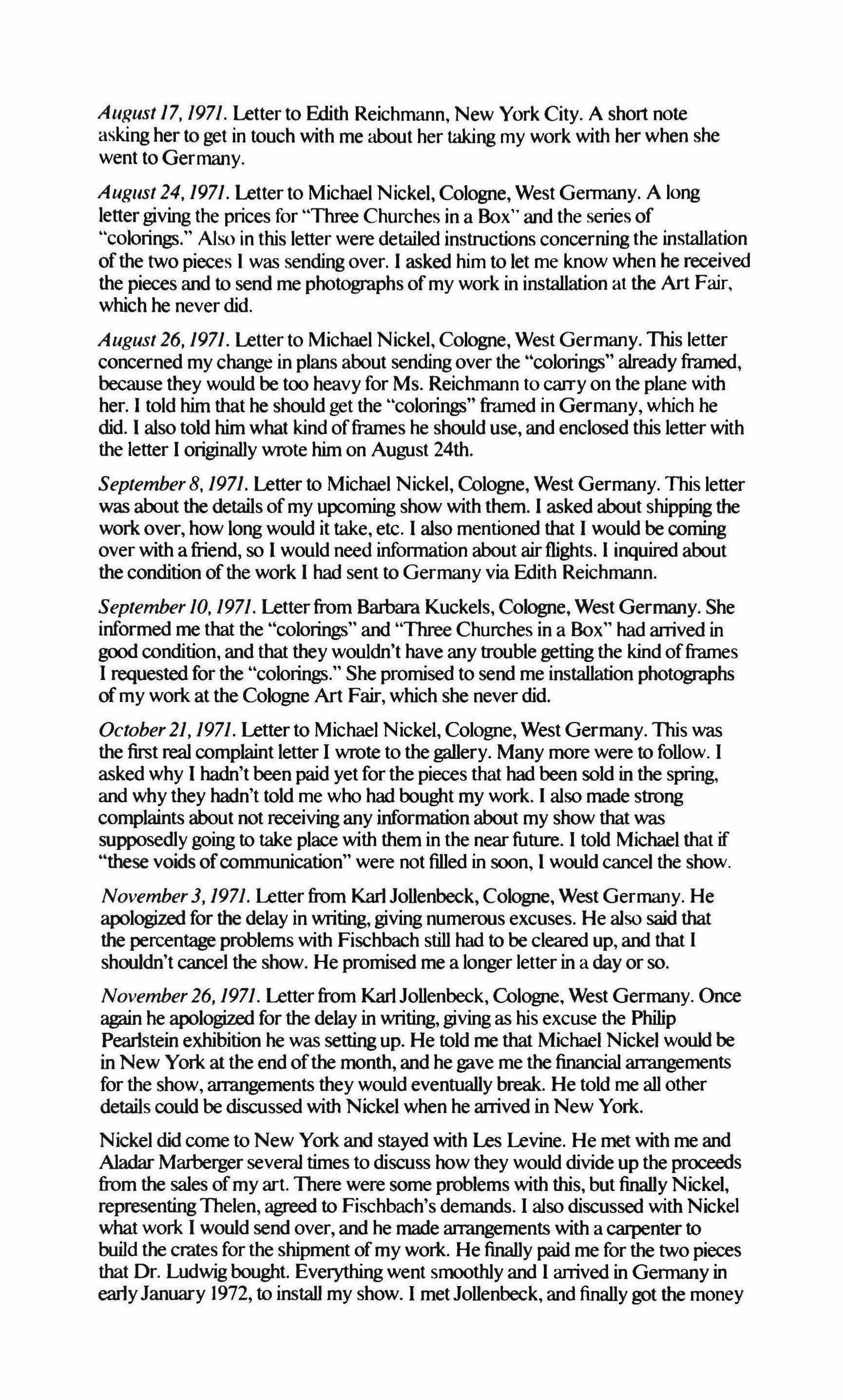
August 17,1971. Letter to Edith Reichmann, New York City. A short note asking her to get in touch with me about her taking my work with her when she went to Germany.
August 24,1971. Letter to Michael Nickel, Cologne, West Germany. A long letter giving the prices for "Three Churches in a Box" and the series of "colorings." Also in this letter were detailed instructions concerning the installation ofthe two pieces I was sending over. I asked him to let me know when he received the pieces and to send me photographs ofmy work in installation at the Art Fair, which he never did.
August 26,1971. Letter to Michael Nickel, Cologne, West Germany. This letter concerned my change in plans about sending over the "colorings" already framed, because they would be too heavy for Ms. Reichmann to carryon the plane with her. I told him that he should get the "colorings" framed in Germany, which he did. I also told him what kind offrames he should use, and enclosed this letter with the letter I originally wrote him on August 24th.
September 8,1971. Letter to Michael Nickel, Cologne, West Germany. This letter was about the details ofmy upcoming show with them. I asked about shipping the work over, how long would it take, etc. I also mentioned that I would be coming over with a friend, so I would need information about airflights. I inquired about the condition ofthe work I had sent to Germany via Edith Reichmann.
September /0, 1971. Letterfrom Barbara Kuckels, Cologne, West Germany. She informed me that the "colorings" and "Three Churches in a Box" had arrived in good condition, and that they wouldn't have any trouble getting the kind offrames I requested for the "colorings." She promised to send me installation photographs ofmy work at the Cologne Art Fair, which she never did.
October21,1971. Letter to Michael Nickel, Cologne, West Germany. This was the first real complaint letter I wrote to the gallery. Many more were to follow. I asked why I hadn't been paid yet for the pieces that had been sold in the spring, and why they hadn't told me who had bought my work. I also made strong complaints about not receiving any information about my show that was supposedly going to take place with them in the near future. I told Michael that if "these voids ofcommunication" were not filled in soon, I would cancel the show.
November3,1971. Letter from Karl Jollenbeck, Cologne, West Germany. He apologized for the delay in writing, giving numerous excuses. He also said that the percentage problems with Fischbach still had to be cleared up, and that I shouldn't cancel the show. He promised me a longer letter in a day or so.
November 26,1971. Letter from Karl Jollenbeck, Cologne, West Germany. Once again he apologized for the delay in writing, giving as his excuse the Philip Pearlstein exhibition he was setting up. He told me that Michael Nickel would be in New York at the end ofthe month, and he gave me the financial arrangements for the show, arrangements they would eventually break. He told me all other details could be discussed with Nickel when he arrived in New York.
Nickel did come to New York and stayed with Les Levine. He met with me and AIadar Marberger several times to discuss how they would divide up the proceeds from the sales ofmy art. There were some problems with this, but finally Nickel, representingThelen, agreed to Fischbach's demands. I also discussed with Nickel what work I would send over, and he made arrangements with a carpenter to build the crates for the shipment ofmy work. He finally paid me for the two pieces that Dr. Ludwig bought. Everything went smoothly and I arrived in Germany in earlyJanuary 1972, to install my show. I metJollenbeck, and finally got the money
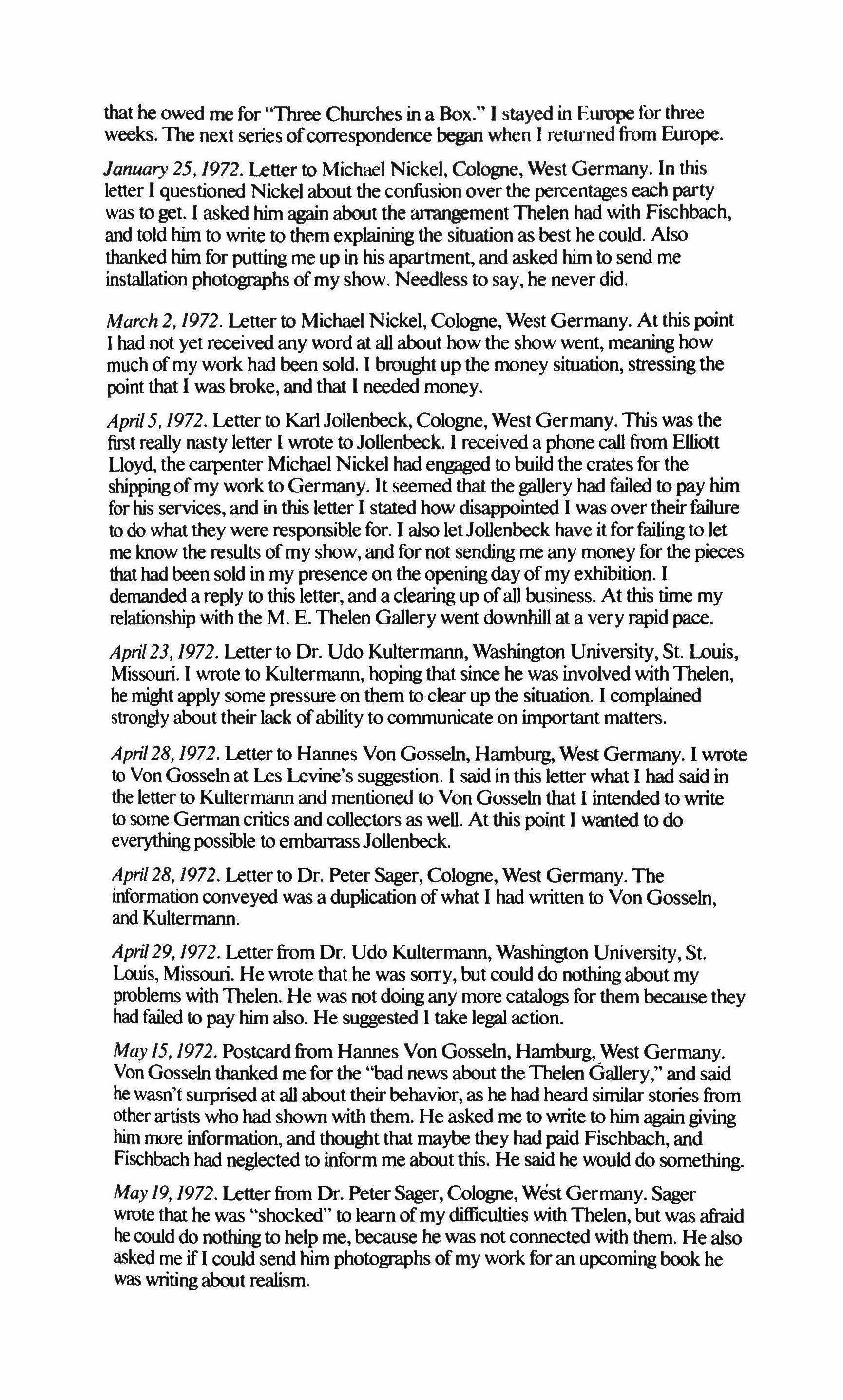
that he owed me for "Three Churches in a Box." I stayed in Europe for three weeks. The next series ofcorrespondence began when I returned from Europe.
January 25, /972. Letter to Michael Nickel, Cologne, West Germany. In this letter I questioned Nickel about the confusion over the percentages each party was to get. I asked him again about the arrangement Thelen had with Fischbach, and told him to write to them explaining the situation as best he could. Also thanked him for putting me up in his apartment, and asked him to send me installation photographs ofmy show. Needless to say, he never did.
March 2, /972. Letter to Michael Nickel, Cologne, West Germany. At this point I had not yet received any word at all about how the show went, meaning how much ofmy work had been sold. I brought up the money situation, stressing the point that I was broke, and that I needed money.
April5, /972. Letter to Karl Jollenbeck, Cologne, West Germany. This was the first really nasty letter I wrote to Jollenbeck. I received a phone call from Elliott Lloyd, the carpenter Michael Nickel had engaged to build the crates for the shippingofmy work to Germany. It seemed that the gallery had failed to pay him for his services, and in this letter I stated how disappointed I was over theirfailure to do what they were responsible for. I also let Jollenbeck have it forfailing to let me know the results ofmy show, and for not sending me any money for the pieces that had been sold in my presence on the openingday ofmy exhibition. I demanded a reply to this letter, and a clearing up ofall business. At this time my relationship with the M. E. Thelen Gallery went downhill at a very rapid pace.
April23, /972. Letter to Dr. Udo Kultermann, Washington University, St. Louis, Missouri. I wrote to Kultermann, hoping that since he was involved with Thelen, he might apply some pressure on them to clear up the situation. I complained strongly about their lack ofability to communicate on important matters.
April28, /972. Letter to Hannes Von Gosseln, Hamburg, West Germany. I wrote to Von Gosseln at Les Levine's suggestion. I said in this letter what I had said in the letter to Kultermann and mentioned to Von Gosseln that I intended to write to some German critics and collectors as well. At this point I wanted to do everythingpossible to embarrassJollenbeck.
April28, 1972. Letter to Dr. Peter Sager, Cologne, West Germany. The information conveyed was a duplication ofwhat I had written to Von Gosseln, and Kultermann.
April29, /972. Letterfrom Dr. Udo Kultermann, Washington University, St. Louis, Missouri. He wrote that he was sorry, but could do nothing about my problems with Thelen. He was not doing any more catalogs for them because they had failed to pay him also. He suggested I take legal action.
May /5,1972. Postcard from Hannes Von Gosseln, Hamburg, West Germany. Von Gosseln thanked me for the "bad news about the Thelen Gallery," and said he wasn't surprised at all about their behavior, as he had heard similar stories from otherartists who had shown with them. He asked me to write to him againgiving him more information, and thought that maybe they had paid Fischbach, and Fischbach had neglected to inform me about this. He said he would do something.
May 19, /972. Letter from Dr. Peter Sager, Cologne, West Germany. Sager wrote that he was "shocked" to learn ofmy difficulties with Thelen, but was afraid he could do nothing to help me, because he was not connected with them. He also asked me if I could send him photographs ofmy work for an upcoming book he was writing about realism.
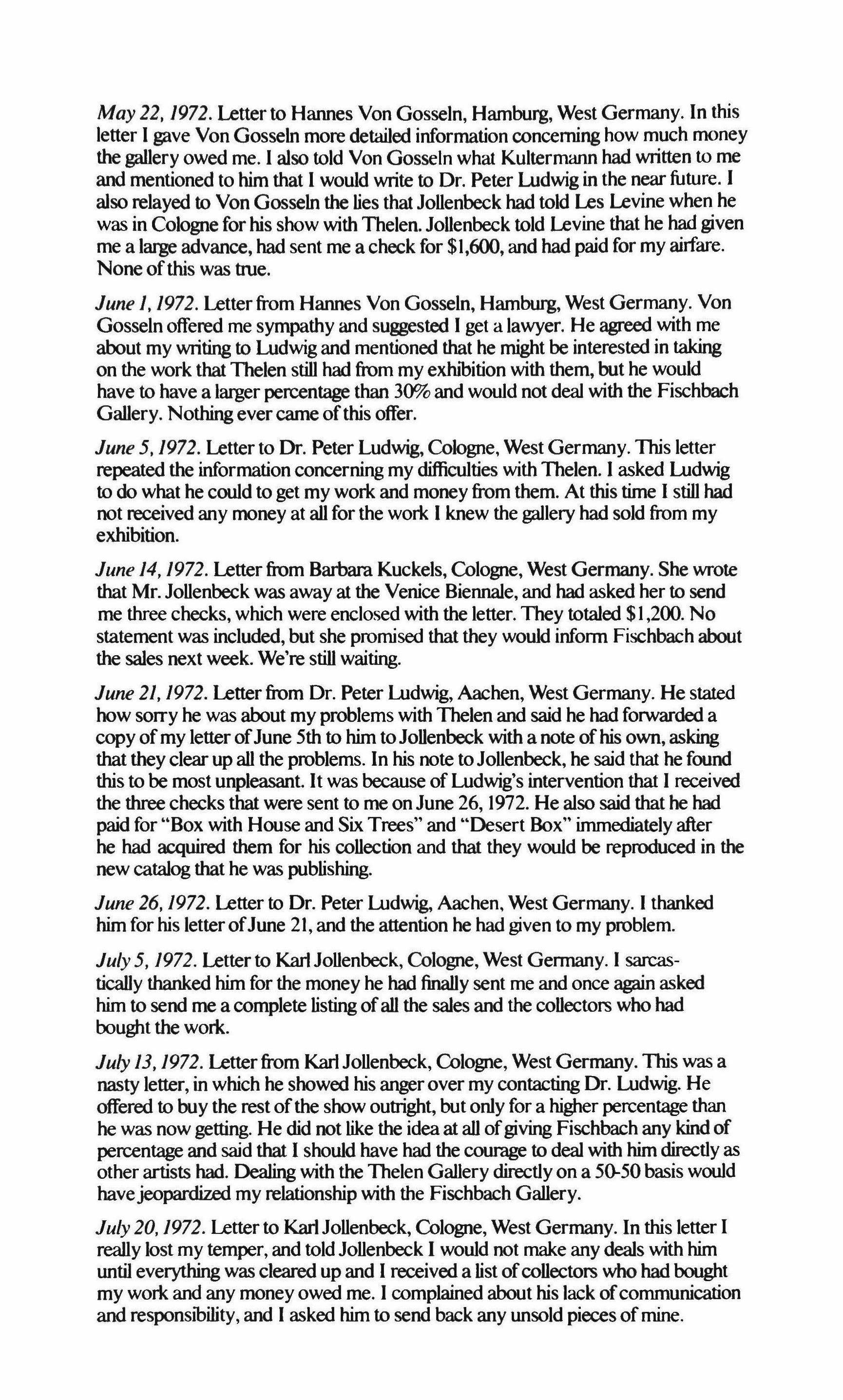
May 22, /972. Letter to Hannes Von Gosseln, Hamburg, West Germany. In this letter I gave Von Gosseln more detailed information concerning how much money the gallery owed me. I also told Von Gosseln what Kultermann had written to me and mentioned to him that I would write to Dr. Peter Ludwig in the near future. I also relayed to Von Gosseln the lies that Jollenbeck had told Les Levine when he was in Cologne for his show with Thelen. Jollenbeck told Levine that he had given me a large advance, had sent me a check for $1,600, and had paid for my airfare. None ofthis was true.
June /, /972. Letter from Hannes Von Gosseln, Hamburg, West Germany. Von Gosseln offered me sympathy and suggested I get a lawyer. He agreed with me about my writing to Ludwig and mentioned that he might be interested in taking on the work that Thelen still had from my exhibition with them, but he would have to have a larger percentage than 30% and would not deal with the Fischbach Gallery. Nothing ever came ofthis offer.
June 5, /972. Letter to Dr. Peter Ludwig, Cologne, West Germany. This letter repeated the information concerning my difficulties with Thelen. I asked Ludwig to do what he could to get my work and money from them. At this time I still had not received any money at all for the work I knew the gallery had sold from my exhibition.
June /4, /972. Letter from Barbara Kuckels, Cologne, West Germany. She wrote that Mr. Jollenbeck was away at the Venice Biennale, and had asked her to send me three checks, which were enclosed with the letter. They totaled $1,200. No statement was included, but she promised that they would inform Fischbach about the sales next week. We're still waiting.
June 2/, /972. Letter from Dr. Peter Ludwig, Aachen, West Germany. He stated how sorry he was about my problems with Thelen and said he had forwarded a copy ofmy letter ofJune 5th to him to Jollenbeck with a note ofhis own, asking that they clear up all the problems. In his note to Jollenbeck, he said that he found this to be most unpleasant. It was because of Ludwig's intervention that I received the three checks that were sent to me on June 26, 1972. He also said that he had paid for "Box with House and Six Trees" and "Desert Box" immediately after he had acquired them for his collection and that they would be reproduced in the new catalog that he was publishing.
June 26, /972. Letter to Dr. Peter Ludwig, Aachen, West Germany. I thanked him for his letterofJune 21, and the attention he had given to my problem.
July 5, /972. Letter to Karl Jollenbeck, Cologne, West Germany. I sarcastically thanked him for the money he had finally sent me and once again asked him to send me a complete listingofall the sales and the collectors who had bought the work.
July 13, 1972. Letter from Karl Jollenbeck, Cologne, West Germany. This was a nasty letter, in which he showed his anger over my contacting Dr. Ludwig. He offered to buy the rest ofthe show outright, but only for a higher percentage than he was now getting. He did not like the idea at all ofgiving Fischbach any kind of percentage and said that I should have had the courage to deal with him directly as other artists had. Dealing with the Thelen Gallery directly on a 50-50 basis would havejeopardized my relationship with the Fischbach Gallery.
July 20, /972. Letter to KarlJollenbeck, Cologne, West Germany. In this letter I really lost my temper, and told Jollenbeck I would not make any deals with him until everything was cleared up and I received a list ofcollectors who had bought my work and any money owed me. I complained about his lack ofcommunication and responsibility, and I asked him to send back any unsold pieces ofmine.

September29, 1972. Letter to Dr. Peter Ludwig, Aachen. West Germany. I told Ludwig that I never questioned his paying for the two pieces he had bought. contrary to whatJollenbeck had told him. I also enclosed copies ofthe letters of June 14th,July 13th, and July 20th to show him what kind ofpersonJollenbeck really was. I also thanked him for sending me the catalog from the Neue Galerie, which contained color reproductions of"Desert Box," and "Box with House and Six Trees."
October3,1972. Letter from Dr. Peter Ludwig, Aachen, West Germany. He thanked me for my letter ofSeptember 29th and stated that since he was not connected with the Thelen Gallery, he could do no more for me in clearing up my problems with them. He assured me that he was most happy about the two pieces ofmine that he had bought.'
November 17, 1972. Letter from Michael Nickel, Cologne, West Germany. A short note with a check for $400 and the promise ofa statement next week. I'm still waiting.
January 15, 1973. Letter to Michael Nickel, Cologne, West Germany. I thanked him for his note and check ofNovember 17th but expressed disappointment over not getting a longer letter explaining the situation. Once again I expressed a desire that all business be cleared up.
April 13, 1973. Letter to D. Thomas Longo, Jr., American Consul, Dusseldorf, West Germany. This letter contained a concise explanation ofmy problems with the M. E. Thelen Gallery. I inquired ifthe American government might throw some pressure and light on the situation.
June 15,1973. Letter from D. Thomas Longo,Jr., American Consul, Dusseldorf, West Germany. He apologized for the delay in answering my letter, and told me that he had written to Jollenbeck about my situation, butJollenbeck had not answered his letter. His office also tried in vain to reachJollenbeck by telephone, butJollenbeck, in keeping with his rotten behavior, did not return the call. He suggested I contact a lawyer and was enclosing a list oflawyers practicing in the Dusseldorf area for me to pick from. Unfortunately, he forgot to enclose the list with his letter.
July 12,1973. Letterto D. Thomas Longo,Jr., American Consul, Dusseldorf, West Germany. I requested the list oflawyers he mentioned in his letter ofJune 15th.
July 17,1973. Letter from D. Thomas Longo,Jr., American Consul, Dusseldorf, West Germany. He asked me to please accept his regrets for omitting the list of lawyers he had mentioned in his letter ofJune 15th.
December28,1973. Letter to Dr. Klaus Hennig, Essen, West Germany. Please see introduction.
January 8, 1974. Letter from Dr. Klaus Hennig, Essen, West Germany. This letter was in German, so I sent it to my friends Lil Picard and Henry Odell who kindly translated it for me. The amount ofmoney that Dr. Hennig requested for representing me was not within my means, so I could not take legal action against Jollenbeck at this time.
January 8,1974. Letter to KarlJollenbeck, Cologne, West Germany. I asked him once again to return any work that was unsold, and to pay me any money he owed me. As oftoday, February 20, 1974, this letter remains unanswered.
[Ira Joel Haber]
Photographof� works
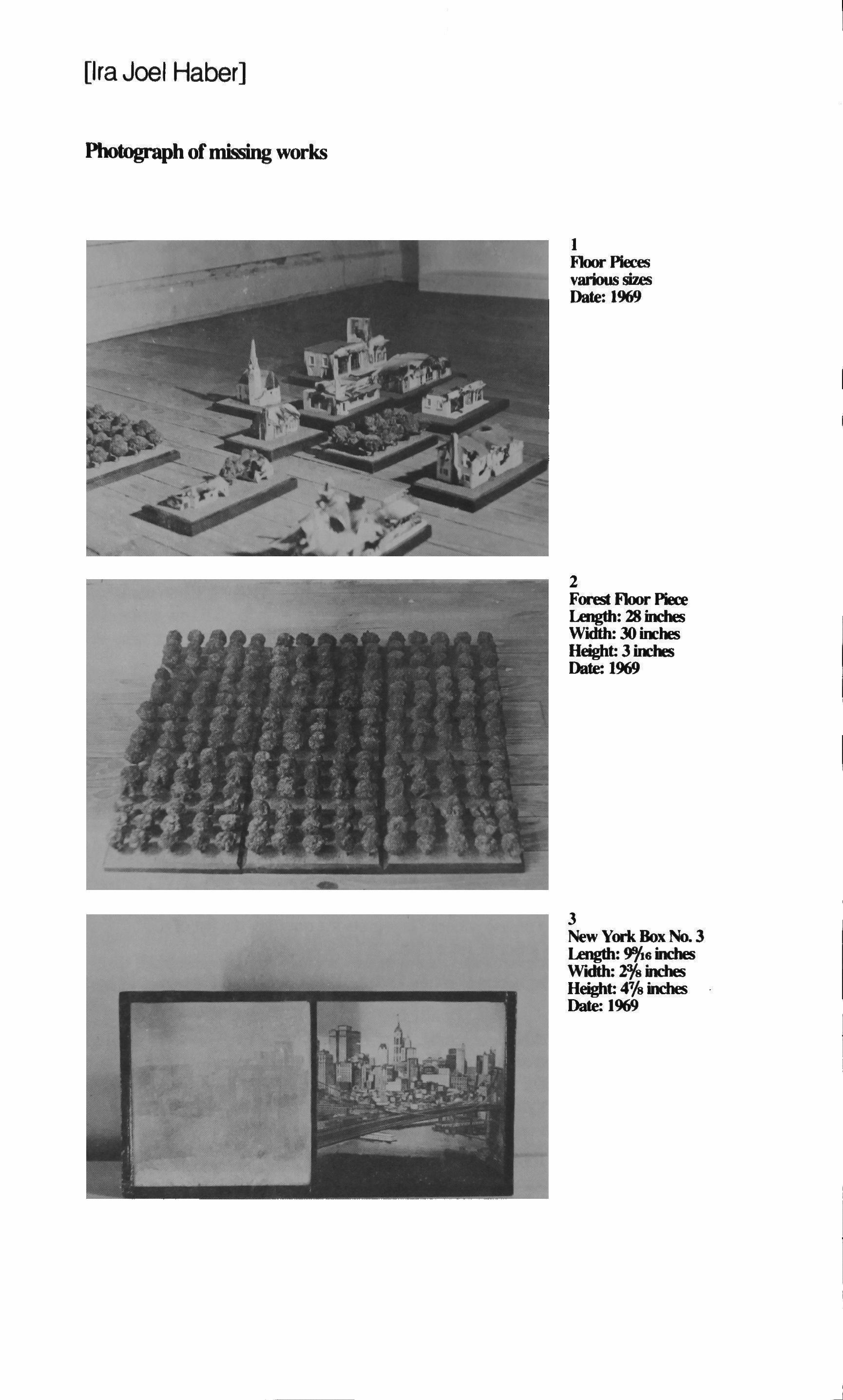
I Floor PIeces
various sizes
Date: 1969
2
FOI'fSt Floor Piece
I..mgth: 28 inches
Width: 30 inches
Height: 3 inches
Date: 1969
3
New York Box No. 3
I..mgth: 9%6 inches
Width: 2o/s inches
Height: 4% inches
Date: 1969
[Ira Joel Haber]

PHOTOGRAPH NOT AVAILABLE
4
New York Box No.4
Length: 15 inches
Width: 3%6 inches
Height: 3 inchei
Date: 1970
5 Forest Box
Length: 12%6 inchei
Width 2%6 inchei
Height: 51/4 inchei
Date: 1970
(I
Open Box No. I
Length: II '/4 inches
WIdth: 7 inches
Height: 71/4 inches
Date: 1970
7
Small Box with 1'hnle
Trees and a Lake
Length: 7 inches
WIdth: 4% inches
Height: 5 inches
Date: 1970
[Ira Joel Haber]
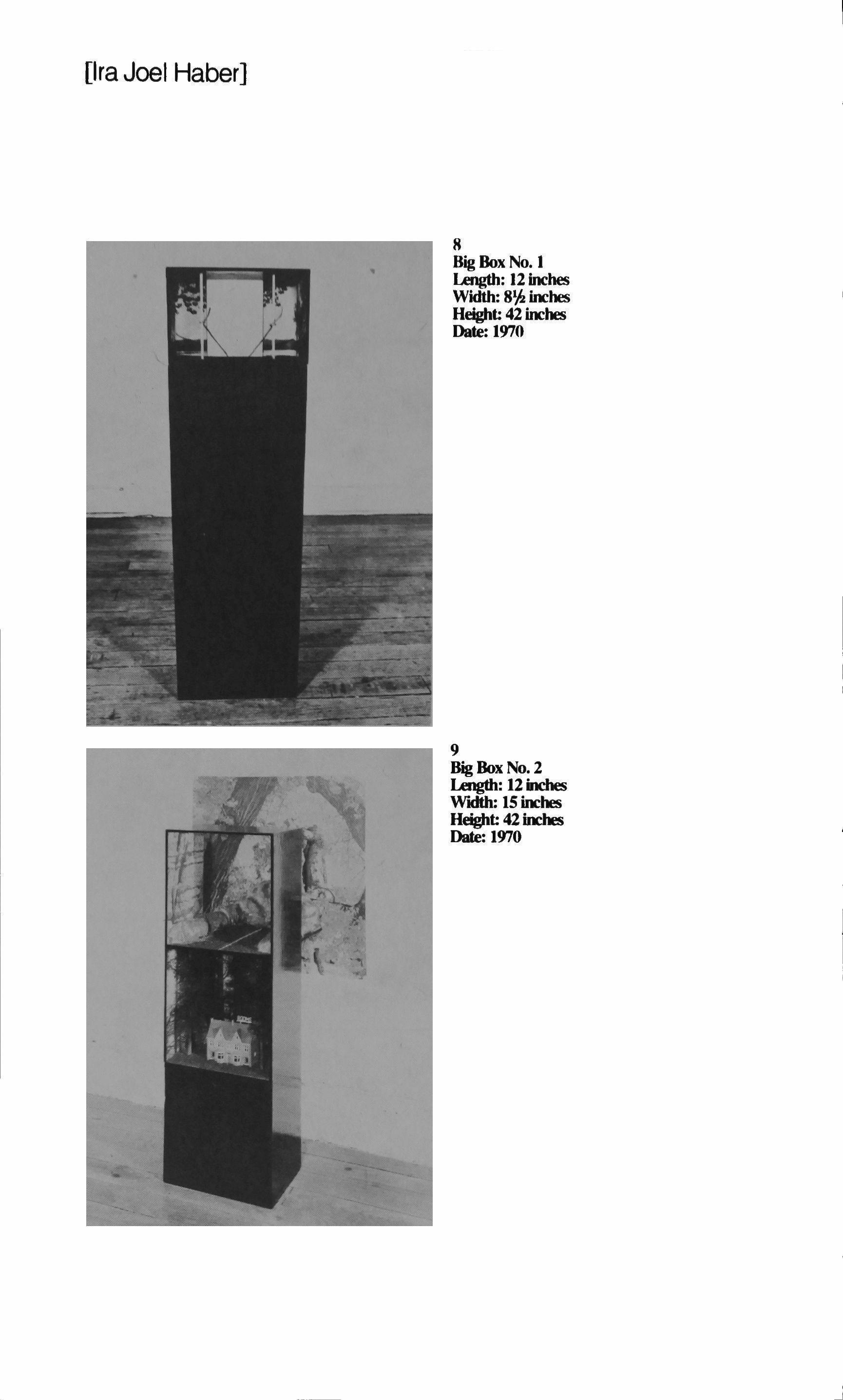
II
Big 80x No. I
Length: 12 Inches
Width: 8� inches
Height: 42 inches
Date: 1970
9
Big80x No. 2
Length: 12 inches
Width: IS inches
Height:42lnches
Date: 1970
[Ira Joel Haber]

10
Open Box No.6
Length: 11� inches
Width: 7� inches
Height:5incbes
Date: 1971
PHOTOGRAPH NOT AVAILABLE
11
Open Box No.8
Length: 19 inches
WKlth: 51fo inches
Height: 7 inches
Date: 1971
12
UntidedBox
Length: 22 inches
Width: 91/4 inches
Height: 2()Ifi.6 inches
Date: 1971
PHOTOGRAPH NOT AVAILABLE
[Ira Joel Haber]

13
White Hou!le and Forest in a Box
L81gdt: 7 ft:Iws
Width: 4% inchrs
Height: 5 inches
Date: 1971
14
47AJrV��ofF�
Length: 43 inchrs
Width: 30 inchrs
Date: 1971

Lawrence Weiner
On and/or about the variability of use:
1. The artist may construct the piece
2. The piece may be fabricated
3. The piece need not be built
Each being equal and consistent with the intent ofthe artist the decision as to condition rests with the receiver upon the occasion ofreceivership
Weiner]

With relation to the various manners with various things:
Loudly made noise (forte) and/or Moderately loudly (mezzoforte)
Softly made noise (piano) and/or Moderately softly (mezzopiano)
Noise made very loudly (fortissimo) and/or Moderately loudly (mezzoforte)
Noise made very softly (pianissimo) and/or Moderately softly (mezzopiano)
[Lawrence
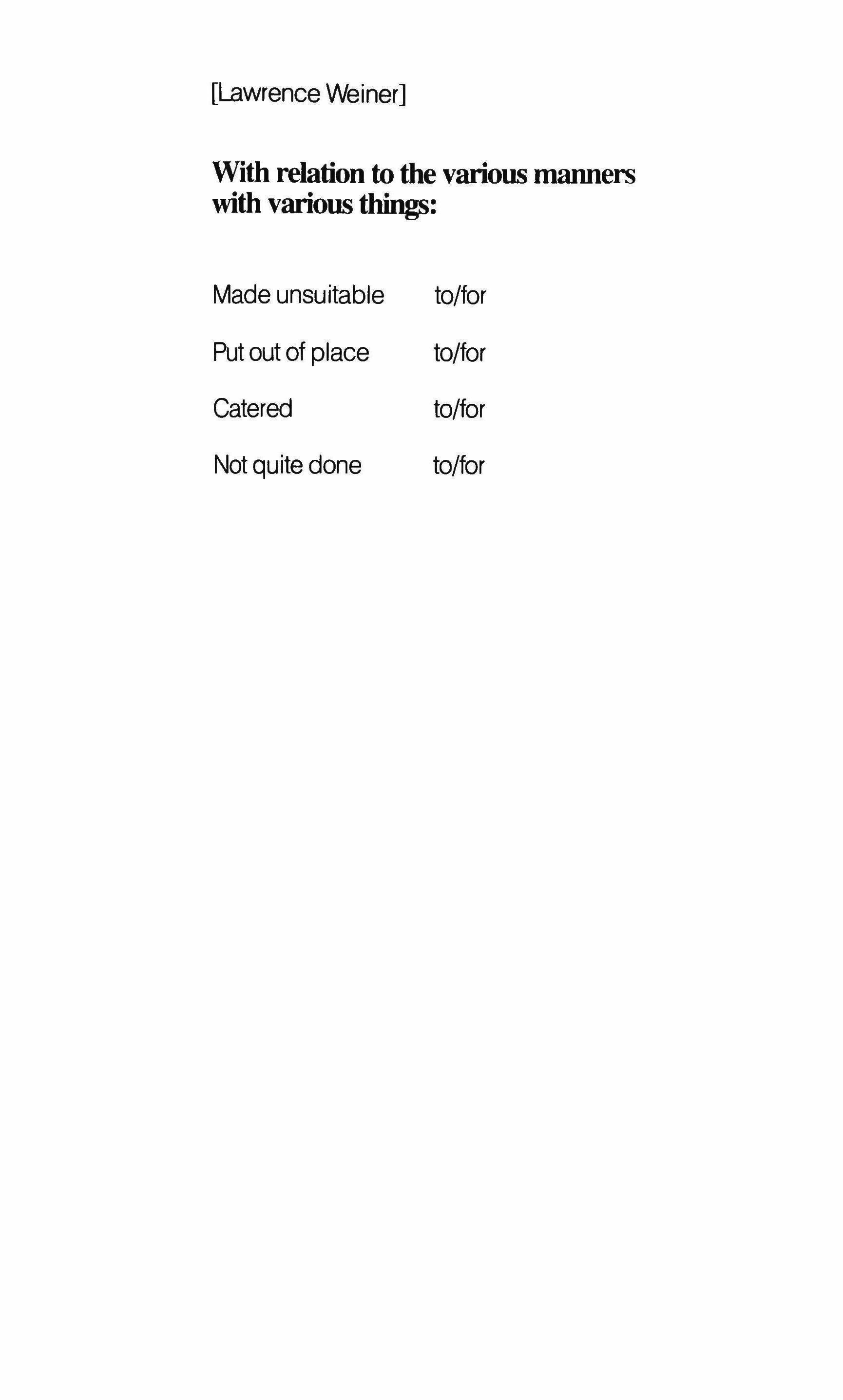
[Lawrence Weiner]
With relation to the various manners with various things:
Made unsuitable to/for
Put out of place to/for
Catered to/for
Not quite done to/for

[Lawrence Weiner]
With relation to the various manners of use for/ofvarious things:
Having had leverage forlof (with or without direction)
Having had advancement forlof (with or without direction)
Having had direction (with or without )
[Lawrence Weiner]
In the event of an art existing within a cultural context:

1. An artist may construct the art
2. The art may be fabricated
3. The art need not be constructed
Each being equal and consistent with the condition ofart the decision as to condition is not
Joseph 8euys
I like America and America likes me
8euys felt (saw nothing of) America. On arrival he was insulated in felt and delivered by ambulance to the space in which the performance is now taking place. For three days he is sharing this space with a coyote.

Then they will both return from whence they came, Beuys by Red Cross, the coyote by Blue Cross.
[Joseph 8euys]
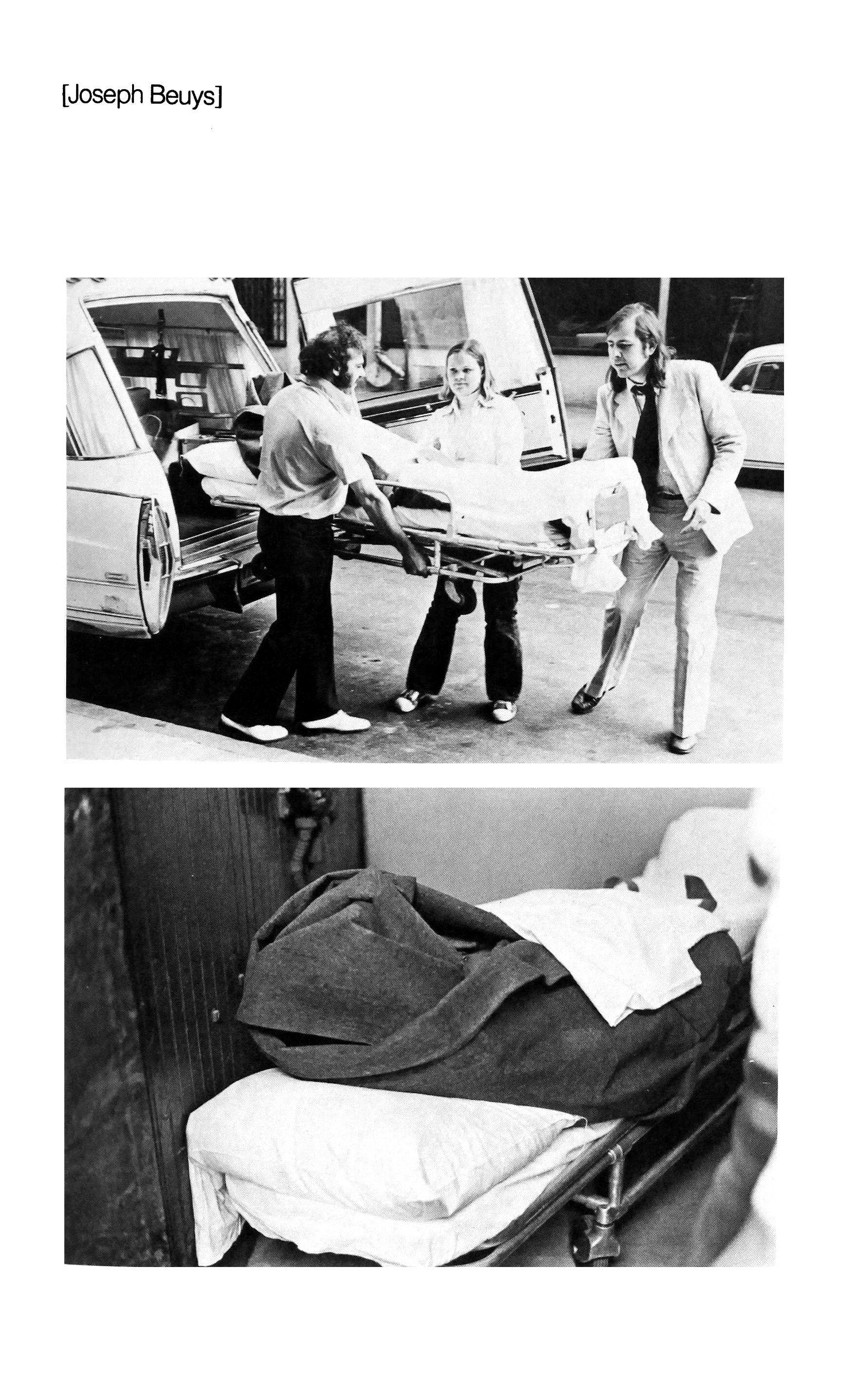 [Joseph Beuys]
[Joseph Beuys]
 [Joseph 8euys]
[Joseph 8euys]
 [Joseph Beuys]
[Joseph Beuys]
 [Joseph Beuys]
[Joseph Beuys]
 [Joseph Beuys]
[Joseph Beuys]
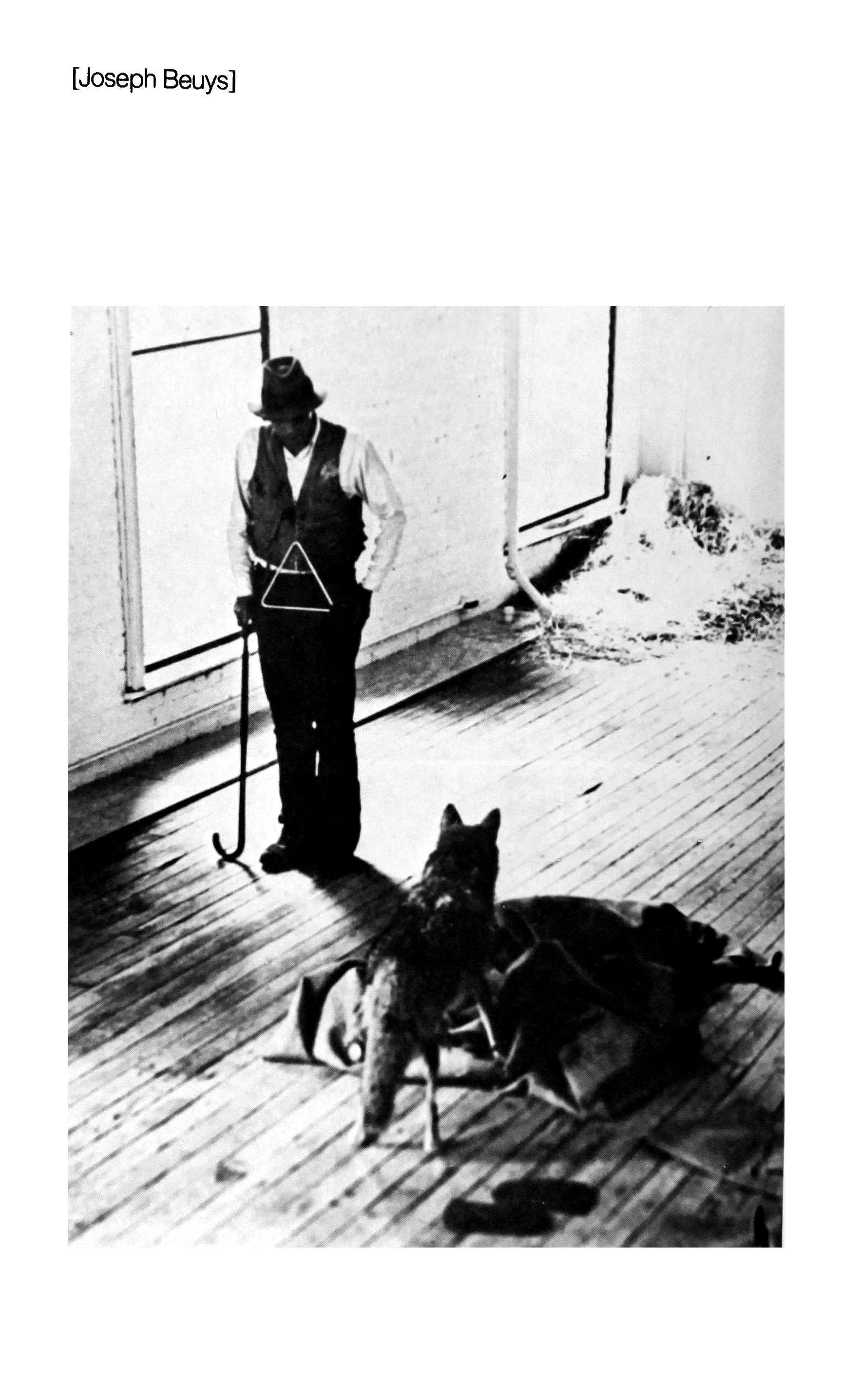
Christo
Running fence
Project for Sonoma County and Marin County, State of California
Height: 18 feet; length: 20 mlles

The "Running Fence," a temporary work of art, will be 18 feet high and about 20 miles long, emerging from the ocean and following an undulating path inland. Its route and configuration have been selected so that natural beauty and that of the art work wiII complement each other.
The Running Fence will be of heavy, white nylon fabric, hung from a steel cable strung between steel poles. The poles, generally 60 feet apart, will be embedded three feet in the ground and braced laterally with guy wires and earth (or rock) anchors. The lower edge of the fabric will be anchored to the ground at about five-foot intervals.
Construction of the Running Fence will be a two-phase operation. Phase I, installation of the relatively inconspicuous structural partspoles, guys, anchors and upper cable-will take about four months. In this stage, great care will be exercised to avoid environmental damage.
Phase II, installation and tie-down of the entire 20 miles of fabric, is planned to take place in one day! This will be possible by using many trained two- or three-person crews and assigning each crew its own, reasonably short length of the project. Their work will be to clip the fabric panels to the cable, spread them, tie them down at the bottom and lace them to the poles.
A safety feature of the Running Fence will be "fused" tie-downs, designed to break and release the lower edge of the fabric in the event of winds exceeding 50 or 60 miles per hour. With only its upper edge attached, the fabric will then "spill" the wind and avoid damage to the poles, guys and anchorages. With return to lower wind speeds, the lower edge can be tied down again. All parts of the structure (except possibly for parts actually embedded and concealed in rock) are being designed for complete removal. Again, great care will be taken with removal so that no visible evidence of the Running Fence should remain. According to plan, the Running Fence will be displayed for not over four weeks.
Ernest C. Harris, PhD, P.E. SeniorStaffEngineer
The Ken R. White Company January 10,1974

[Christo]

[Christo]

[Christo]
CCIIIIIIIlutle sheet. for stability .04 atrenvth of MIRe l aYlt_ ot Chrhto'. Runninq renc. ..-.r ca\lllng 20 pd reaulunt torc. Oft f1at nlcal ."rhe
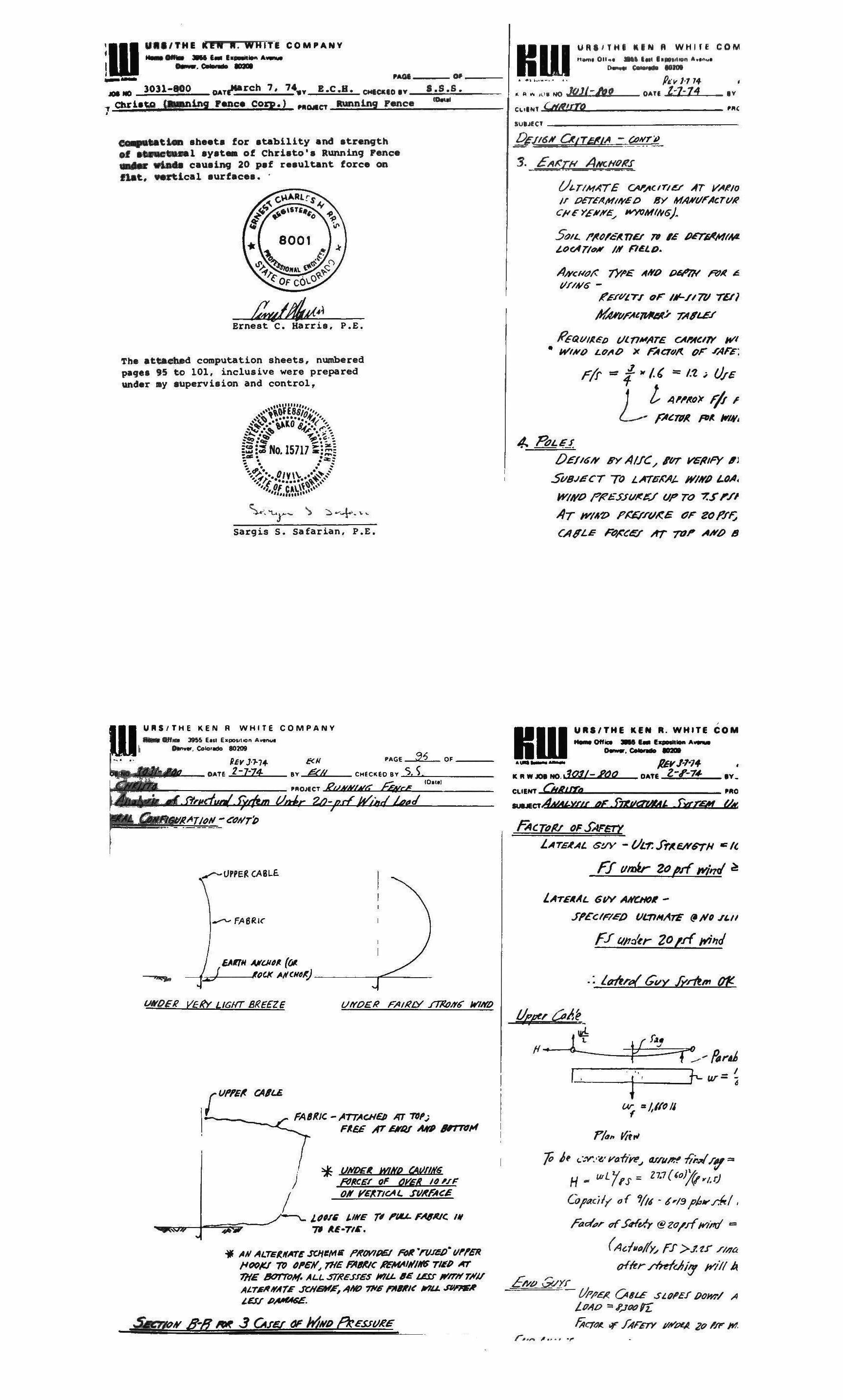 Ernest C. Harrie, P.E.
Ernest C. Harrie, P.E.
The at.tacUd computation sheets, numbered paCl.' 95 t.o 101, inclusive were prepared under .y lupervilion and control,
1!FJl6K UITVIA -. � 3, EAt:U'{ ANCHflRf (./�TIM-<TE CAI',;tClTIY AT V;tf�/O If IAfTEA/ffIIYED BY MANt/"'f'7V� q"EY,cK"'£_,. W"I'rJMtN6)�
Sal£. I'JfQ,clf.T1£J' " 1£ �{M. t,.O&#TI(# Ilf n�I.D. /lIYCf.ld� 7)'1'£ AND P6I'lN fill � 1IJ'/A/6'�J'l/lTJ Or 1#-/171/ orUI #AlilrA'''''''''.} TA'u:r
REQVt�ED I/ln.tllAT£ CA'A�/1Y IV' WINQ LQI'IO )( FACTO/( (IF" fATE;
s."'Y_ '> :;,-+,,, Sargis S. safarian. P.E.
I/.. PoLEJ. ----:o£/t6N 8Y Auc/ ,f(ff VEIIII')' IJ SUBJECT TO LATIi,('At. WIIYD LIhf. WIIYO PI<'£.5'flJ/t/if 01' 70 7.$"f' AT WI''!> P/$FfO,t:E dF eof'fF; CAITLE R�C� AT 711" ANO B
URS/THE KEN R WHITE COMPANY _IIH_ lIHhuh_t.,,,A_ I """.<:010 10208 "V)'1-7+ E<N
1m
URltTHE KEN R. WHITE COM _orr e.,... A_ .,_.� �J.'"1f. C.RWJOINO.'1Q,Z/-Rt2q oAn�.Y_ CLIeNT C"",rrl' _CT 4tH! WI( 9£ f'1TEJqrNd'L rY"'Y' PA' Rlq�flj OF fAFETY LAT/UAL S!IY - (/Lr.frJt.EHGTH CIt Ff IJmV ZO "n m",! � LAT£�AL GW ANt::NtJ1fl'£CIF1ED VL'T1NATE @"� J'"
((II. ---.:0", �()f.I(""(N'X) UNOER VERy L/GIfT Sf<E£ZE
Ue""UM_ 1'I' I ( �.L___ Ii---=F==r>/'.Y,; , f "- W= � "f '1,11011 1'/ ",;� 70 J, c :.:Y'.'"6'YofiYf?., tIJ/II�fiiw'/V=H - wLYn Z7.7(,ol!v",d COf"cil1' or '!I, '�'191'j,,...r.fd, .Fa""",. urs"rufy @zopf""W(Ad.';(y, rr >,7.<.1' fIll" oHw.m.fdJi(! It'ill A ElVod./yr tippo aWE SUPEr 00",,/ A LPAP =J',.JfKJIL FACTtN. ., fArETY V#'P4f. 20 //1" Itt. r ".,"
'10
IIUI URI'T"_ KIN A WHiff COM _.0 I" I c.-.. 0- c-o.:...._ ,AGI """w_.' P�vl'174 ..:11
DAT�rch 7. 7�" I C.B. a4caIClI" '.S.s. �"''''Jll.''fO ltJJI-hp OAU�''( '] CIlC'iat.Q
1 C""I"'l <glCm
U' /THE "EN N. WRITI COM'ANV
30U-100
lM,nin9 Pence cog_) ,.oaC'T -'''''''=::;Dlmi=...:Fc.:''''::;e:.:"=---
E��
PAGe ___,2i__ OF IuIi"'-_ OATe � BY� CHECN.EO 8Y_S"-.!..' WE 10.1.,
EA"H
AN
11"0 ''''''/tJ 77J ""If, THE fiI/WC I!flMAIN'11IIS TIED "" 1'HE 6O'I"'fDH. ALL. STIiEJrES Jt11i.L 6£ LUi" II'nHr.llV At.TIlfIlArE .kHB'" AMJ �6 /?fI81t' nu. .J'W1I6A J.£fJP�. Sez..:,,,- B-R - .J CU£( dF MND ftE.£JIJRE
J..---UPPERCA.LE _QI FA8RIC
AIIlJi'�
ALTE�I(Ar6 .stII'"". f71(QYla5/ FdIt .1'1IJI!O"
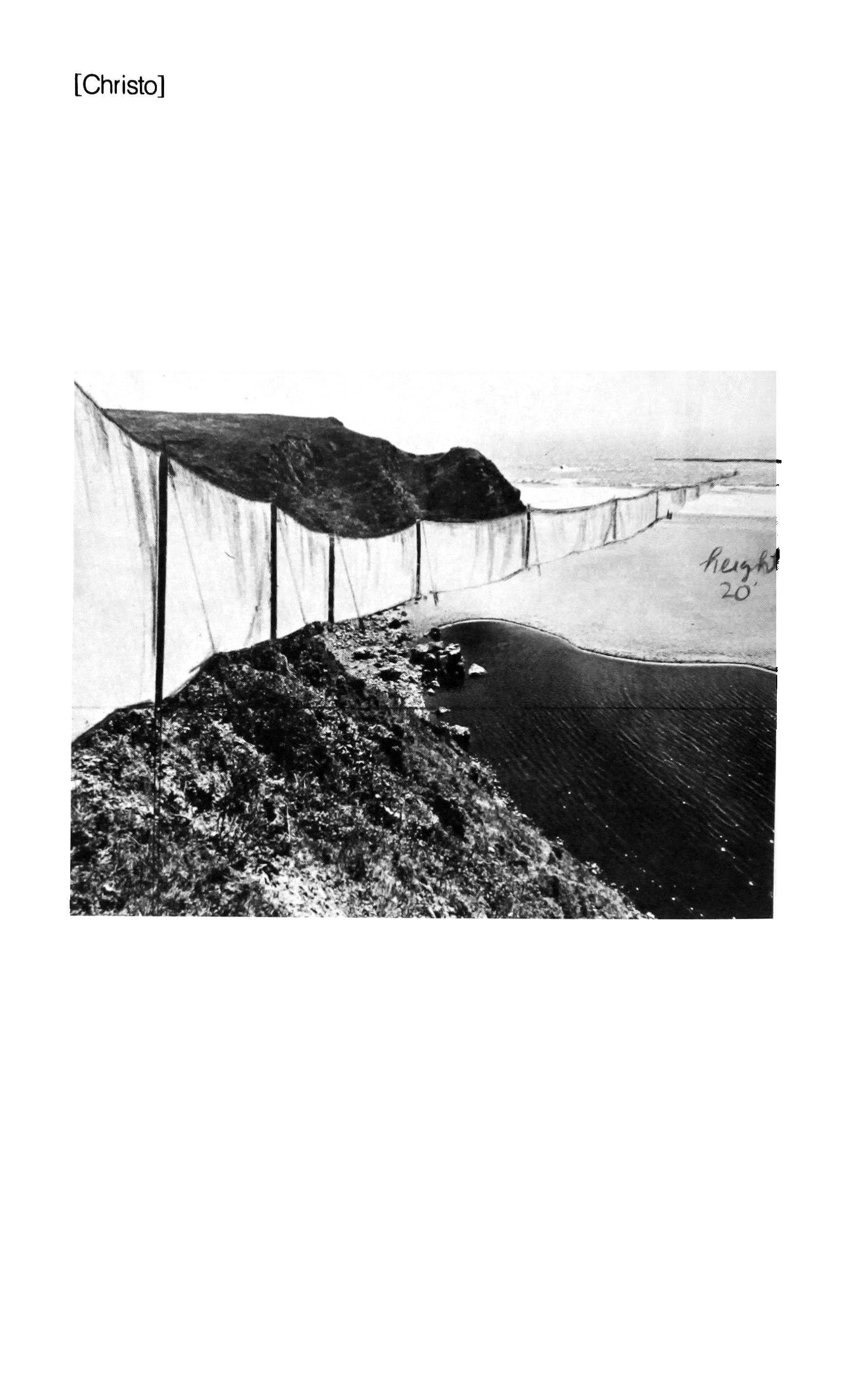
[Christo]
0 DATJ!rch 7, 7�Y�CHICIt'O.Y 8.8.8.
1 Clu:'i.to tMni.nt Fence corp.) 'IllOAICT-'Run=n"'in?",._..!V_,en"'c"'.'--
C'DIIIIJlIUotatlon .heet. for .tabll1ty and .tren9th of eU\acwral system of Chrhto'. Running Fence un r wind. co.ueing 20 paf re8ultant fore. on flat, vertical surtacee.
Erneat C. HBrr1.8. P.B.
Th. attached computation sheets. numbered lMge. 95 to 101. inclusive prepared wuler ray 8upervisl.on and control,
sargis S. Safarian, P.E.
rA�RIC-/tTTACHEp I(TTD,; nu AT EJrIV �'"'
'* UNP£1t !!?Hb (AIIUK" RMEI' ('JF t1YE6 J(J '-I'� 0# l"£t7lcAl.. fll�f"AC� J."/� LIKE T'I,IA.L. FA6�C. III ." AE"TI&. ,AN ALTEI!./(ATE SCltt:M16 PNOYIP6/ RJR "nJJUJ" fI�'ER. I'fJO/(J -m 4Pc/(,]'7{E FlI&fJc 1'£_111"" TIED 7}lE M'fTOH- ALL .sr�EJrES JI'ILL 1£ lLU wnw rllU Ai.rPIIATE .JrH6tf$, AM? 1'1'6 J?fU/� /II1lI..J'W1IIIM t.£.FE p;f,HM£. 1ewe'" ItR :J
lIoNfINAL JJW:IK6 �Q!O" (Cz.'..()'·/MX.; LEff THAN GtJ!()" WH��E I(EQ'/) SY TF�A� T{//(NS OR (/!1.JT/(VCTI()NJ) A -+ 54 (KaT 1'0/ £A�TH I'M'(W/( < (.� u,,, M(IMtJ
3 f-PI",J7D.,/ll.ACI( 6''(41..8'/ /Qt/AR.£ (/lOIlM)) WHO HI-de/(/ IH,"7"k.;t:.
SECTION' A-A
DEI/oN QlrEl!lA ! /11/10 zy"CiU
A. A', ST.fVCTvl?£ WITH rA8/(Jc II{ PLA<.£, AllotO�EP .AT fJurnJM Ah'D trea r, /1:II..E/ AT EACH E/YP* 7..> LB //rl FT 0"- Vtl/TI(Al !'RaJ, .13. 0", n/(PCTU,(E WIT# F'''lff(IC I� I'tA(E. /WoIo;;sD AT 80T/(7ty/ 8t/T T/lEE AT" �At:fI ,EqiJ}fJl; IP U/rU rr (IF Vqrl(�' P1(a7E<Tld C ON .J7i'!tlCTV/lE ,.,17# rAlR/C H£IJ) KY VI'I'E� SXE 'W'LY £N/).f M£l PtlTT()M £1)6t;/' r�20 L.If/nfi rr (IF VElrTI'AL """'IitT'''''
)If /VJEP '/'111.£ TIP IVILL Ifjt£AK AT I',uPtA<U » ;UpoF -+ � "Ft!/£I)' BCT71>i>1 77"-_ a/!p' WilL 8RlIAK AT P'Er.J'VAV > /P prf".
2, f'&NCIPLE OF 'rof6l>CPKNfIiTIglff_ FABRIC S'17?E/{GTH Sf'(JUJ.D BE' CO/f7RoLi...JNG f'AC7b1( IF TIE-OOWW
BKGA/f AWA: Al.U1I¥"IN6 'AI/tit:. 7lJ Fl.Y "E�. 7it// fP/4J" "71f£ WIfP/ ,l!t:PVC/,ff6

;W U'UITHE
1-_ __,c-.to
'UN fl. WHITE CO 'ANY E
'''01 0'
';'\a'll'iGio�', e
, :>-+-,,
s.., ,r-
UNDER
UNDER
WINO
Irf
D
Ytfg OF MND eUSfVKE INmAL _-I;" 06TAIt C, �
VERY JlGIff B/(ECZE
FAJlUY.f11IDIf{j
VPnI,( CAlLE
�----�-----��-.��---1��---..._:---t_
PoLi. 'I - )! J /L POLIO TIEJ, Sli To B/(EAK WH WIND f'REt/UU. ].5 T' I. p/f DOTAl" C
JV61I6 DEr/SK£D r» II'/TH.r1'AA'D ZO '/1' WI/yD. 7lJ I'A07ECT FAIIlIC.J �- TIEJ Aft'D T/£·Powp
THIF klAD aY .nRVCWA';4L J"f4+fIBll' P AILO#t.T TH£J4 7lI ./lMYI/lG MIlCH .f7X'HU1/ /fIJNtV WI71ItJV7 PUlA6£. Mrll �£Tv/tN u"",a jYlMJ Y'B«/ rr, 1'l46�1C £06G A,w 6¥TTIJIM 711 ow IE R4I'J.Aao NO mE PI/liAr' ;('UV14= &� .raE IN' FWEO �,II' 1/ AmSWIRP '" LAI', 7E/T ,.,0 vq(fI7J!1) sr WE "" 1'lAlk-.J1:#E !'/(Q,.rw£ r.ur (1",--. (THE AlTEl1l1ATFsm_ 1J/'-1'IIJe UI''''''INOA::r, TNAt'�." ""_,,,, "",. -"""." ""I-�<:'��"''' ".,... _,."... "�"_.'"'' �.,. fl''IIIVrr.ll <)1'
ANCHfJA'.f
t.JI.TIMAI£ �ft(l"IU AT jI',lfJ'I(JI,U &¥n-/'{/ AN,O 1# ¥')4�/IItJI /t1JU Ii' t¥"!'£"MI4"6D 6Y MAKI/"Acrt)�6�:r TUT. (,.,,�£rI6NT /,yl)Uf7�/U. CJlE Y[K'¥E.,. WYOM/1I6). 'j
»L I'''NIi''T1£r 16 �/I;ITD W "'-/1111 TEl' AT "'0' TY,£ �o&lrl"" /11 ':UlD.
Ao.-........ 1}t*£ M> .'OM,,;,kH u""r_ J¥N.' etC Jr,,,,,_ 1I/,N6'UO'JTJ "r 1A'-/I71/ TUt� �F"'_f"",1.U
RElitIlIXt!J) Vll1MArE CAlHalY 1Yfl.i. M CIJ�I'''''&./) MA¥'IMflM ""'N/) L�AD :x FACTtN'( OF' /AFEry" IYNEts
Fir I· U - I.t ) 0. /,1 ""wr #�O, 1 l "1'1''''; rJ � fE"....,£,¥7 'o,AO(AI.tr,NXI (_�- ",elM /W. _11 (J1I4'T.TH;< Jo,4DllO'§!
4. PHL£.]
OSl6N IYAffC,"'" WlfIl'Y I� ''''rnY� � SVtul'CT 71) LAT6�1ft. JIliN/) L0,4P F/(DM 1'''6,('1(' DIY'Y RM ,..,"'" f'l('liSJU¥<J:;/ ro 7..$'/',for ""It'D rt:£tnl�E t?F ecl'fF; � v �_/) ""',� .'. Ii'Y CAtTLE �C<!(f AT ."" AND 8>' J4""{I'P iJN I'>/.E A"."E.
U /THE KEN WHITE COMPANY �-- -�I "'o....c-byJ':"74 litll ,.AGI..l!!!..._O.
1Qt1- Mq DAn � .,..A:/l..__ CHICK.O ev juan y",,,.. rttMCT ed_f. r., to.-t ...-cr 4tH, Y''' «f"lJ'lt'Q7Ntf' r.".rpr UAf' Zq I'ff Jr'I' WI In.e
UTUAL $VY - tkr..f"f1fO/YGTH ·!tJ,IJ(JOIJ, mi•. '-1" vmir to{II"( ttiml ,l: 'fffr -", r ", m.,. II 4" LAU"", fill>' �f,£etl'U]J /JI:T>,."," • /(' J'" - I" IJ Ff lIfl,'tr 20,fffIIi"" � � .1.5" mil'. 'If rIC
WI" dc(� tWDEN 1f)f. FIVE ,4LTtlNATE
1'/ y""
JO J# �:'''Y"''I.·nJ"li".r (l//II� fi;"'//�;::;a in/Ii,!/" - J.!" H ",LYn lZ7(,·J/fj".r) # �;". M
CaFC;!( or 1ft, �'19I't-.riel "'"' hl',f'rffl>''''''/ -IJ.f" irA'
,Fdc/"r qfS"rd,. @Zf1/nl<'lW - 7,:,v-' - J. t, <11! .tf (Ad ,(y, Ff »rer .rl"'�Ii',..;.r" ",..HI" 1M In( (li"r .mddJl5' /1"111"';> 15: A/ 4//l/metI)
{jPPE.R (;AILE Si..tlPd J)(nw/ AT 4$" '(lJ rllht ,EK/) 6(/Y. Lp-fO ",,.roon:
!Aero< ". f¥47Y ;"-_ 2P 'JF M}-p If � ;t.3 .5.)1.(" II
Mn,/ F""�lJf ZlJ./rfI'lP!.tI".t ,?n I'tmr./ 1'1.1 /Wf,ul W; -<';iA t. c;, =a.as •• f rJ 6It if f. "l'fr�l"nrll' I1#I,tfr/IU,1 Zo,/( # 't (0,3 + M)·I.' { ; r' ZI7/!J (AIU) : � t: 17.1 ('''',,/lzoll.J) e ',6617 1/7 11< t.I(;_. wit>:! M 117'8( 'Ii,,, win roj'( 2tJ(I(w,o'. d,1J4-1'.,t!..-.... - 34- Ii (('�"r (.r cy/","rrQ/.rh.",)} II{, JYI'N ,,� J/'l''fJediolt 4f �J"?'.r
If zov'S'If4.J,'"O.ltJ F, e p/2 '" � 11 II.
SO/VI avy forcr "/>(I' ",,(/oIJr I,"" F.i By E� =0-
_1f.riIfJP"'!J "1'r:;�/(JF,_ ·1'''�lIZ flO. 71 =.JJ,tlG If:_ JJ, t"/(0.(/5WI9) �84-iJ IJ ;f WiT" 7"Io'E ACT6K"T�.f)(/78I, 71(£ TtlI' �CE. Fi, If REI>I)CI5P ,/JII:£ 'THE /?IRHIC If #4 J.tJN6L1t r'fTTAcH£1J 1111'/tt£ tJII'U e;uLI.(IE�fIIj.O)
HWU".ITHE lEN II, W"ITE COMPANY
l)III'_ laIll .,._.,� .6)1 ,..'-74 EUI ",_...HL__ ,," .GINO !zr/-'" 0AT1.£L::H...._.,.�0CICID..,� CLI''" CHllm I'fIOoIICT l'11W!!!f F##rI to.. -..eT A¥«,w" " {71fIrTtNL.JiqE« u..., en.". 1tI}. Lee fbL' fT(lEIf'tt711 '- Ai/vi. , netn,II!IJtn(,f1lY W=!)w./r =.eu'j -,- �I!tI,oy 1,,1 8,J1I1I,....-,_Cn1,..f· II!! #""1',10" � IIJ f1·�
F.r 3irs*il'i;e, A·U'M.�S:-.21' iA.' ro/�", r. I.)HI,.., �1fJ01"i L/r- /Z"'I,//.14 -170 Fa ·1-;;-�� ���9OfP" f= aer F. I .·/lAAiK""u..;, f.-I"IIS /U, =IYI'" c.. -I,' ."·.s;f70pi Ii,"" n,OPl/./--
l!.. c:..r. =IMS+ {.I·1ft F, (1- �JF, (i ]ff:)2> j ,),. .: {l#L£
�'\��HGTN AN" fT"SILrrY ()FJ11NCT(I'hS>?"TE"kl O POI 201'.17' ""flP II'I7"H "'6�:C CDK/I'ECTEP AT 1"0<' t F'tJJ1W C')NNEcnoKf ALL (JI'&/IEo. (EIIIW 6£nU HD./)AT8t?TTIH

11m
CO�PAN'f
�lt§
UIUITHE KEN A WHITE
011... �,ti h ,' � "�111"" Dtn .,co",.IdoIOJOf "'''''''-''' P�'f'H·7. �11 �AGI�:! _0' lll; JOt...a 1q.11-A29 g,Af, .1.:2:1.J__ ...L5:Ji._ C"'ICKfO IY _..._'!I,IINT 'if«trl'l! '1"(IIIC' �p",",..tttf"'L..Lf}!II.fN"'L' !UIJEC'
U(TVIA - �� ? EAI('_TH
IIW
[bOhY'
J
A.·AVQ�.rr7 2. PE'<'FO�!/�NCE OF FVf6"Q ClJNNE'C7"IIJP.r HAf /1£EN YdIFIt:1J J. f;.�:�():w:,::(::::'::/�:�::TYfl /.;AR711 (O� �(}CrJAK<HQg J'/ll./. FeLATa-At.. t;VYf - If Mill. (>- FJ" 141fr,IAt'PCI. I4'I¥QI Q<f.S'+ O.(J73 � tNP 6VYf - /.S"MI/� TiE/)f)WHf - /'.1MIN. �� AT YE�rJr.4.J.. A�O H:Jt1'ZotI];Al CIAfYEI. GVY ANP r«E FMC£/' IJI'/I.l. BE ,:,...·.?/F'·ll) nJ� AODITIOtlf /)� ]?I J)/�ECTld CNAotti"f". SA/'f£ /r-1< rrrr Co:: � 1f"t.L 'If 'EQV'�£.o. COM1'V'f'AT/{)K/ M!/J""; FI"II -:-: nFl., /tf?K,- MP ElfC/( CArE it'lL/.. ,£ (Z',QIO£A!!) /E'.�
Agnes Denes
Study ofdust

Investigation of an inevitable state involving the philosophy of change; mental and physical; to pass from one form to another as from something live to something dead; sudden change or slow evolutionary modification; the various aspects oftransitivity; changing direction or course; innovation. Dust has various connotations, including something that beclouds or dulls, something that is left after a substance is gone, a state of disintegration, reduction, transformation, modification, variation and mutation.
Examination oftypes of'dust': terrestrial extraterrestrial human volcanic mineral metallic meteoric moon dust explosive toxic contaminated
[Agnes Denes]
Humandust

He was an artist. He died of a heart attack. He was born fifty years ago, which means he lived half a century, or appro % of his expected life span. His father was a tailor and his mother a housewife. He had 4 brothers and 1 sister. He was in love 3 times, married once, fathered 2 human beings, thus beginning a chain of 60 or more human beings added to the world population within 4 generations (counting up to 2000 A.D.). Taking genetic and environmental factors into consideration, 4 of these will be doctors, 2 will write, 34 will bear children, 6 will be engineers or teachers, 1 will have an unusual talent, 1 will be a politician, 1 will collect garbage, 8 will be unskilled laborers, 1 will go to jail and 2 are uncertain. During his lifetime he visited 18 countries and spoke 2 languages. He traveled 55,000 miles not including commuting and read 4,100 books. He attended college for one year. His aspirations were to be a great writer or a great artist. He wrote about V2 million words and painted 48 paintings, all told. In his lifetime he earned $160,000.00, was fired three times and held 17 positions after maturity. He was unhappy and lonely more often than not, achieved 1/10,000 of his dreams, managed to get his opinions across 184 times and was misunderstood 3,800 times when it mattered. He believed in a god, was fairly religious at the beginning and toward the end of his life and could be considered superstitious. During his lifetime he consumed 4,800 Ibs. of bread, 3,000 gallons of water, 140 gallons of wine and 360 quarts of whiskey. He ate 56,000 meals, slept 146,850 hours and moved his bowels 18,548 times. He was sick 23 times, caught 31 colds, pneumonia once, had 7 virus infections and broke his leg falling off a chair while hanging one of his paintings. He served in the marines, was shot at several times but never wounded. He had relations with 27 women in his lifetime and ejaculated 3,858 times. He voted in 24 elections and knew his opinions changed nothing. He was not a popular man - he had honest but uneven beliefs. His work was good but not great, and the last 10 years of his life he resigned himself to this fact. He had 4 friends at various times in-his life and was loved by 17 people, including his parents. He was liked by 312. His brain contained 1010 neurons and it received 1()9 electrical impulses from his own sense organs, to each of which he responded. He smoked 210,000 cigarettes and tried drugs twice. 34 people remembered him or spoke of him after his death and his remains shown here represent %5 of his entire body.

[Agnes Denes]
[Agnes Denes]
New York air
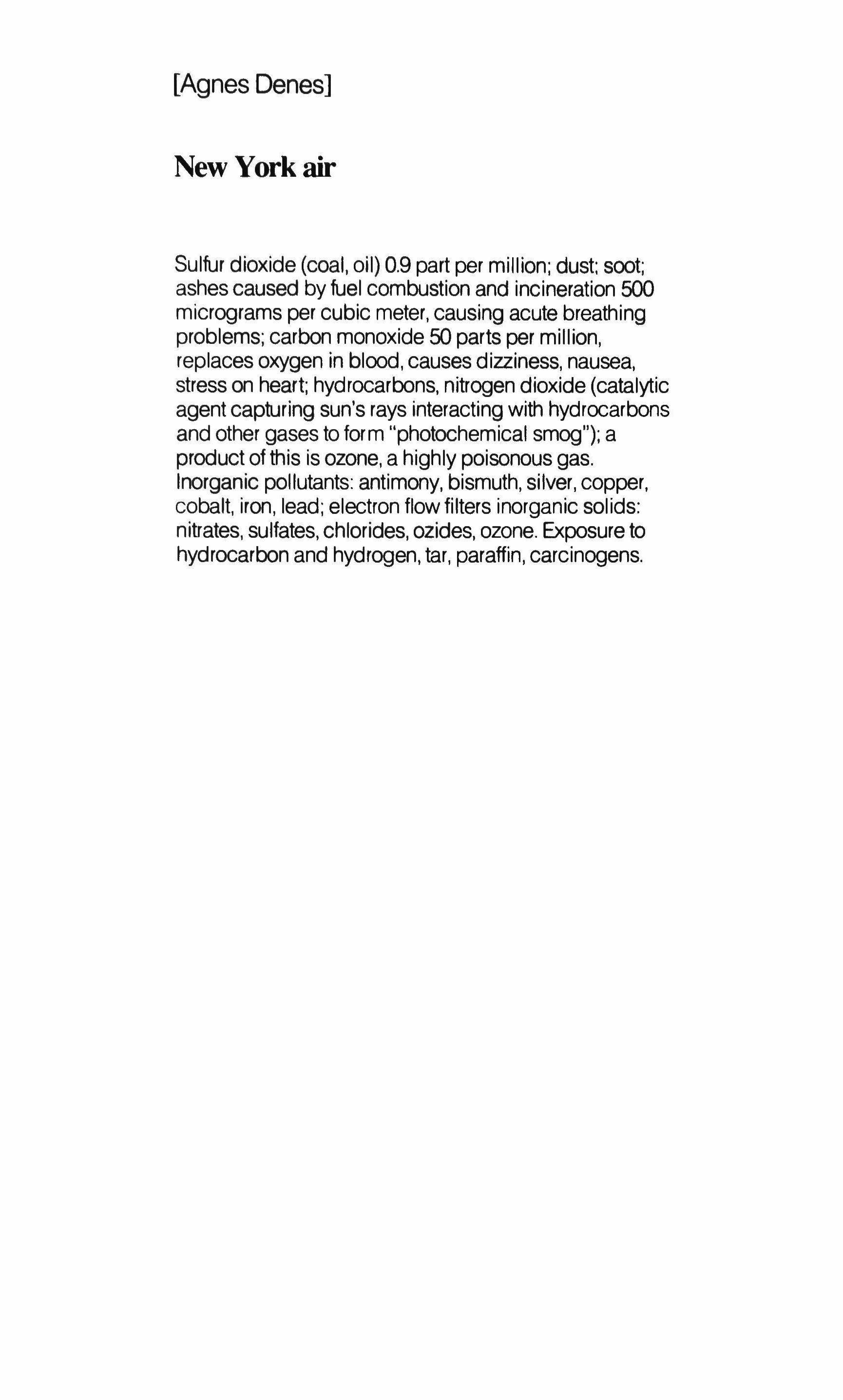
Sulfur dioxide (coal, oil) 0.9 part per million; dust: soot; ashes caused by fuel combustion and incineration 500 micrograms per cubic meter, causing acute breathing problems; carbon monoxide 50 parts per million, replaces oxygen in blood, causes dizziness, nausea, stress on heart; hydrocarbons, nitrogen dioxide (catalytic agent capturing sun's rays interacting with hydrocarbons and other gases to form "photochemical smog"); a product of this is ozone, a highly poisonous gas. Inorganic pollutants: antimony, bismuth, silver, copper, cobalt, iron, lead; electron flow filters inorganic solids: nitrates, sulfates, chlorides, ozides, ozone. Exposure to hydrocarbon and hydrogen, tar, paraffin, carcinogens.

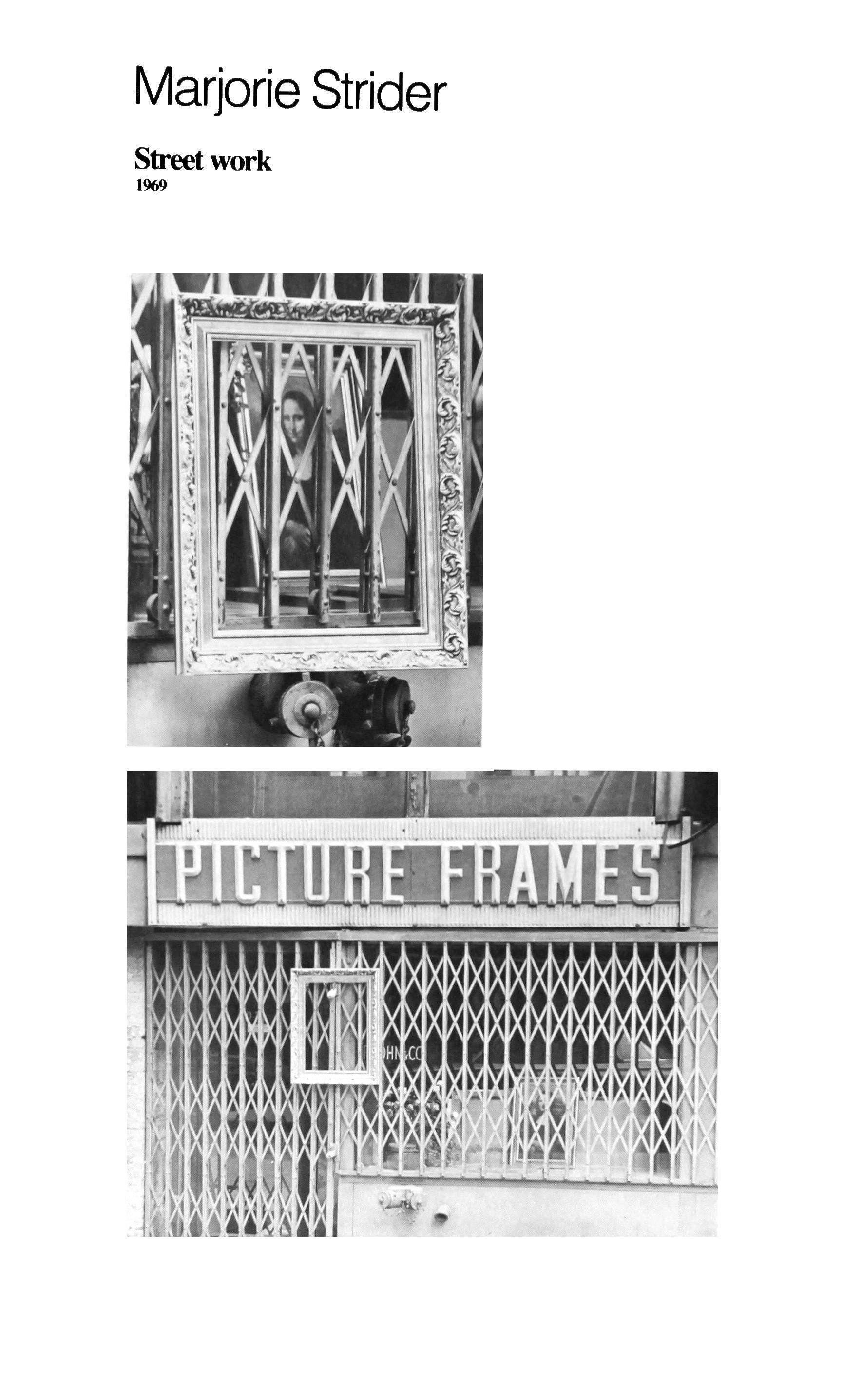
Marjorie Strider
Street
1969
work
Douglas Huebler
Location piece #17
Turin,ItaIy

On March 17, 1973, the artist arbitrarily selected then focused on a specific location some distance away from where he was standing in the Piazza Vittorio Veneto (A); he wanted to see what "was going on across the river" (the Po) at a place that he had never seen before and that he never intends to see again (8: the corner of Via Cosmo and Via Villa d. Regina). The selected location was approached on foot, one photograph was made and then the artist walked away at once; back in America he processed the film and discovered that at the instant the photograph was made a man was looking directly at the artist and that that man bears a strong resemblance to the artist at least more so than most everyone else in the world.
Five photographs join with this statement to constitute the form of this piece.
December, 1973
 [Oougla$ Huebler]
[Douglas Huebler]
[Oougla$ Huebler]
[Douglas Huebler]

[Douglas Huebler]
Variable Piece #135
Edinboro State CoUege
Edinboro, Pennsylvania
The following instructions were sent to Edinboro State College as the artist's response to a request to participate in an exhibition:
LOOK-ALIKES
In connection with the Edinboro State College "Instructions" Exhibition a prize of $100 will be awarded to the photograph that pictures two people (unrelated by any family tie) who are judged to look more alike than any other two whose photograph is submitted for competition. $60 will be awarded to the first runner-up, and $40 to the second runner-up.
All photographs should be 5" x 7" and should be submitted to Bart Farmer by January 10, 1974. Mr. Farmer·will establish the procedure that will form the final judgement.
All photographs submitted will become the property of the artist and will join altogether to constitute the form of this work.
Nine photographs were submitted and join with this statement to form this work; on the back of each reads this information:
a
b Rick Nelson
c Lynn Rothrack John
d Deb Catspano Marsha Myers
e Left: Right: Rose Brickner Nancy Cokrlic 212 Ash Street Stewart #9
Edinboro. Pa. Darrow Road 734-1094 Edinboro. Pa. 734-3121
Mary Pavlov Sue Nicolls
g h Robert Ruth Mathew Porto Andrea Kurash
November, 1973 March,1974

1stplace
3rdplace 2ndplace
 [Douglas Huebler]
[Douglas Huebler]
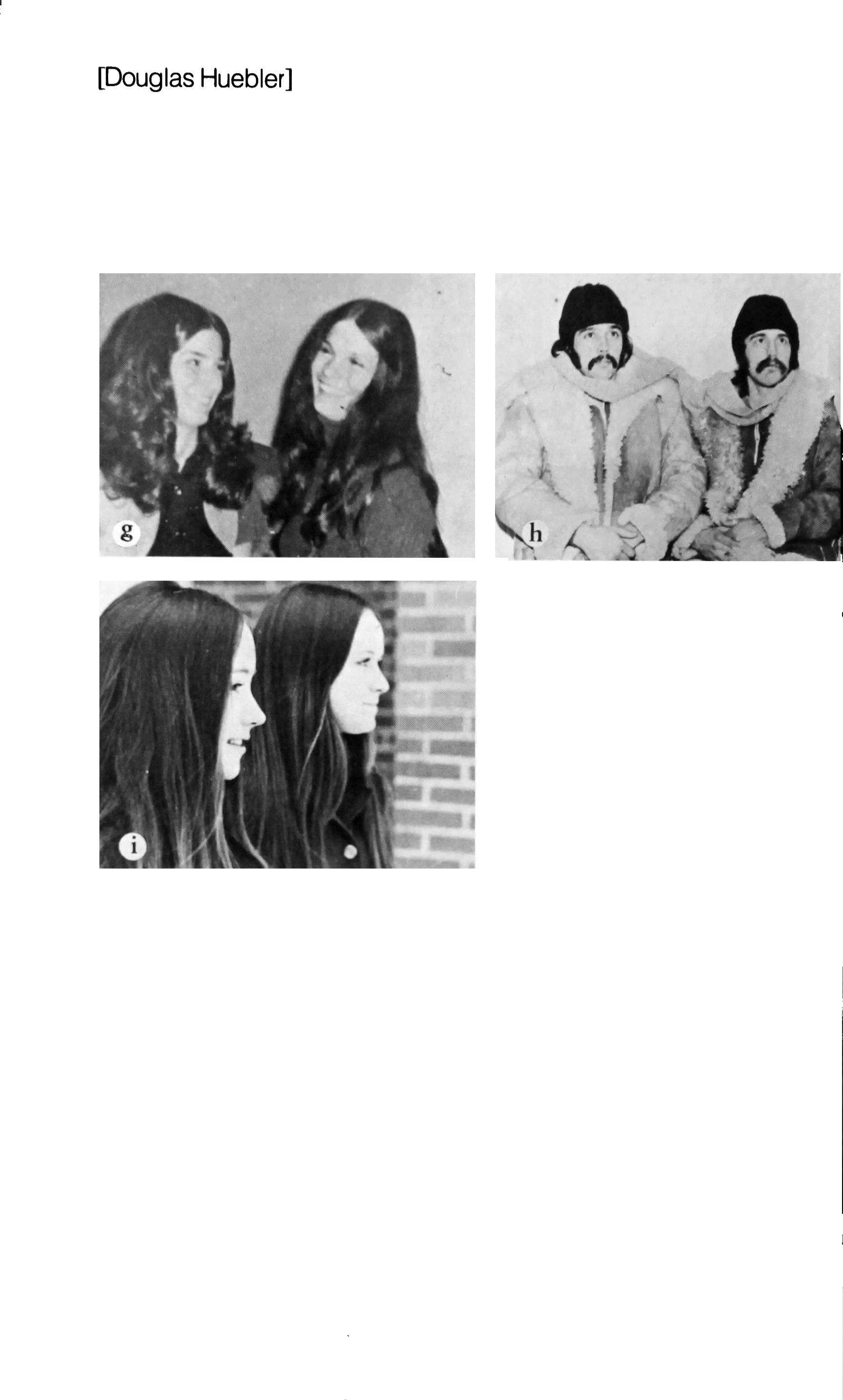 [Douglas Huebler]
[Douglas Huebler]
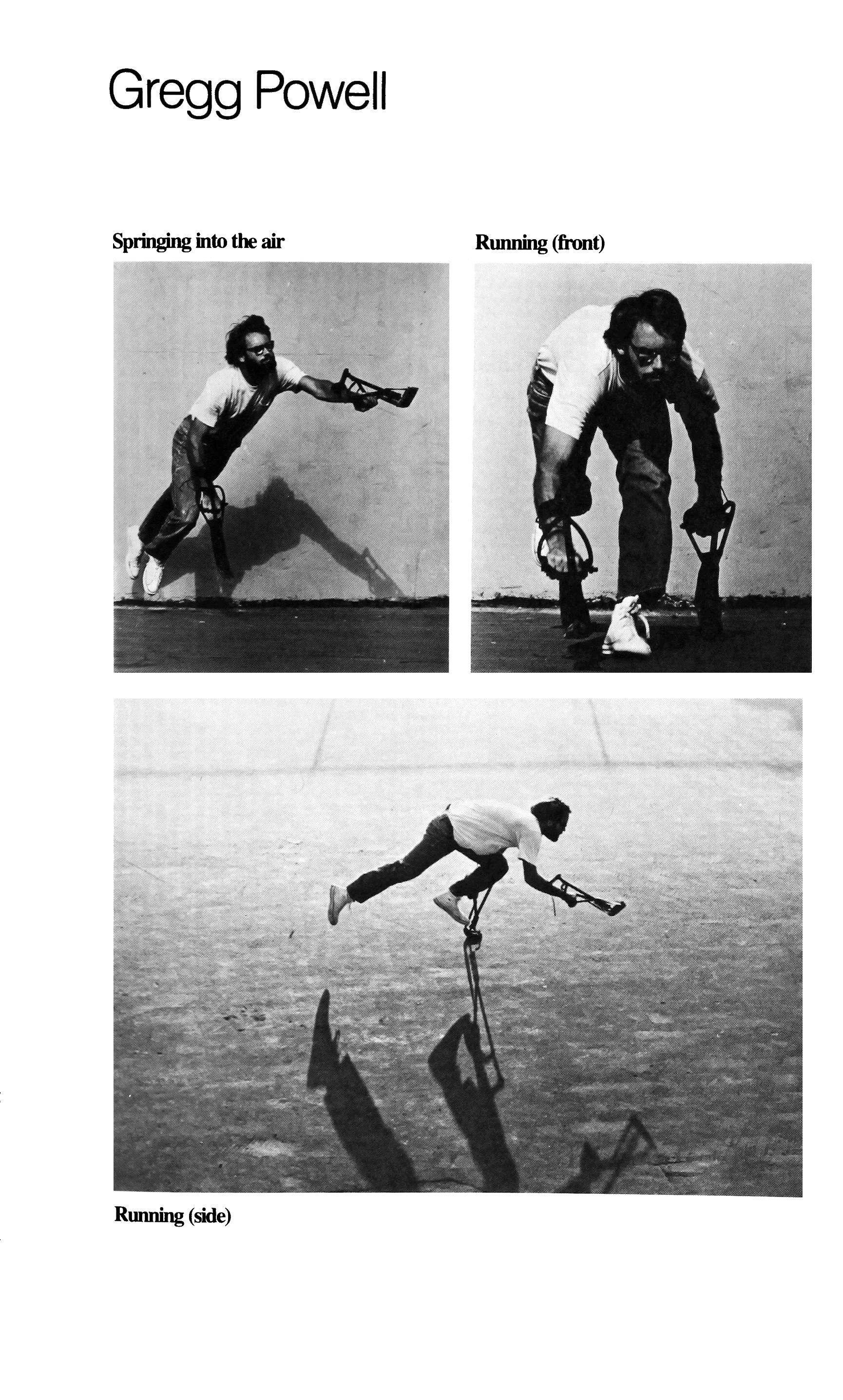
Gregg Powell
Springing into the air
Running (front)
Rwming (side)
I� QSNllali1 ••al DDJiHJ I't '\
\P;SnIl8IU'J ••• lilllN@tlWQlH,u.adIlIl181t1IHslU I...
•• '.11" 608BIUJ •• Illitl PPNNIUI •• llln." B8l!l'\
11
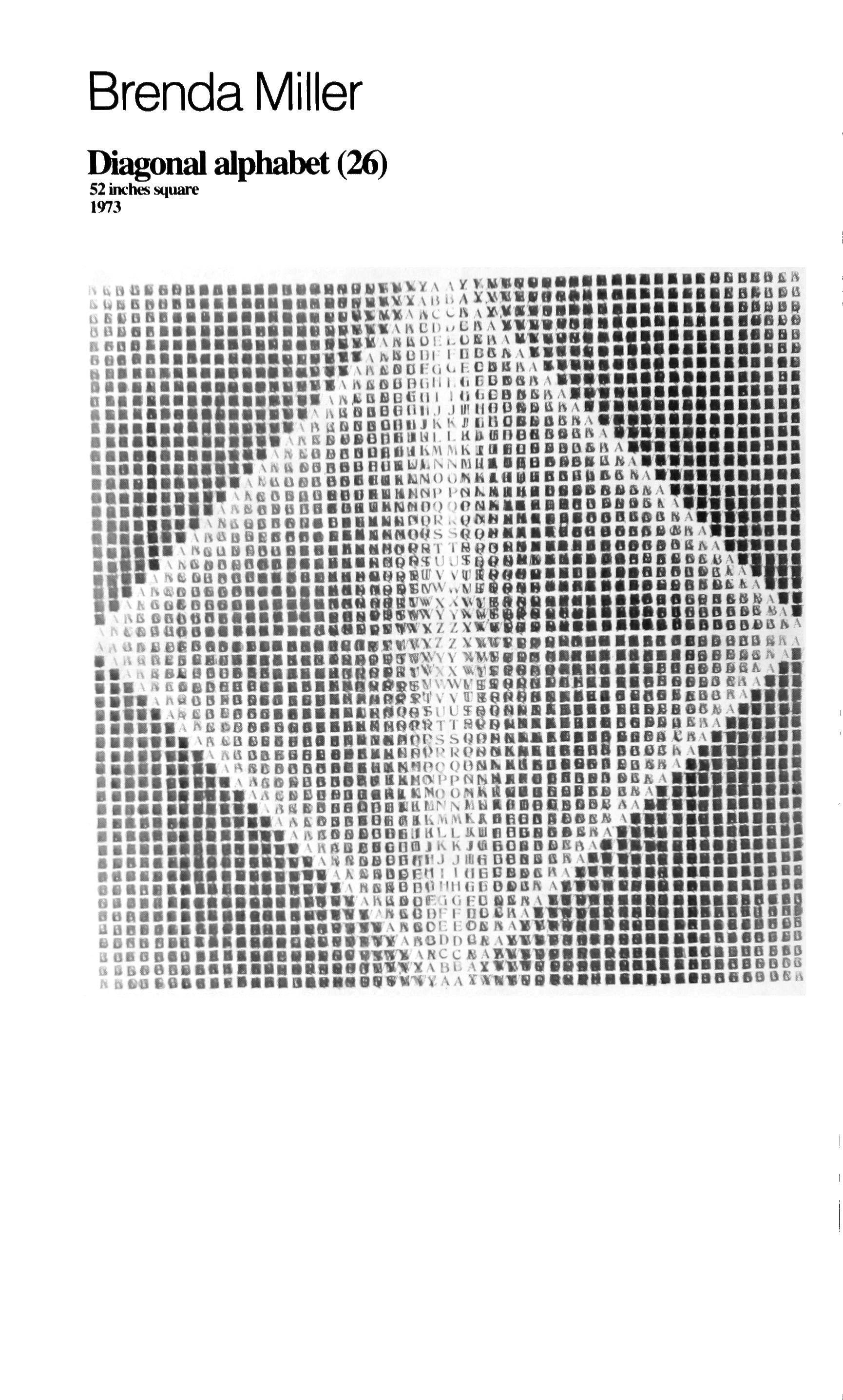
I 11\' tHli}08DIl.U.t:lll\oO �ltll •• I!l."1118BS
• ,Hi�" Bl'JDDlIIlllU.lr' Irltl.nIlBG,BDIIJS i\
S2 inches square 1973 1�IHS 81U "11.'1 ).y,\ \Y.l�IiI1.III •••• : •••••••• liJlillaIH;� r.IHlISI'HUI •••••• Il ••••••• l{\BI>A�,�:JI1I,IIl8.: ••••••••• BB.IUIl U6�OBI ••••••••• !.'W ���\�C��A��••••••••••••••• B.ijBQ D I)lUIll •••••••••• II a•••• \1\ CI)" L; 1\1\ »1(.11'."' •••••••••••aIHi aBoB •••••••••I •••• 14 \I'H�OI:I_Ulllt\ \"' 11••••••••• 116 88 •••••••••••• :11 \)\olSOIlI IDSBtU....... • ••••••• III'IB Ii ••• R ••••••••• III • \ 1\ .&601'(; l, f'.C1IIS II" :C •••••••••• I ••• .II •••• i; 1iI.1l.\111ll6Bfll,l 'ldjBIII81l,\."H.... • ••••••• IU .1 •••••• ••• \I'L"OAlEl6111 I OhGO'Uf\A.. • ••••••••• = Ii :'j'••= 11L\8DS9111I.J,JUIIIOIHUISI\A :.11:•. = • •••• 1. •• \1\1.1 6 n D DIU! J 1\ JJ IHI 0 • & " IS H" -.'1- •.•••. I • •••• • \ 1\ IS B U & B (lll II In I. I{ n IB 0 8 Ii B III 1\ f'S \ ••••• I ••••• • •••• • •••11 \ JH:O D B n Ofllllll\�\ M ICI 1111. 0 Bill Q ali 11 A """'il • \J\�88IH.BflU.WA, IIIU ••• sBlie.li1l1i\ ••• ••••••••• • '.a" I •• \t,U088BBIIII.lllllNOllhilUfllllllllnOhaa NA • :. • 'I! • \ III'» I) II ft I) BIU) III lUll'll' 1>('1"'. I1UI UI •• 881U" •• 11I·U••• , I ••• \1\tlftIltUOU.OIIIIIlNMO') IOMfI •••• I'OBltItIH \1' -. • ••'111 \" tiD Be 1')' BI.IlIUll"OI� ,,1)�6 ,.U8 B.ISOB NAn •••• •• \Il ItBBllft" •••• 1I1l80ClS C1.QH ••••••BBIIIIGS0Sl\A.. • ••
••••• MMQ�RT1RvaB 8.Ban�.�A ••••. 'i \ J\.l)"o 9ft •••••••• Mt!lQ�$LJ .1$ 669 "11& 1I1l1S£,\jA "ftI I .\��681188.' •••• B8�QSWVvIN�8.8 •• D •••• ft8I1D.alA \1'\ OIS.08 •••• I ••• 81J1'IllY\V.,MWIU� 8 •••••••• Ji88J18t.:,k;\ h 60.000 ••••• laa8. lIW'X, 'I'WIUIIU1.1.11'1••• 6fUI&IU� \11 1�lSooun."."'.'.8. S�Y ��� •• 8.' ••• IB8nD65�\ "t. IHtCJD •••••••• 88.IIGII� l( Z LX '.'ii'1I8........ .ItDBIUHl �A D2eS8.B •••••••••••• wn7z��wwm.Q •••••• a•••8JBBB�h� • �I'l DIlIliIl •••• Il JiII�lJ" \'v,,"'W ••••••••••••• BBBBtiSr. \• •• �8MBaBB.a ••••• Q�m�� x �s. ••••••• 8.8.8B��\· ••• \ 1I:08&8S8 ••• II··1 filf»�!5 1\·w�'Il!&e!II.Ji •••• eB8B&B83 \aO \ '''�OlUtolil.a
•••B.'IIIUI •• "e.1\ \ •• • ••••.
L $@QIIIIl ••••••• IBlla BIHL\.' • •••••• )\fll lil8.6 •••••a.I!IfH��T1 SOtHa •••• a •• lUIJUilIlf;ILI ••••• .i \1\ tt:6
•• 111811." PS s QO.Hill•••••••• BIJ .CA \ •• • ••.•, \ 1\11
BIl ••
'.'i ••••
• •••••
•• ••••
.• • •••• ••
••••••••• \' t.BDBIOIlII\IlI '.",\ 'lOaOnll&Bft.S \11.':" ••••.• I ···n \I\I!DB&BDlilJliLL�WIlBB&b.III.MA'· "11· ••• •••••• II" "\1\1I0eB(jomJI\KJIII508I)A1a�\ •• ! • '.1" ••••11 \ !'i6SBBm J JIlltJDBIU111ft \' ••••1 ••••••••• •••••• • \I\IUl)e 11110613686;1\\ aln ••• II••II.lI•• ' \ J'HHIBD\l11l11l6011BN " 8. ••• ••• ••••• " \ 1\ Ii SOIF' i (j EO Illi In '.iill'II••••all".1 ., 8 a I.. • • I I I'f IHl [) IT DOS f\ \ • •• •• Itil 1161111 .1 •••••••• 8V \IHiOCI:OBln 1I1 •••••••••• IJiB & 868 ••••••• a •••••n'\I\CllnCR \ »11 011"11.1) •••••••••• 11". "\Nee ,\1Jl"'••Z•••".' ••••UB8.D bB88 •• It •••••••".IIIJII'&� \lil> \lI:'�1J.' •••••••• "88006 N tl II 8a ••••••• IJ •• '.IIIWtfU" .\/\ :onnnulll ao •• a llB,\
Brenda Miller Diagonal alphabet (26)
1·111·\�BUltReD8
•••• lI.luun' ·VIr.IUH�iJlI
\.... B 6D ft ••••••• lla.QQ'};ll
IIlB 1I1J1
DIlDIi
IlIIKG��}P
•••
.B. •
''''Ila
-...
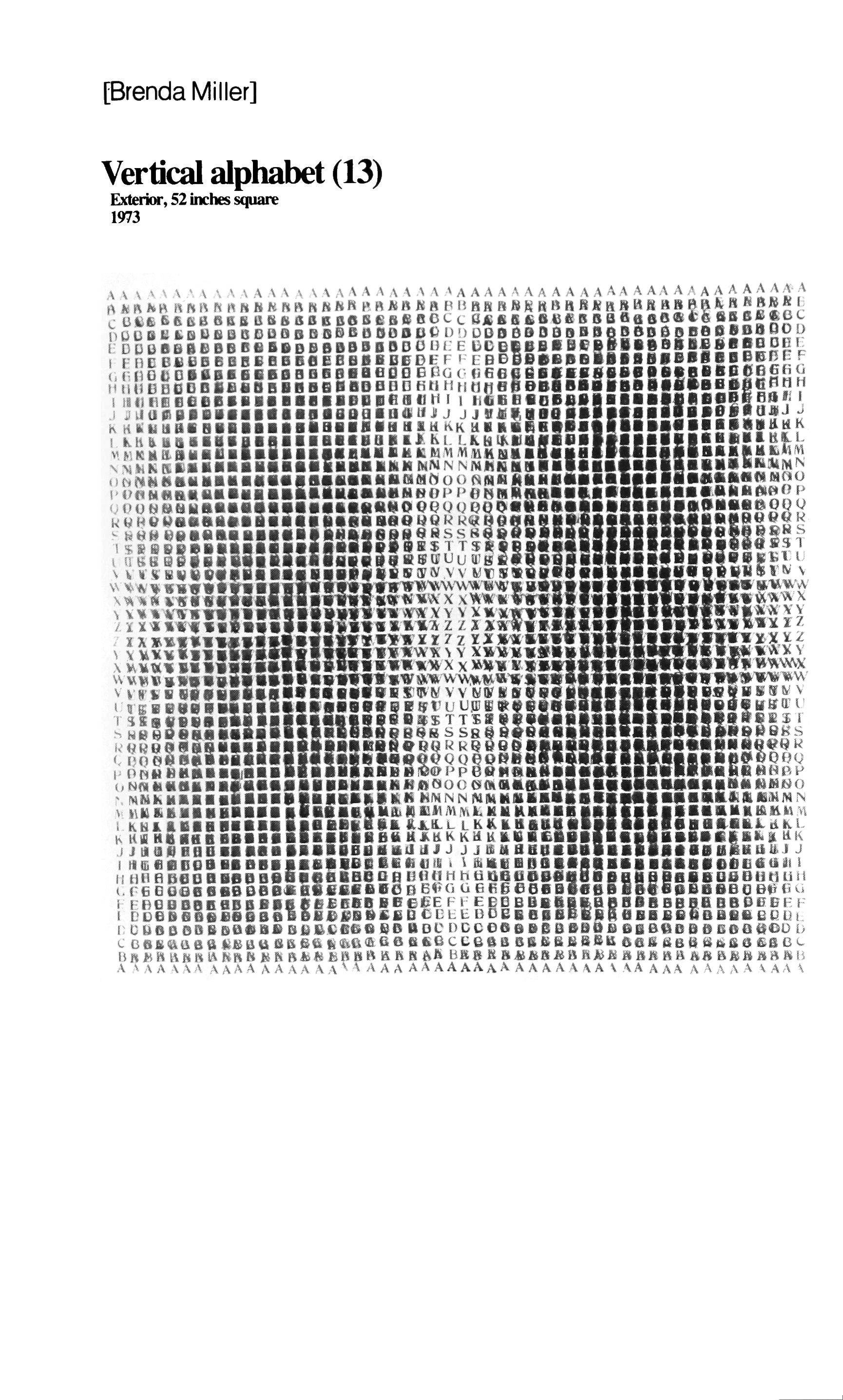
[Brenda Miller]
Vertical alphabet (13)
Exterior, 52 inches square 1973
John Baldessari
Retouch: portrait (Baldessari)
April,I974
 1. Control
1. Control
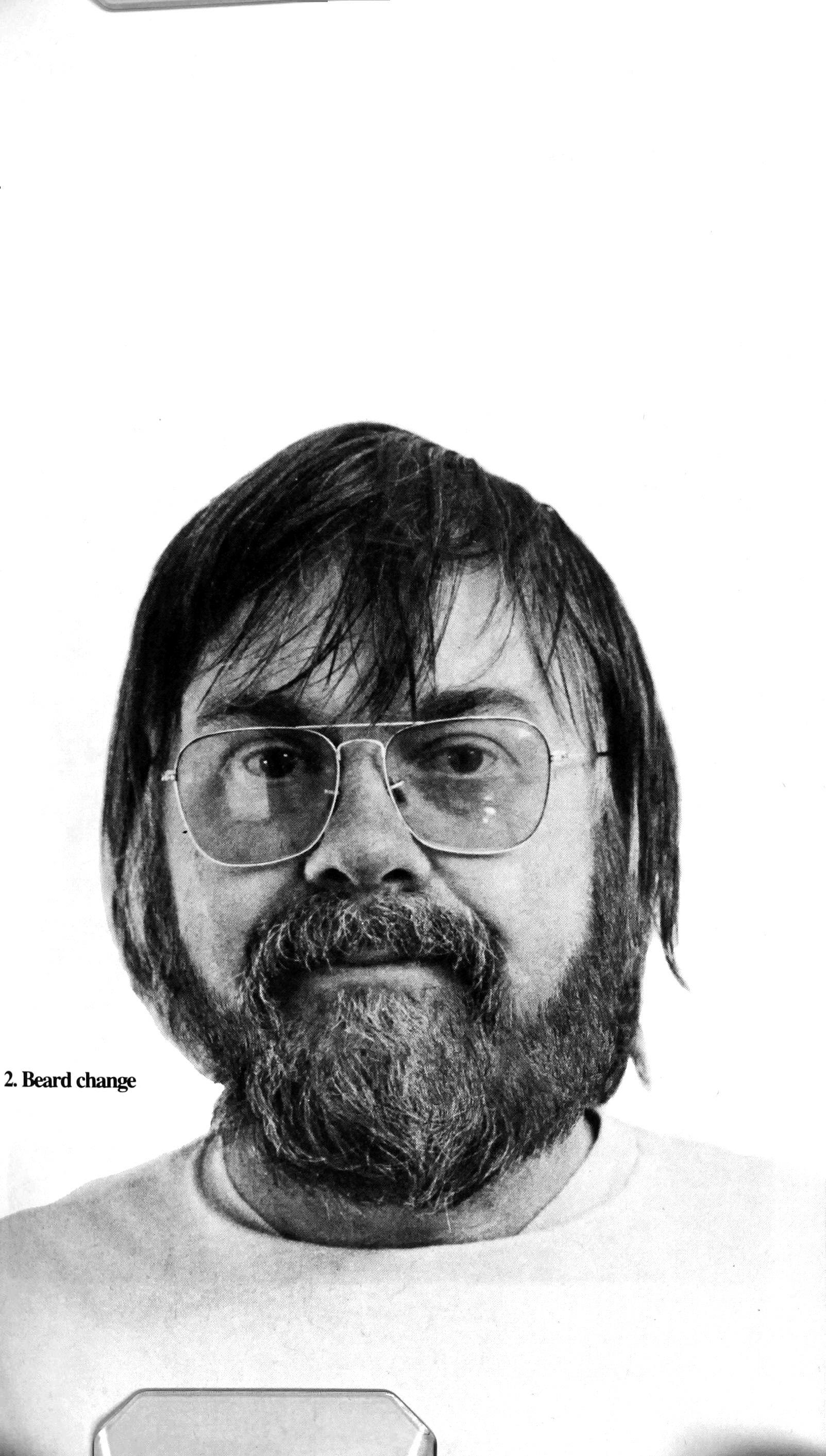 2. Beard change
2. Beard change

Gilbert & George
The singing sculpture Autumn, 1971

[Gilbert & George]

[Gilbert & George]
Vito Acconci
Reception room
Performance set (furniture and audiotape) with live pelformance. Three weeks (live pelformance for 3 days, 2 hours each day).
Modern Art Agency, Naples March, 1973
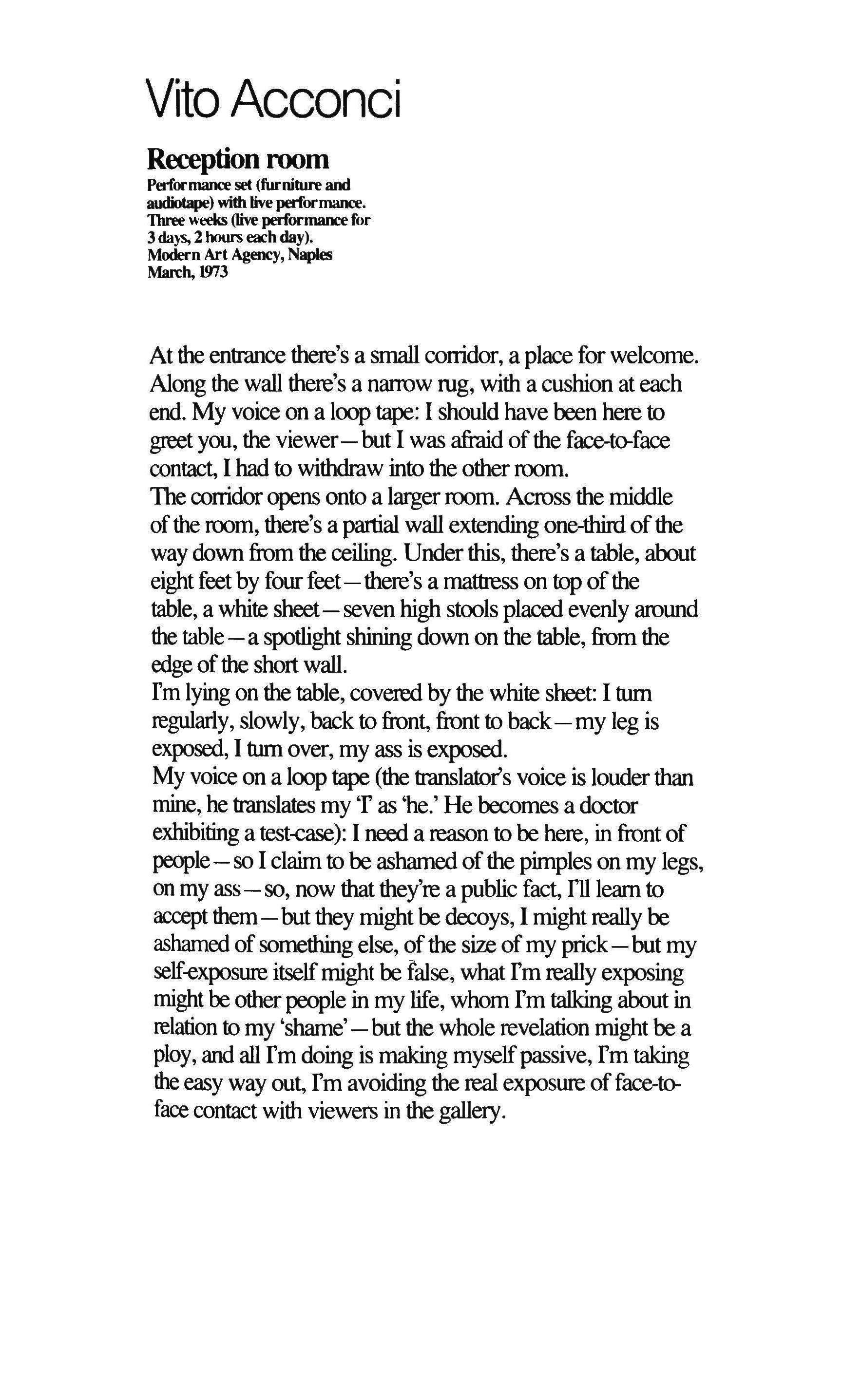
At the entrance there's a small corridor, a place for welcome. Along the wall there's a narrow rug, with a cushion at each end. My voice on a loop tape: I should have been here to greet you, the viewer - but I was afraid ofthe face-to-face contact, I had to withdraw into the other room. The corridor opens onto a larger room. Across the middle ofthe room, there's a partial wall extending one-third ofthe way down from the ceiling. Under this, there's a table, about eight feet by four feet - there's a mattress on top ofthe table, a white sheet - seven high stools placed evenly around the table - a spotlight shining down on the table, from the edge ofthe short wall.
Irn lying on the table, covered by the white sheet: I turn regularly, slowly, back to front, front to back-my leg is exposed, I turn over, my ass is exposed. My voice on a loop tape (the translator's voice is louder than mine, he translates my 'I' as 'he.' He becomes a doctor exhibiting a test-case): I need a reason to be here, in front of people - so I claim to be ashamed ofthe pimples on my legs, on my assso, now that they're a public fact, rn learn to accept them - but they might be decoys, I might really be ashamed of something else, ofthe size ofmy prick - but my self-exposure itselfmight be false, what I'm really exposing might be other people in my life, whom Irn talking about in relation to my 'shame' - but the whole revelation might be a ploy, and all I'm doing is making myselfpassive, I'm taking the easy way out, Tm avoiding the real exposure offace-toface contact with viewers in the gallery.

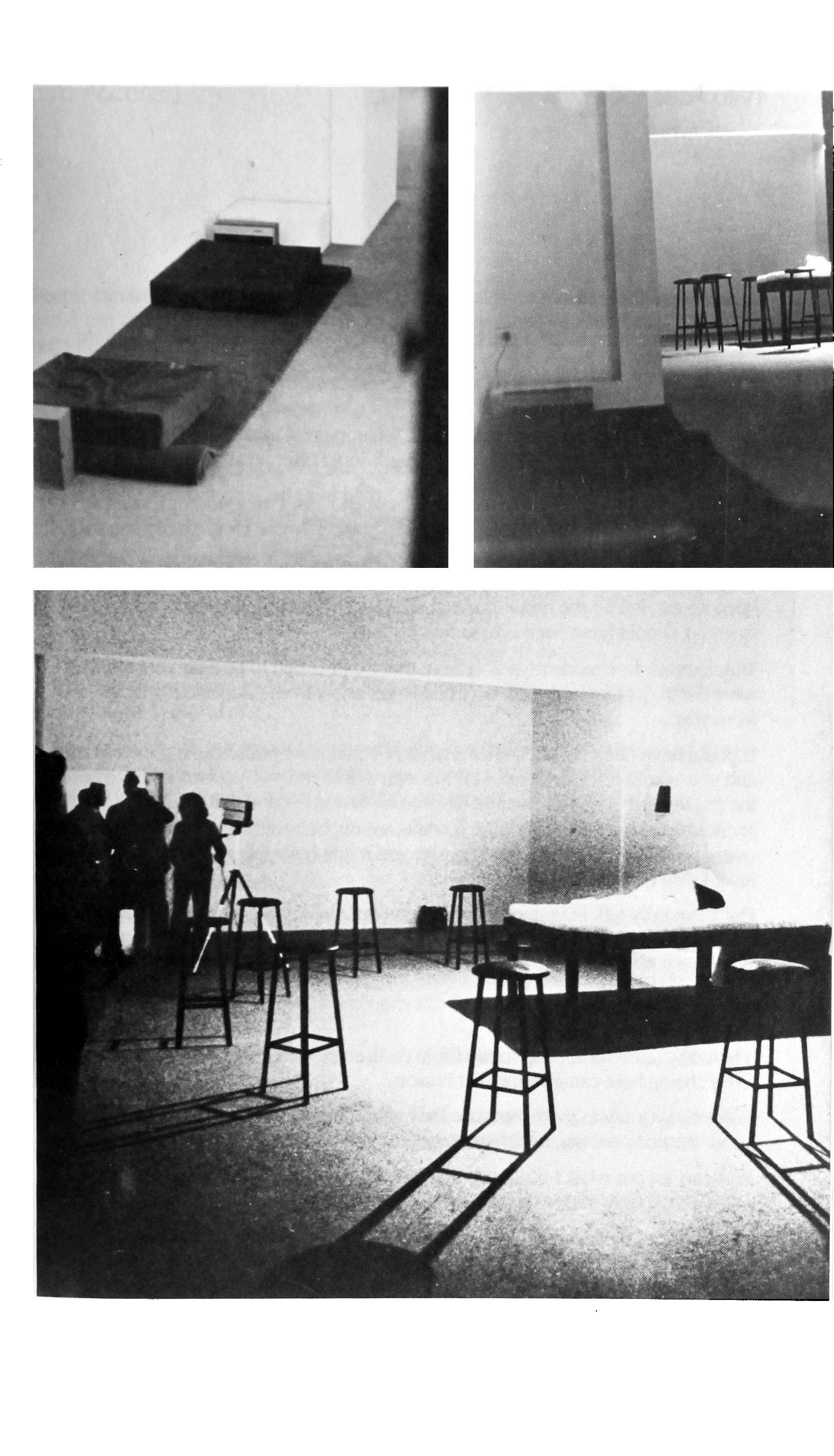
[Vito Acconci]

1. Audiotape for entrance l'Onidor
I should have been here to greet you, to invite you to sit down, sit opposite me
I should have been able to meet you face to face; I should have been able to talk to you, get closer to you
But I wouldn't have known what to say, what to do: I would have been afraid that you would find me disappointing, that I could offer no surprise
Maybe I should have fought my fear. We could have been comfortable here: we could have settled down on the rug, fallen back onto the pillows: we could have been alone here, together
We should have been here, you and I, as ifin a separate world. We could have been connected by the ground we sat on: I should have been able to move over to you, I should have been able to touch you
But, instead, I've made myselfbelieve that I'd be afraid to be near you, afraid to have direct contact with you. So I had to get away from you, hide my face from you
It could have been like this: after a while, I could have pulled the rug toward me, and you would have come toward me with it, into me - or you would have pulled the rug toward you, and I would have come toward you with it. into you
It could have been like this: after a while, we might have rolled toward each other, over each other, as ifrolling over a rug: you might have fallen on me, or I might have fallen on you, as ifon a pillow
But I can only talk in metaphor now, I can only talk about what could have been. Because I've backed off, afraid to trust myselfwith you: I've backed away from you, I've had to withdraw into another room
2. Audiotape for main room
There has to be something to say for myself, something that people call a 'reason to be': being here can give me that reason
Something to say to them, because they give me a reason to be here: I have to know they can see me, understand me
So I can act out what I dislike about myself, in front ofthem; I can show what I'm ashamed of: they can see the pimples on my legs, the pimples on my ass
I mean this: I'm ashamed to get undressed-when there's someone here, when I'm going to bed with som��� f�r_!I?e �t time -:I d�'t w�t �er to see my skin,
[Vito Acconci]

People can walk by me now, they can look at me -ofcourse I realize that. In fact, I can come herejust for that reason: I can come here because they'll walk by, because they'll stop and look
Maybe I have this in mind: whoever I'll go to bed with here can see the skin now, she can see the pimples beforehand
But that isn't it: it doesn't matter whether or not I go to bed with anyone here: the pimples can be a fact now - it would be senseless to hide it in the future
So I can lie in the dark here. I don't have to see myself; they can see me instead, they can do the seeing for me: they can examine me as ifwith a spotlight...
A spotlight on what I can't face up to, about myself: pimples on my legs, on my ass: the pimplespaint out faults in me - I'm unclean, I'm ugly, I can't grow upsecrets, sexual sins, guilts - I can't talk about that now
So I keep turning myselfover: I'm turning myself over to them
Ifthey can see my skin, and accept it, then maybe I can accept it, too: I won't have to want to get rid ofit...
I can't make myselftalk about the rest ofit: the fact that my feet smell, no matter what I do to them-I'm ashamed ofthat, too, when I'm going to bed with someone for the first time, when I'm getting undressed - I have to show that, too, so I can be comfortable with it.
Maybe I'm exaggerating my shame, to give myselfa reason to be here, a reason to be with other people here
This could be a kind ofstrategy: I can't make myselftalk to them, can't meet them face to face, so I can turn myselfinto an object for them
It might be that I can reveal the flaws in my body because I'm afraid to reveal the flaws in my mind - revealing what's private, then, can hide my withdrawal from public responsibility: I can conceal my lack of nerve, my refusal to interact with otherpeople
Revealingparts ofmy body to be looked at like a corpse: dying: talking to myself here, thinking about myself-it's like a man reviewing his life quickly, before he dies
Maybe this is a way to make myselfdie for myself, die to myself: I can be alive only as they see me
I remember now how Kathy watches me while I take a bath, how she breaks the pimples on my legs
[Vito Acconci]

It's as ifshe's preparing me for other women, preparing me to look beautiful for them, preparing me to go to bed with them
No: why am I bringing her into it? Maybe I'm not exposing myselfat all: what I'm doing might be exposing her, harming her, under the pretense ofexposing myself
I could say that it's too much to take: I can feel everythingcrashing down on me -a weight on my head-I can feel the ceiling falling in on me
It could be that what I'm showing will make up for what I can't make myself show: maybe I'm not ashamed ofmy legs, my ass, the pimples, the smell ofmy feet-maybe I'm not ashamed ofthose things at all-what I'm really ashamed of is the size ofmy prick, my certainty that it's too small-but I won't show that...
I want to avoid that; so I remember Kathy talking about my ass - how much she loves looking at my ass, touching my ass
I remember she said it's like a girl's ass - she likes that - at least I think she said that, I can't quite recall
Maybe the pimples can contradict that impression: they can restore my masculinity, return me to manhood- I'm not sure now if I'm ever ashamed of the hair on my ass
But I remember Rosemary saying my prick was too small for her, I couldn't excite her
No, I can't get into that: ifthey think-ifthe people here think I'm exaggerating the pimples, then maybe they'll think I'm exaggerating that, too
They might think I'm making too much ofthe pimples, I'm making them more important than they're worth-but that'sjust the point: if ( think it's important, and it's not, then I'm revealing to them what's really on my mind-so they can't be upset that I won't respond to them, I'm giving them more than that
So show them my ass-fuck them-no, it's not like that- I can't believe that this is an aggression against them - but now and then I might want to believe it, I might want them to accept that too, I want to test them
But it's really the opposite: I have to believe I'm leaving myselfwide openlaying my cards on the table-let's say I'm letting the cracks show-so they'll have to put the pieces together
So I'll keepgoing over this: ( have to have something to say to myself, something to keep me here, something to stop me from running away

Le Ann Bartok Wilchusky
Skyworks RedIine One mile long

[Le
Ann Bartok WiIchusky]
Hans Haacke

SOLOMON R. GUGGENHEIM MUSEUM
BOARD OF TRUSTEES
PETER 0 LAWSON-JOHNSTON, President
Born 1927 Mining Co Executive. lives Princeton. N,J,
H HARVARD ARNASON
Born 1909. Art Historian. Lives New York City and Roxbury, Conn,
JOSEPH W DONNER
Born 1927 Stockbroker. lives New York City
ElEANOR COUNTESS CASTlE STEWART
Born 1896. Lives in Engtand
MASON WElCH GROSS
Born 1911 President Harry F, Guggenheim Foundation. lives Rumson, N,J
FRANK A. MILLIKEN
Born 1914. Mining Engineer. lives Darien, Conn,
HENRY AllEN MOE
Born 1894. Retired Foundation Executive. lives Fieldston, N,Y and Sherman, Conn,
A, CHAUNCEY NEWLIN
Born 1905 lawyer. lives Scarsdale, N.Y,
MRS HENRY OBRE
Clubwoman. lives Monkton, Md
DANiEl CATION RtCH
Born 1904 Museum Director Emeritus. lives New York City
ALBERT E THiElE
Born 1892 Business Executive. lives Scarsdale, NY.
MICHAEl F, WETIACH
Born 1931 Sportsman, raising lhoroughbreds lives Hydes. Md,
CARL ZIGROSSER
Born 1891 Museum Curator Emeritus. lives Philadelphia and Montagnola. Switzerland
SOLOMON R. GUGGENHEIM MUSEUM
GUGGENHEIM FAMILY MEMBERS AMONG TRUSTEES

elEANOR COUNTESS CASTlE STEWART
Born Elellnor Guggenheim. Dllughler 01 Solomon R. lind Irene (Rothschild) G.
MRS. HENRY OBRE
Born Bllrbarll Guggenheim. Dllughter 01 Solomon R. lind Irene (Rothschild) G.
PETER O. LAWSON-JOHNSTON
Son 01 Bllrbllrll Guggenheim sllnt mllrrlage to John R. LIIwson-Johnston
MICHAEL F. WETTACH
Son 01 Bllrbarll Guggenheim 5 second mllrrlage to Fred Wenllch Jr.
[Hans Haacke]
SOLOMON R. GUGGENHEIM MUSEUM
CORPORATE AFFILIATION OF TRUSTEES

PETER 0 LAWSON-JOHNSTON
Anglo Co. Lid Chalrm'an &0 Member Board 01 Directors
Elgerbar Corp Vice President &0 Member Boaro 01 Directors
Feldspar Corp Chairman &0 Member Board 01 Directors
Robert Garrett &0 Sons. Inc Member Board 01 Directors
Guggenheim Brothers. Partner
Kennecott Copper Corp Member Board 01 Directors
Minerec Corp MemDer Board 01 Directors
Pacilic Tin Consolidatttd Corp. Vice Chairman &0 Member Board 01 Directors
Prlntex. Inc Member Board 01 Directors
JOSEPH W DONNER
Cyrus J Lawrence &0 Sons. Brokers. Partner
FRANK R. MILLIKEN
Chase Brass &0 Copper Co Member Board 01 Directors
Federal Reserve Bank 01 New York. Member Board 01 Directors
Kennecoll Copper Corp President. Chle! Exec Officer &0 Member Board 01 Directors
Peabody Coal Co Member Board 01 Directors
Proctor &0 Gamble Co Member Board 01 Directors
Quebec Iron &0 Titanium Corp Member Board 01 Directors
A CHAUNCEY NEWLIN
White &0 Case. Lawyers. Partner
Pacillc Tin Consolidated Corp past Member Board 01 Directors
MRS. HENRY OBRE
Elgerbar Corp Member Board 01 Directors
ELEANOR COUNTESS CASTLE STEWART
Elgerbar Corp Husband Eart Caslie Stewart. Member Board 01 Directors
ALBERT E THIELE
Anglo Co. Lid. Member Board 01 Directors
Anglo Ventures. Member Board 01 Directors
Barber 011 Corp Member Board 01 Directors
Companhia de Dlamantes de Angola. Member Board 01 Directors
Eigerbar Corp President &0 Member Board 01 Directors
Guggenheim Brothers. Partner
Kennecott Cop�\8r Corp past Member Board 01 Directors
Mlnerec Corp Vice President &0 Member Board 01 Directors
Pacilic Tin Consolidated Corp .• Member Board 01 Directors
MICHAEL F. WETTACH
Elgerbar Corp Member Board 01 Directors
[Hans Haacke]
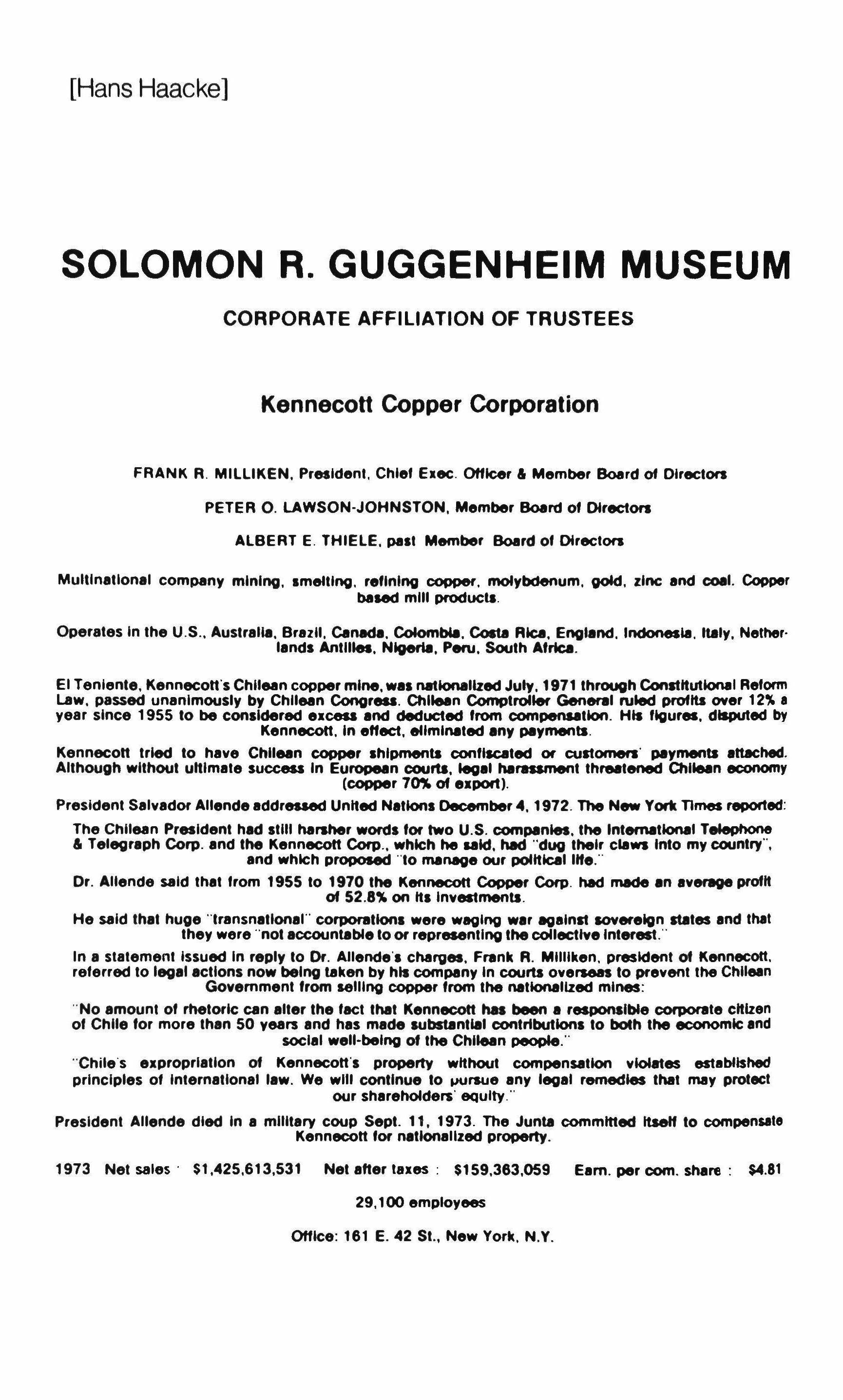
SOLOMON R. GUGGENHEIM MUSEUM
CORPORATE AFFILIATION OF TRUSTEES
Kennecott Copper Corporation
FRANK R, MILLIKEN, Presldenl, Chlel E.ec, Officer. Member Board of Directors
PETER O. LAWSON-JOHNSTON, Member Board 01 Directors
ALBERT E, THIELE, pasl Member Board 01 Directors
Multinational company mlnlna, smeillna, rellnlna copper, molybdenum, gold, zinc and coal. Copper based mill products,
Operates In the U.S., Australia, Brazil, Cenade, Colombia, eo... Rica, Enaland, Indonesia, Italy, Nether· lands Anlllles, Nigeria, Peru, South Airlca.
EI Tenlente, Kennecon'S Chilean copper mine, was nationalized July, 1971 through Constitutional Relorm Lew, passed unanimously by Chilean Conor Chilean Comptroller Generlll ruled profits oyer 12% • year since 1955 to be considered ellC811 and deducted lrom compensation. His ligures, disputed by Kennecott, In ehect, eliminated any payments, Kennecon tried to have Chilean copper shipments conllscated or cul1omen' payments attached. Although without uHlmale success In European courts, legal harassment threatened Chilean economy (copper 70'10 of ellport).
PreSident Salvador Allende addressed United Natlonl December 4, 1972, The New Yort TImes reported:
The Chilean President had ItIII harsher words lor two U.S. companies, the International Telephone • Telegraph Corp. and the Kennec:otl Corp" which he said, had "dug their claws Into my country", and which proposed "to manage our political IlIe:'
Dr. Allende said that Irom 1955 to 1970 the Kennecott Copper Corp, had made an aVer1!g8 profit of 52.8'" on Its Investments,
He said that huge "'ransnallonal"' corporations were waglna war againl1 sovereign I18t and thai they were "not accountable to or represenllna the coIlectlYelnterest."
In a statemenl issued In reply to Dr. Allende's charges, Fl1Ink R. Milliken, president of Kennecott, relerred to legal actions now belna taken by his company in courts overseas to prevent the Chilean Government Irom sellina copper lrom the nationalized mines:
"No amounl 01 rhetoric can alter the lactthat Kennecott has been a responsible corponIte citizen 01 Chile lor more than 50 years and has made substantial contrtbutlons to both the economic and social well-beina of the Chilean people."
"Chile's ellproprlatlon of Kennecon's property without compensation violat.. established principles 01 international law. We will continue to IlUrslJe any legal remedies that may protect our shareholders' equity,"
President Allende died in a military coup Sept. 11. 1973, The Junta committed Itself to compensate Kennecon lor nationalized property. 1973 Net sales' $1,425,613.531
[Hans Haacke]
Netaner ta : $159,383,059 Earn. per com. share: $4.81 29,100
Office:
employees
181 E. 42 SI., New York, N.Y.

SOLOMON R. GUGGENHEIM MUSEUM
CORPORATE AFFILIATION OF TRUSTEES
Anglo Company Ltd.
Formerly Anglo-Lautaro Nitrate Co.
PETER O. LAWSON-JOHNSTON. Chairman &. Member Board 01 Directors
ALBERT E. THIELE. Member Board 01 Directors
(Albert van de Maele. President &. Member Board 01 Directors. John A. Peeples and Oscar S. Straus II. Members Board 01 Directors 01 Anglo Co. ltd are partners 01 P.O. Lawson-Johnston and A.E. Thiele in Guggenheim Brothers lirm)
Directors and related trusts. incl. Guggenheim interests held 49% 01 total voting power. Feb. 13. 1973
Business: General Finance
Nitrate Industry ollormer Anglo-Lautaro Nitrate Co. ltd .• in Chile. was nationalized 1971
24.9% interest in Robert Garrett &. Sons. Inc .• investment banking Ilrm. Jan. 1973
53% interest in Nabors Drilling ltd Canada. Acquired 1974 lor $3.100.000 cash. Oil and gas well drilling in Western Canada and the Arctic. Sales appro•. $1(}million Office: 120 Broadway. New York. N.Y.
Anglo Ventures Corporation
Subsidiary of Anglo Co. Ltd.
ALBERT E. THIELE. Member BOArd of Directors Office: 120 Broadway. New York. N.Y.
Minerec Corporation
SubSidiary of Anglo Co. Ltd.
ALBERT E. THIELE. Vice President &. Member Board 01 Directors
PETER O. LAWSON-JOHNSTON. Member Board of Directors
(Albert van de Maele. Chairman &. Member Board of Directors. and John A. Peeples. Member Board of Directors of Mlnerec Corp are partners of A.E. Thiele and Peter O. Lawson-Johnston in Guggenheim Brothers firm)
Products: Chemical flotation reagents Sales $1-2 million. 30 employees Office: 120 Broadway. New York. N.Y.
Robert Garrett & Sons, Inc.
PETER O. LAWSON-JOHNSTON. Member Board of Directors
(Albert van de Maele. also Member Board of Directors of Garrett &. Sons. Inc Is partner of P.O. LawsonJohnston In Guggenheim Brothers firm) Investment banking firm
Anglo Co. ltd. has 24.9% Interest. Jan. 1973. Merger with Anglo Co. ltd. proposed Office: 100 Wail si., New York. N.Y.
[Hans Haacke]
SOLOMON R. GUGGENHEIM MUSEUM
CORPORATE AFFILIATION OF TRUSTEES

Guggenheim Brothers Partnership
PETER O. LAWSON-JOHNSTON. Partner
ALBERT E. THIELE. Partner
Ownership and management o' Guggenheim lamily mterests
Ollice: .20 Broadway. New York. N.Y.
Elgerbar
Corporation
ALBERT E THIELE. President & Member Board 01 Directors
PETER O. LAWSON-JOHNSTON. Vice President & Member Board ot Directors
MRS HENRY OBRE. Member Board 01 Directors
EARL CASTlE STEWART. Member Board 01 Directors
MICHAEL F. WETTACH. Member Board 01 Directors
Ownership and management 01 Guggenheim real estate and securities
Office: 120 Broadway. New York. NX
[Hans Haacke]

SOLOMON R. GUGGENHEIM MUSEUM
CORPORATE AFFILIATION OF TRUSTEES
Pacific Tin Consolidated Corporation
PETER O. LAWSON-JOHNSTON. Vice Chairman 8r Member Board 01 Directors
ALBERT E. THIELE. Member Board 01 Directors A CHAUNCEY NEWLIN. past Member Board 01 Directors
(F. Stuart Miller. Chairman 8r Member Board 01 Directors 01 Pacilic Tin Consolidated Corp. is a partner 01 P.O. lawson-Johnston and A.E. Thiele in Guggenheim Brothers firm)
Mming and processing lin. tetdspar. diamonds
Operations in the United States. Malaysia. Brazil
Inveslment in Cornpanrua de Diamantes de Angola
Sales range 59-12 million 800 employees Office: 120 Broadway. New York. N.Y.
Feldspar Corporation
Subsidiary of Pacific Tin Consolidated Corp.
PETER O. LAWSON-JOHNSTON. Chairman 8r Member Board of Directors
(F Stuart Miller. Member Board 01 Dlraclors of Feldspar Corp is a partner 01 P.O. lawson-Johnston in Guggenheim Brothers firm)
Products: Feldspar. mica. Silica sand
Sales range 53-6 million 280 employees Office' 120 Broadway. New York. N.Y
Companhia de Diamantes de Angola
ALBERT E THIELE. Member Board 01 Directors
Diamond mining wllh inveslment 01 Pacific Tin Consolidated Corp.
[Hans Haacke]

Richard Serra
To encircle base plate hexagram, rightangles inverted
Steel, 26-foot diameter 1970
[Richard Serra]
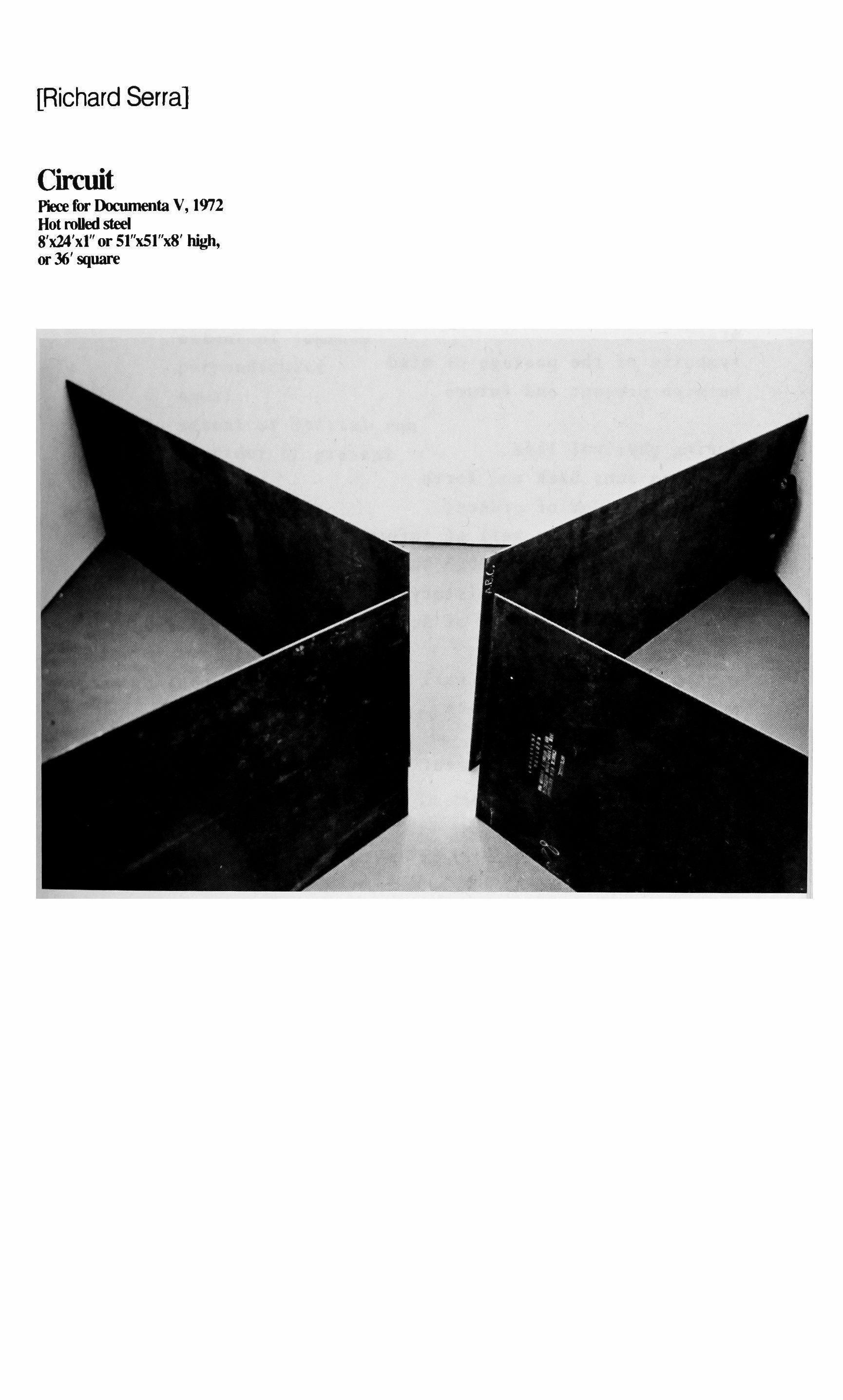
Circuit
Piece for Documenta V, 1972
Hot rolled steel
8'x24'xl" or SI"xSl"xS' high. or 36' square
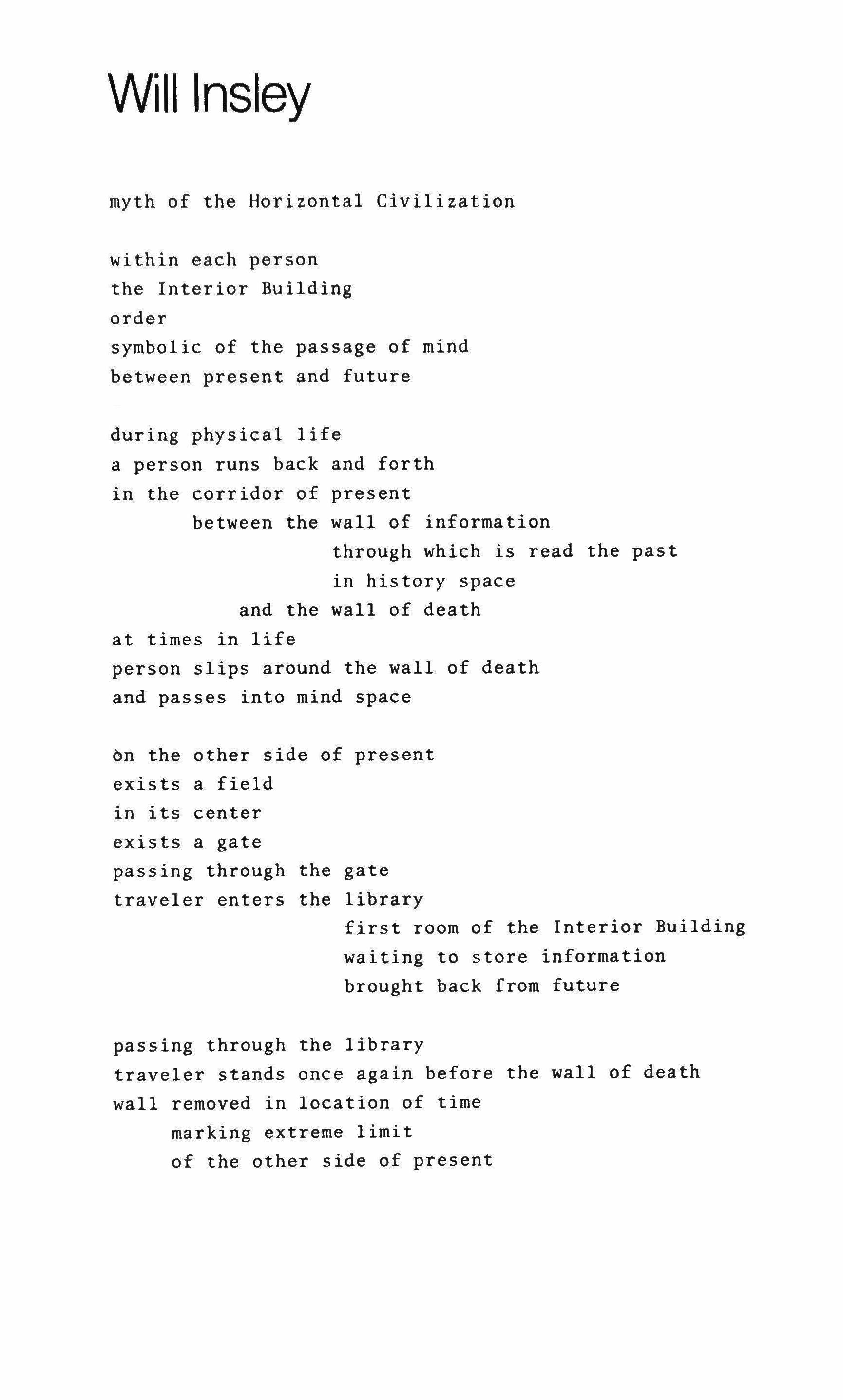
Will Insley
myth of the Horizontal Civilization
within each person the Interior Building order
symbolic of the passage of mind between present and future
during physical life
a person runs back and forth in the corridor of present between the wall of information through which is read the past in history space and the wall of death at times in life person slips around the wall of death and passes into mind space
bn the other side of present exists a field in its center exists a gate
passing through the gate traveler enters the library first room of the Interior Building waiting to store information brought back from future
passing through the library traveler stands once again before the wall of death wall removed in location of time marking extreme limit of the other side of present

traveler passes around the wall and in extended space journeys through series of rooms to the future extent of journey perpendicular equal to extent of initial run in corridor of present a square is measured the potential space of death passing around beyond this square traveler enters the arc witness to future time moves backward traveler in mind has jumped ahead in time and glimpses future information flowing in reverse the arc passes around the shadow of death projected from the space of death traveler traces its course and then returns from future through the series of rooms removed in time forming fourth side of the square
[Will Insley]

traveler deposits information in library returns through the gate and field to the corridor of physical present here indicating in facsimile information of what will exist in future at time of death travelers arc of return around the shadow of death is less than arc of entry at this point the wall of death perpendicular slides between the series of rooms and series of rooms removed according to extent of travelers investigation in life and opens the square the space of death the wall becomes a dotted line traveler passes through and enters the space of death eventually traveler passes into future
[Will Insley]

THE / BUILDING /
a structure of sequent spaces in ceremonial passage according to the myth is focal temple of the / buildings / of Extended Space this materialization of the Interior Building is the travelers ultimate goal for here the various complexities of all/building / types are blended stimulated by poetic content of the civilization structure a movie set open to the sky and separated into stages in my tho logic fact the Library lies buried deep beneath the Field beneath the Gate and following it the Series of Rooms extending into Future lie deeper still removed from contact outside world in mythologic fact the Interior Building has no outside the Horizontal Civilization deploys this sequence in movie space
[Will
Insley]
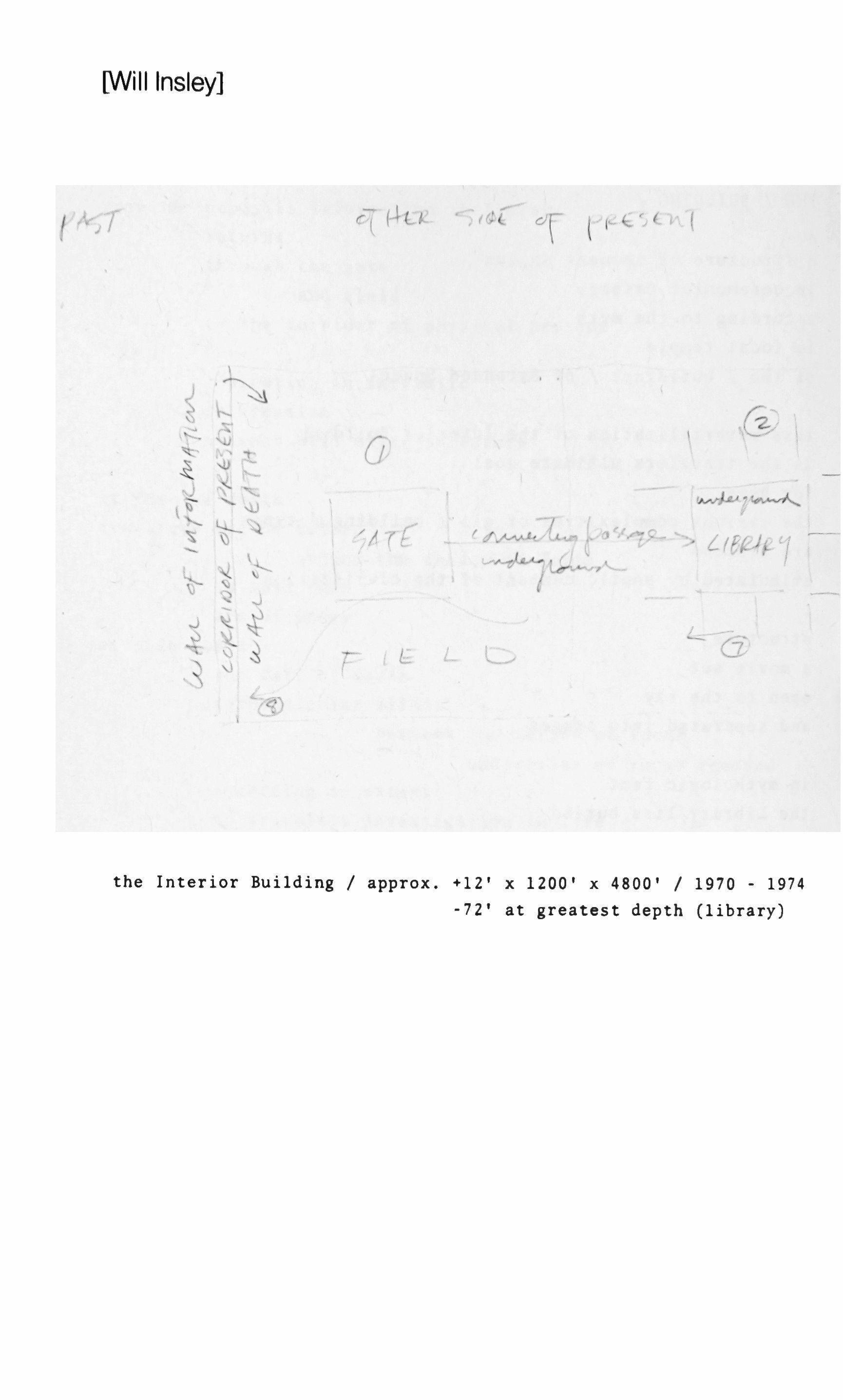
the Interior Building / approx. +12' x 1200' x 4800' / 1970 - 1974 -72' at greatest depth (library)
.IT cr (I� <c I .� (; ,. /. r r I ':/'�L L. t_ I {:_i ! I ..J i:
LWililnsley]
'v".__J.b<.'Y'\..CI t._. �(j) c� J jlqr.v--;

above sketch is 1974 version based on new information found after the 1970 "first contact"
[Will
!. v ') l�-0?0 e��L_ _{- 2C J. �/ t��f'r \ \ � �(��� (j;
�.,u(lib"�i
Insley]
1 'III' �n -.:
( -:---; t
[Will Insley]

what would be below is placed beside in stages of linear progression
stage / Wall of Information
Corridor of Present
Wall of Death
stage / Field
stage / Gate
connecting Passage
stage / Library
stage / Series of Rooms
stage / Arc
stage / Shadow of Death
stage / Space of Death
Passage Space one level above ground marking / building / ratio
Volume Channel below the earth line blends to Passage system within the earth rising to Wall Facade one level above ground Tunnel from center Gate to center
Volume Space no exterior definition Volume Channel deeper still within the earth slow rise to
Passage Space one level above ground surrounding Volume Space blending into Passage Space one level above one level below ground
Stage Space projections one level above the earth separated by shadow pits a broken horizon
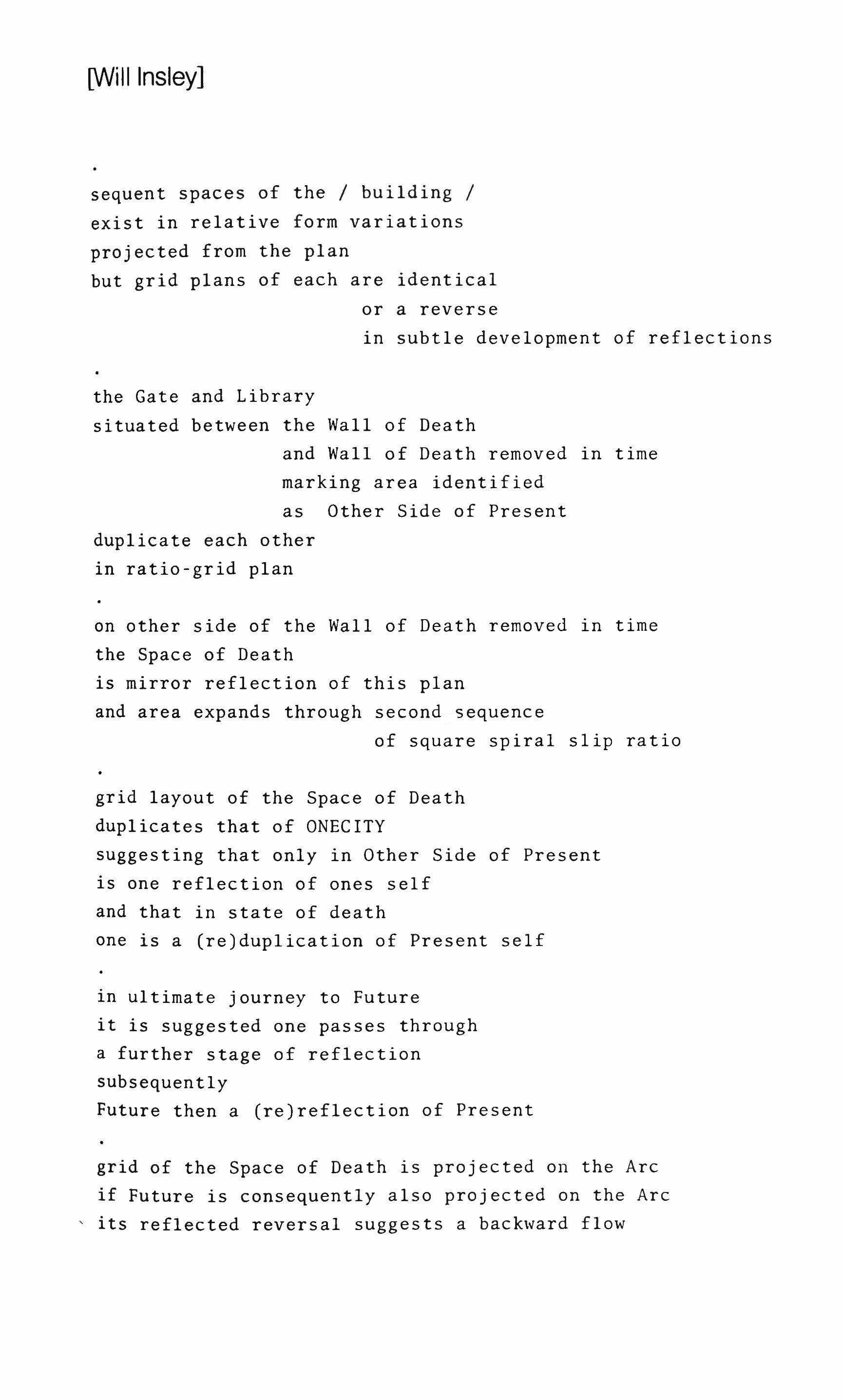
sequent spaces of the / building / exist in relative form variations projected from the plan but grid plans of each are identical or a reverse in subtle development of reflections the Gate and Library situated between the Wall of Death and Wall of Death removed in time marking area identified as Other Side of Present duplicate each other in ratio-grid plan
on other side of the Wall of Death removed in time the Space of Death is mirror reflection of this plan and area expands through second sequence of square spiral slip ratio
grid layout of the Space of Death duplicates that of ONECITY suggesting that only in Other Side of Present is one reflection of ones self and that in state of death one is a (re)duplication of Present self
in ultimate journey to Future it is suggested one passes through a further stage of reflection subsequently Future then a (re)reflection of Present
grid of the Space of Death is projected on the Arc if Future is consequently also projected on the Arc its reflected reversal suggests a backward flow
Insley]
[Will

Phil Berkman
City security: Chicago
Car ignition
Apt. building, front door
Apt., rear door
Car trunk
Apt., front door
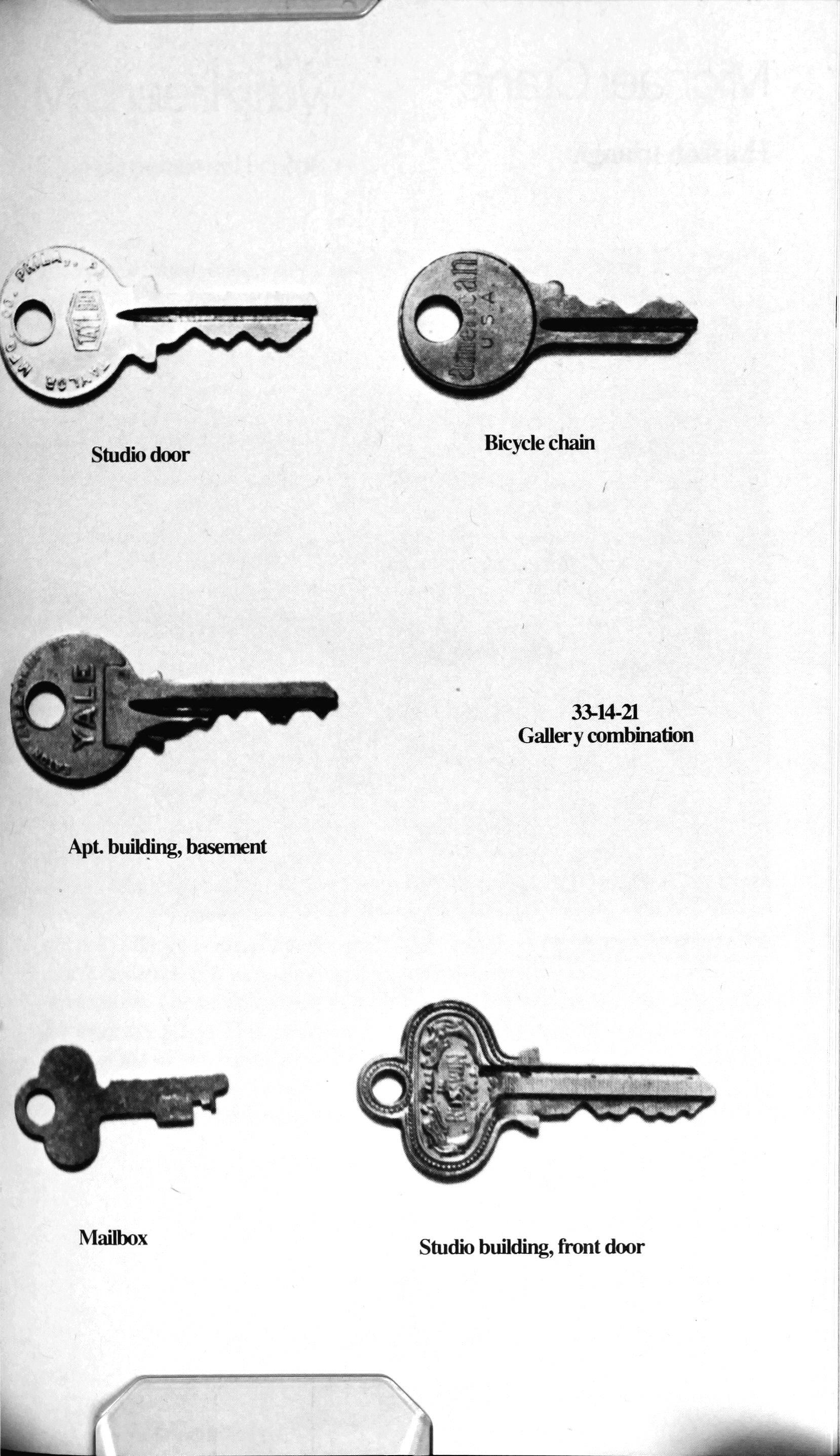 Studio door
Apt building, basement
Mailbox
Bicycle chain
33-14-21
Gallery combination
Studio building, front door
Studio door
Apt building, basement
Mailbox
Bicycle chain
33-14-21
Gallery combination
Studio building, front door
Michael Crane
Horizon triangle

'\ triangle formed by two viewers and the sun in line with the horizon
Michael Kirby
Two-dimensional sculpture
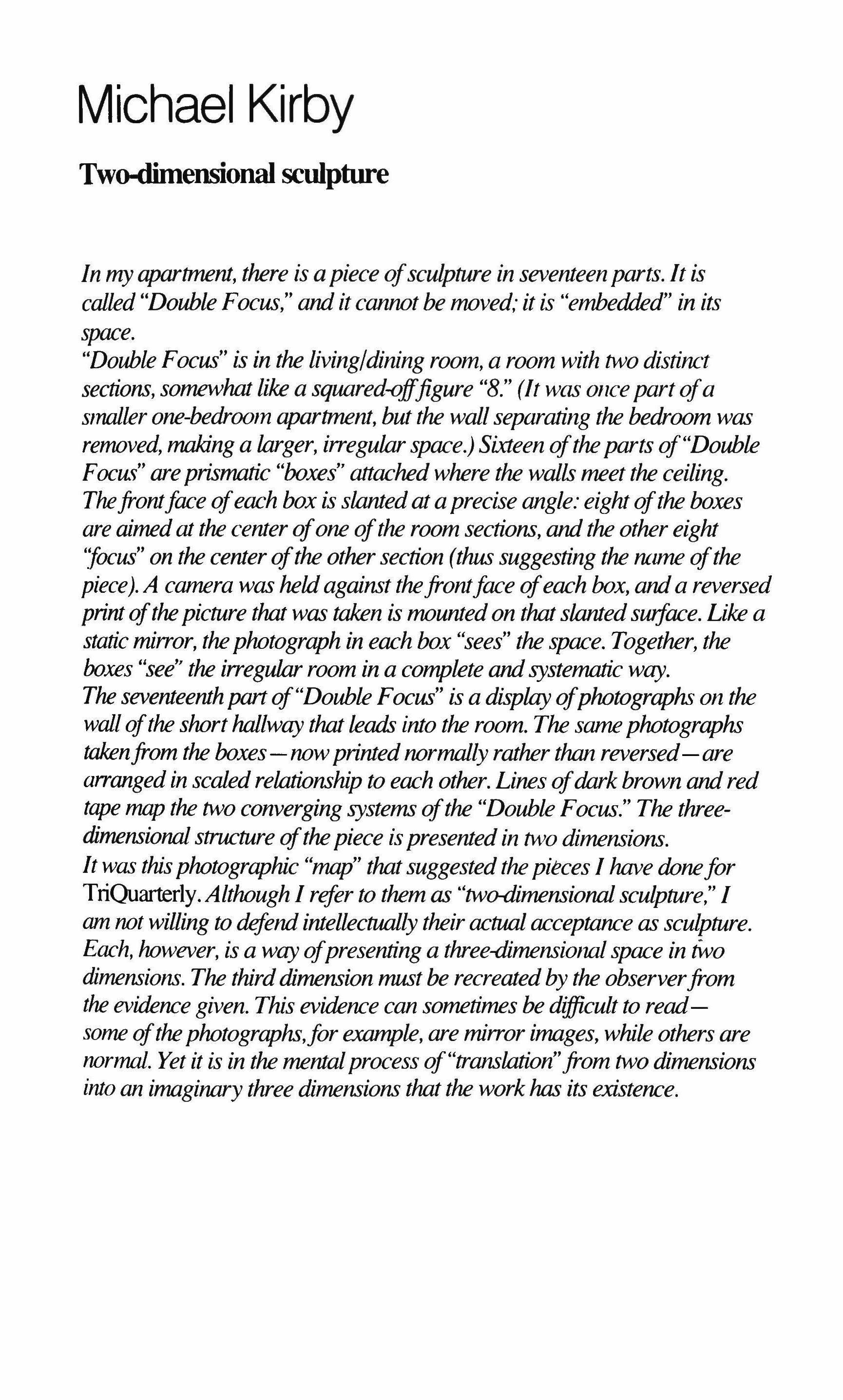
In my apartment, there is a piece ofsculpture in seventeen parts. It is called "Double Focus," and it cannot be moved; it is "embedded" in its space.
"Double Focus" is in the living/dining room, a room with two distinct sections, somewhat like a squared-offfigure "8." (It was once partofa smaller one-bedroom apartment, but the wall separating the bedroom was removed, making a larger, irregularspace.) Sixteen oftheparts of"Double Focus" are prismatic "boxes" attached where the walls meet the ceiling. Thefrontface ofeach box is slanted at a precise angle: eightofthe boxes are aimed at the center ofone ofthe room sections, and the other eight "focus" on the center ofthe other section (thus suggesting the mane ofthe piece). A camera was heldagainst thefrontface ofeach box, and a reversed printofthepicture that was taken is mounted on that slantedsurface. Like a static mirror, thephotograph in each box "sees" the space. Together, the boxes "see" the irregular room in a complete andsystematic way. The seventeenth part of"Double Focus" is a displayofphotographs on the wall ofthe short hallway that leads into the room. The same photographs takenfrom the boxes-nowprintednormally rather than reversed-are arranged in scaled relationship to each other. Lines ofdark brown andred tape map the two converging systems ofthe "Double Focus." The threedimensional structure ofthepiece ispresented in two dimensions. It was thisphotographic "map" thatsuggested thepieces I have donefor TriOuarterly.Although I refer to them as "two-dimensional sculpture," I am not willing to defendintellectually their actual acceptance as sculpture. Each, however, is a way ofpresenting a three-dimensional space in tWo dimensions. The thirddimension must be recreated by the observerfrom the evidence given. This evidence can sometimes be difficult to readsome ofthephotographs,forexample, are mirror images, while others are normal. Yet it is in the mentalprocess of"translation"from two dimensions into an imaginary three dimensions that the work has its existence.

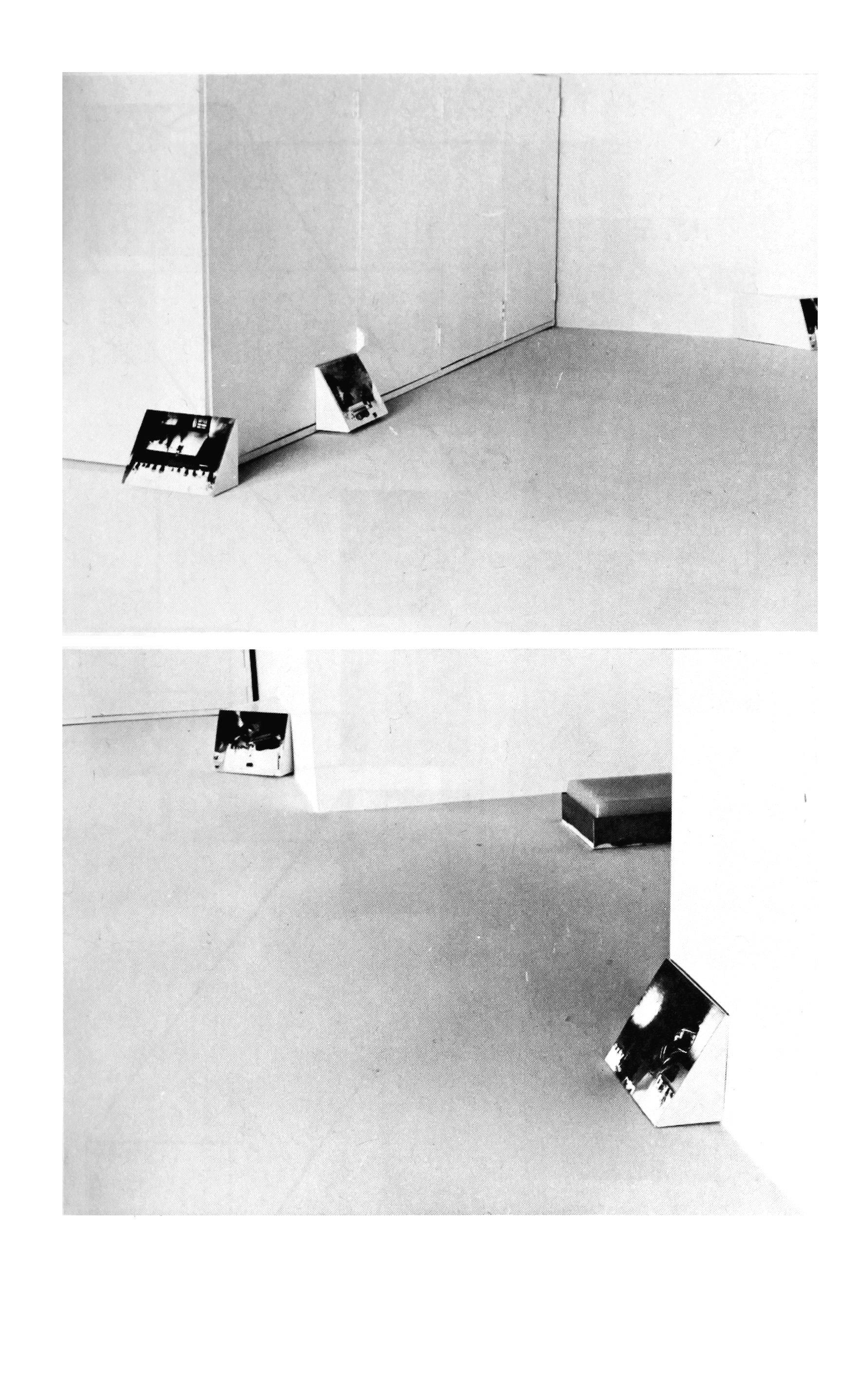

Cloisters April 17, 1974
i ::i
The
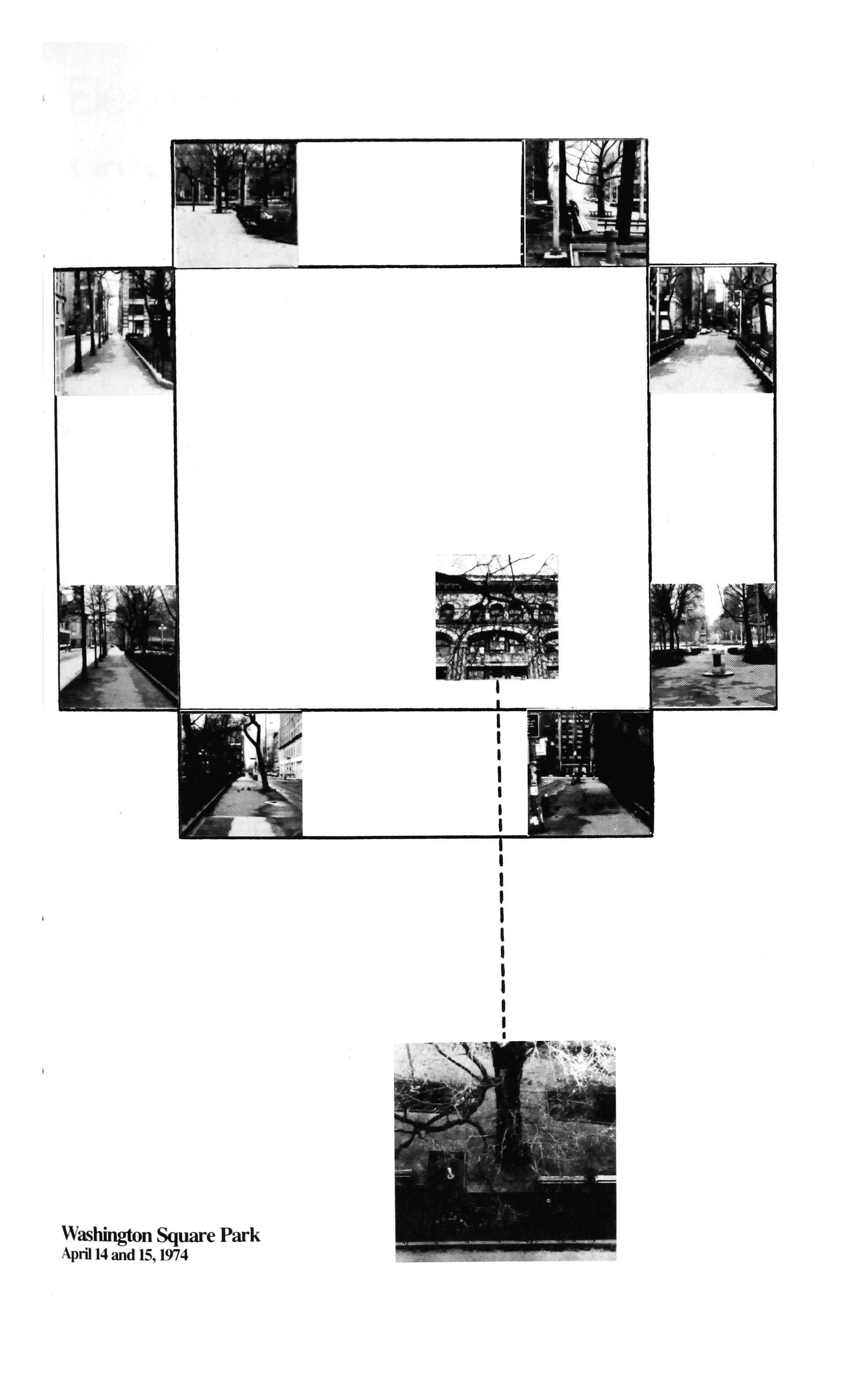
Washington Square Park
April 14 and 15, 1974
Stephen Zaima

Neon nature, 20 inches x 66 inches, 1971
DNribution piece, 1970-1971
Eleanor Antin
Carving: a traditional sculpture
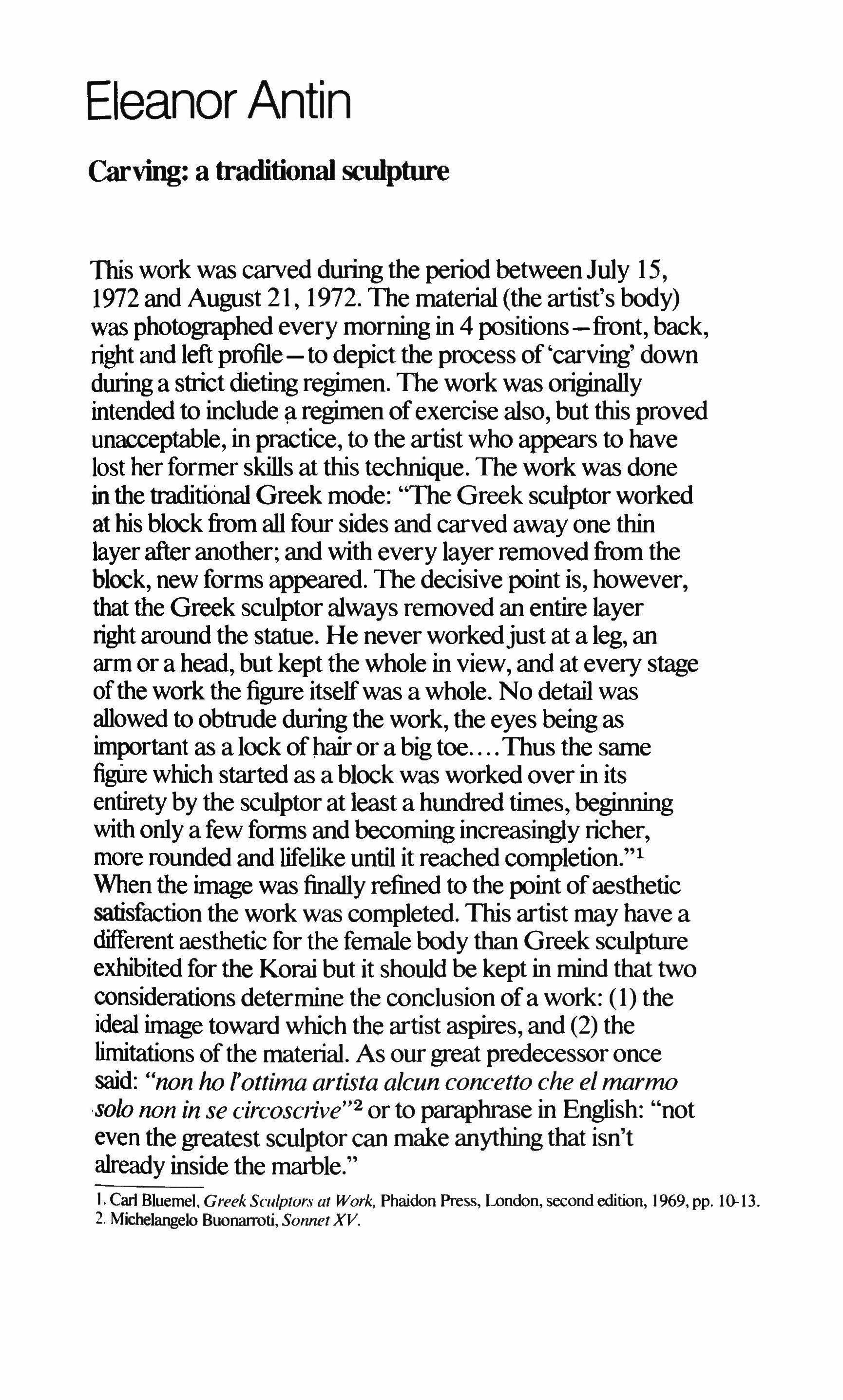
This work was carved during the period between July 15, 1972 and August 21, 1972. The material (the artist's body) was photographed every morning in 4 positions - front, back, right and left profile- to depict the process of'carving' down during a strict dietingregimen. The work was originally intended to include a regimen ofexercise also, but this proved unacceptable, in practice, to the artist who appears to have lost her former skills at this technique. The work was done in the traditional Greek mode: "The Greek sculptor worked at his block from all four sides and carved away one thin layer after another; and with every layer removed from the block, new forms appeared. The decisive point is, however, that the Greek sculptoralways removed an entire layer right around the statue. He never workedjust at a leg, an arm or a head, but kept the whole in view, and at every stage ofthe work the figure itself was a whole. No detail was allowed to obtrude during the work, the eyes being as important as a lock ofhair or a big toe Thus the same figure which started as a block was worked over in its entiretyby the sculptor at least a hundred times, beginning with only a few forms and becoming increasingly richer, more rounded and lifelike until it reached completion."! When the image was finally refined to the point ofaesthetic satisfaction the work was completed. This artist may have a different aesthetic for the female body than Greek sculpture exhibited for the Korai but it should be kept in mind that two considerations determine the conclusion ofa work: (1) the ideal image toward which the artist aspires, and (2) the limitations ofthe material. As our great predecessor once said: "non ho fottima artista alcun concetto che el marrno .solo non in se circoscrive"? or to paraphrase in English: "not even the greatest sculptor can make anything that isn't already inside the marble."
I. Carl Bluemel. Greek Sculptors at Work, Phaidon Press, London, second edition, 1969. pp. I(}.13. 2. Michelangelo Buonarroti, Sonnet XV.

[Eleanor Antin] ",

Renunciations (Choose 1)

In the winter of 1972, Fidel Danieli invited me to be in the first issue ofthe L.A. Artist's Publication, planned as an uncollated manuscript appearingquarterly, in which artists prepared work they found suitable for a multiple, instant print distribution system. Each artist was offered as many pages as she/he wished, provided that they could pay the $8 production fee per page. I've often wondered what a precise accountant like Jane Austen meant when she said a gentleman needed 200 pounds to marry. Or what did it cost a tenant to hand over 50 roubles to his landlord in a Dostoyevski novel? I think I understand what Rachel cost Jacob - 14 years ofhis life - but if a beautiful slave girl cost a rich Athenian 2 talents, what was she worth? 1 trireme or 6 oars?
Since money is a fluctuating metric that becomes nearly meaningless as the distance from the time ofits use and the life ofits user increases, I decided to measure the actual cost of an $8 "art" work in terms ofmy own life costs at that particular time in my particular space.
[Eleanor AntinI
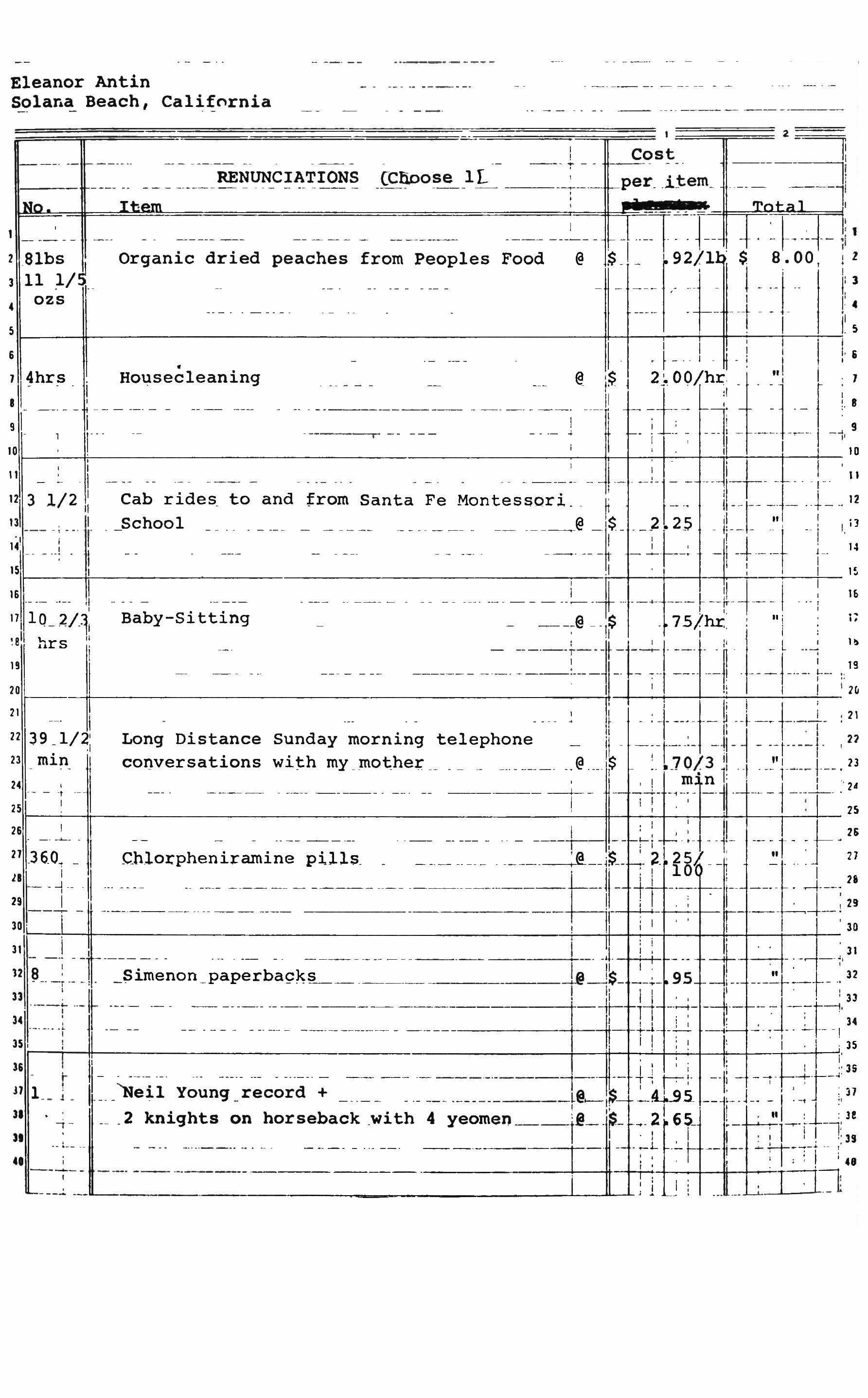
Eleanor Antin �olan� Beach,
II � � � _So s !: RENUN_C!�T!_�� _{f_li.oo�_lL "T �per. i.tem_ IN" T m Housei:leaning 1 Slbs II 11 1/5 ozs Organic dried peaches from Peoples 6 :I�hrs. 91-I 1," IOI� �� �+-� -r-r� +--+ 1113 1/2 Ii 13 1 141--�·i'.- r IS 1 16 I ,I 17 lL21.1: ::11 hrs 1'1 20 I 111'0-'-II ------___,..-+----->-----+---,--,-� ::,3_m91.:nl,_12;1 Long Distance Sunday morning telephone conversations with my mochez; @ 14 - -"t - --+---IS @ Cab rides. to and trom Santa Fe _School II - -1Baby-Sitting 16 3& Jll__;_ ,31 _L_
California
1/3
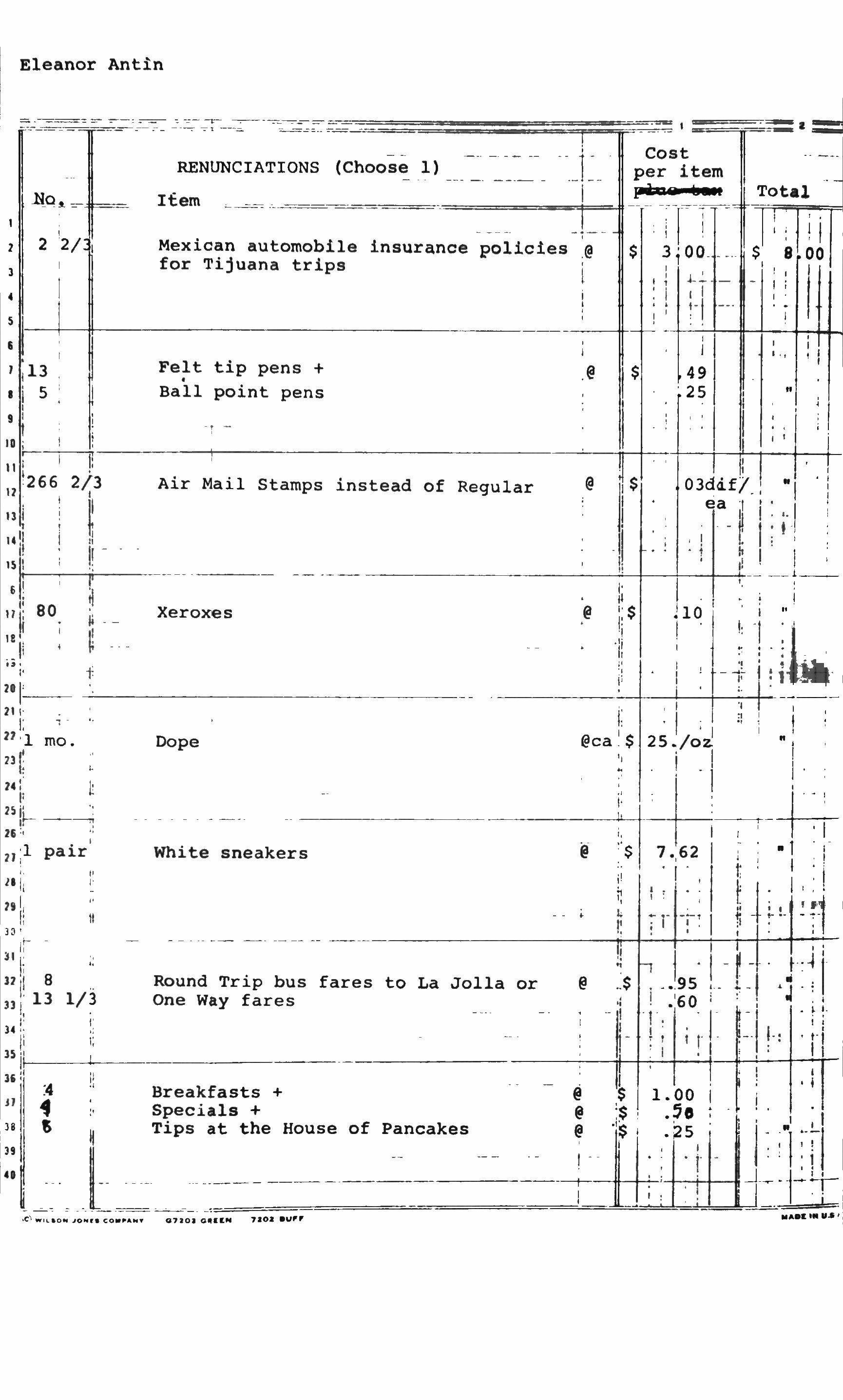
Breakfasts + Specials + Tips at the House
of Pancakes
Eleanor Antin �=�� ��.� �:�::I�T�';;:I�O-�N����-':';;(�C:=h�o�o:::;;s:::;;e;;;;;;l:::;;)::_::._=.-=�;:_-=_=�-=;;;'-:;::_:::;;;:::;:;;;il::;:::jF�::;;;����=--. =.� _;_ ,.miT': Fi� i I Mexican automobile insurance policies @ $ 3 i 00 $ 8 00 for
trips i'" I ,�J.':'- i t :, I,' I I � � - t I II-�--*-----------------------------------------_------�·'_1 ,13 I i 5 I 9 I Item 4�1 i I" I I Felt tip pens + @ 1$ Ball point pens 251 I : I I I II, II ! Air Mail instead of @ r 03dd.f/., -, Stamps Regular ea I i: I - � -II I;' - i h ! I h Ii 1 I '. I' II Xeroxes @ ;:$ 110 i ,.I \ I, 1 :' -I: � :-:h. I '. I , ! : t - �� 1 : 1 Ii I I , \: rt , .,@ca'$ I Dope 25.foz. I I ! '1 � I
Tijuana
White sneakers
Round Trip bus fares to La Jolla or One way fares
L�_

Jan Sullivan
Snowworks
Nancy Holt
Views through a sand dune
Narragml.'iett Beach, R.I.
1972

[Nancy Holt]
Mirrors oflight
10 mirrors (91,h-inchdiameter)
6SO watt quartz light
1973-1974

� %J • • • • • • • J ) ) • •

[Nancy Holt]
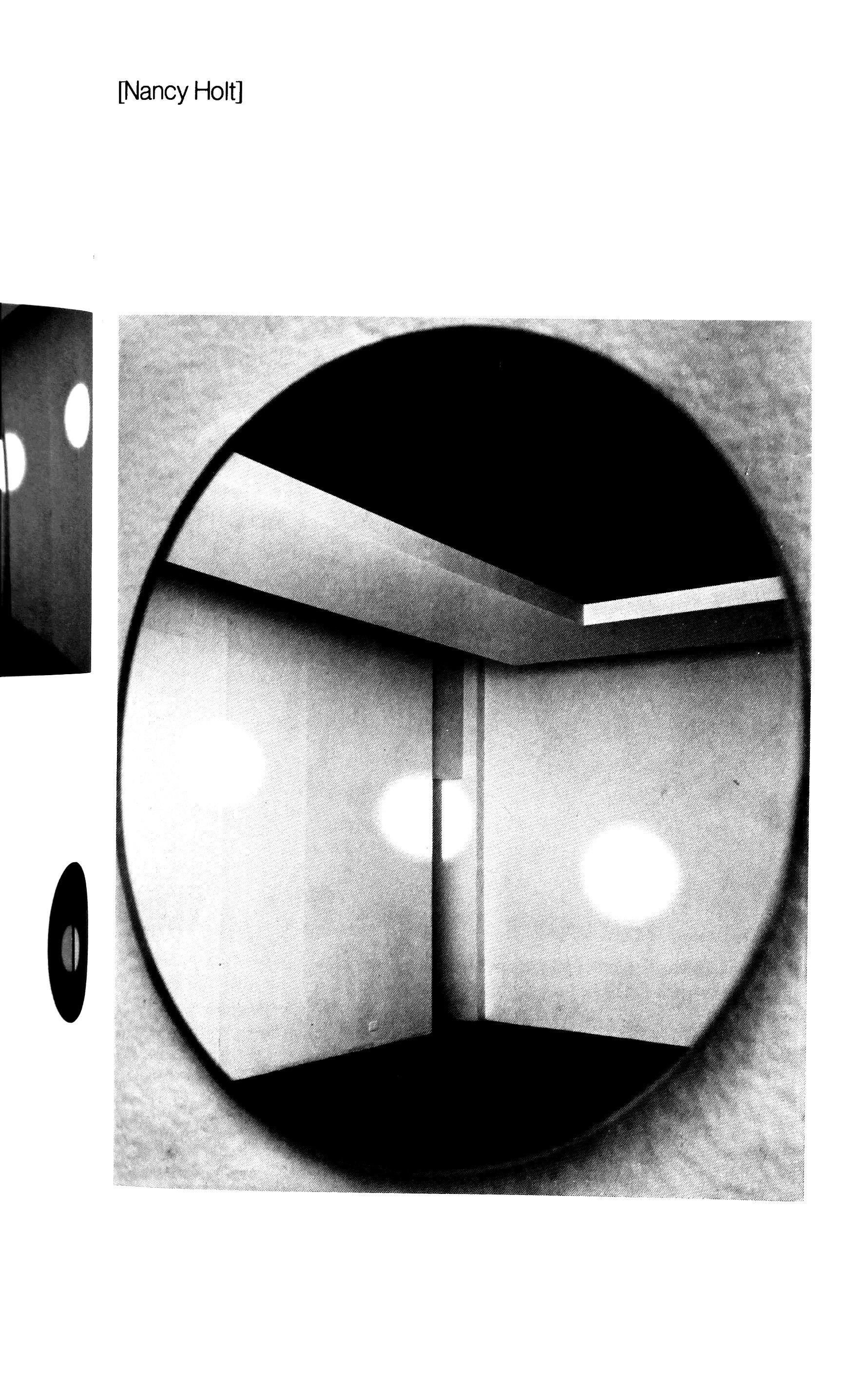
[Nancy Holt]
Adrian Piper
The mythic being

DDAY WA� 'BUFlE.'S PART'/. NOW I'M �UR£ \ LIKE. f\C>'8BIE MUC.H MORE THAN (..L)'OC) BUT I Tl11NK l\O'B-e,IE. l-\KES ME 1 AND uz EQuAl-L"I. I STII-L.. �
LI KE: (_LY DE. A L-ITTL..E I Bur NOT VE.R.Y Muc..H, AND 1'M SURE. THE. FEE1-1 N& IS N\UTUAL.�
-=
wi
\O·\,�·
The MythicBeing, Cycle ll, October, 1961
[Adrian Piper]
Notes on The mythicbeing

A personfrees himselffrom himselfin the I'ery act by which he makes himself(Ill objectforhimself.
Jean-PaulSartre. Being and Nothingness
1
Each month, I select a passage from thejournal which I have been keeping for the last twelve years. This is done on a systematic basis, The passage is called a "mantra."
The visual image ofthe Mythic Being appears publicly on a monthly basis in the Village Voice on the Gallery Page, The mantra is reascribed to the personal history ofthe Mythic Beingby its appearing as the content ofhis thought in the thought balloon.
During that month, the mantra and the autobiographical situation which provoked it become an object ofmeditation for me. I repeat it, re-experience it, examine and analyze it, infuse myselfwith it until I have wrung it ofpersonal meaning and significance. It becomes an object for me to contemplate, and simultaneously loses its status as an element in my own personality or subjecthood. As my subjecthood weakens, the meaning ofthe object thus weakens, and vice versa The end result is that I am freer for having exhausted it as an important determinant in my life, while it simultaneouslygains public status in the eyes of the many who apprehend it. The experience ofthe Mythic Being thus becomes partofpublic history, and is no longer a part ofmy own.
2
I beganby dressing in the guise ofthe Mythic Being and appearing publicly several times during the month (reascription ofmy thoughts and history, sentence by sentence, to a masculine version ofmyself; myselfin drag). I now consider shelving this aspect ofthe piece for fear that the Mythic Being will gradually acquire a personal autobiography ofexperiences and feelings as particular and localized - and limited -as my own. This was the misfortune of Rrose Selavy. My behavior changes. I swagger, stride, lope, lower my eyebrows, raise my shoulders, sit with my legs wide apart on the subway, so as to accommodate my protrudinggenitalia
My sexual attraction to women flows more freely, uninhibited by my fearoftheir rejection in case my feelings should show in my face; unencumbered by my usual feminine suspicions ofthem as ultimately hostile competitors for men. I follow them with my eyes on the street, fantasizing vivid scenes oflovemaking and intimacy.
My sexual attraction to men is complicated and altered by my masculine appearance. I envision the possibility ofdeep love relationships based on friendship, trust, camaraderie, masculine empathy; but I instinctively suppress expression ofmy sexual feelings for fear ofalienating the comparatively tenuous feelings ofkinship with men I now have.
[Adrian Piper]

How might I be different if the history I chronicled in myjournal had happened to a man? My adolescent preoccupations with men would have been infused with guilt; my conflictingfeelings and behavior towards my girlfriends would have been viewed with alarm by my parents: my stints as model and discotheque dancer would have schooled me in the subtle arts oftransvestitism; my period in a mental hospital would have included attempted reorientation ofmy adolescent homosexuality; my drugexperiences might have been more traumatic and conflict-ridden. perhaps more sexually than mystically oriented. Has this part ofthe piece taught me about myself. or about the Mythic Being?
3
The Mythic Being is or may be-
An unrealized but possible product ofthe particular history ofevents I in fact underwent. a necessary alternative to the limits of my sense ofself; An abstract entity ofmythic proportions. whose history is a matter ofpublic knowledge. and whose presence and thoughts are dispersed over the totality of individuals who apprehend him in the Voice;
A nonmaterial art object, unspecified with regard to time or place, the bearer ofa finite number ofproperties, the number and quality ofwhich are circumscribed by my own life, and acquired co-extensively with my growth into a different person; A product ofmy own self-consciousness, and unlike other pieces I have done in not being the generator ofmy self-consciousness:
A therapeutic device for freeing me ofthe burden ofmy past. which haunts me, determines all my actions, increasingly habituates me to the limitations ofmy personality and physical appearance.
4
A conceptual problem: I find it difficult to figure out what this piece is really about, ifit is really about anything, because it is not one in a series ofsimilar pieces over which I can generalize. Because this is the only one ofits kind that I have worked on since last September, I have no way offinding out what it has in common with other such pieces (although I can say things about its relationship to everything I've done in the last few years), thus no way ofknowing what direction it represents to me, nor what I intend bydoing it. All my speculations about it thus seem inconclusive to me: I have the feeling that I will never be sure ofwhat it is I'm really up to. And I will deliberately resist the temptation to find out bydoing derivative or "spin-off pieces based on it. There must be other ways.
March,1974
Robert Barry
Untitled piece
April,I974
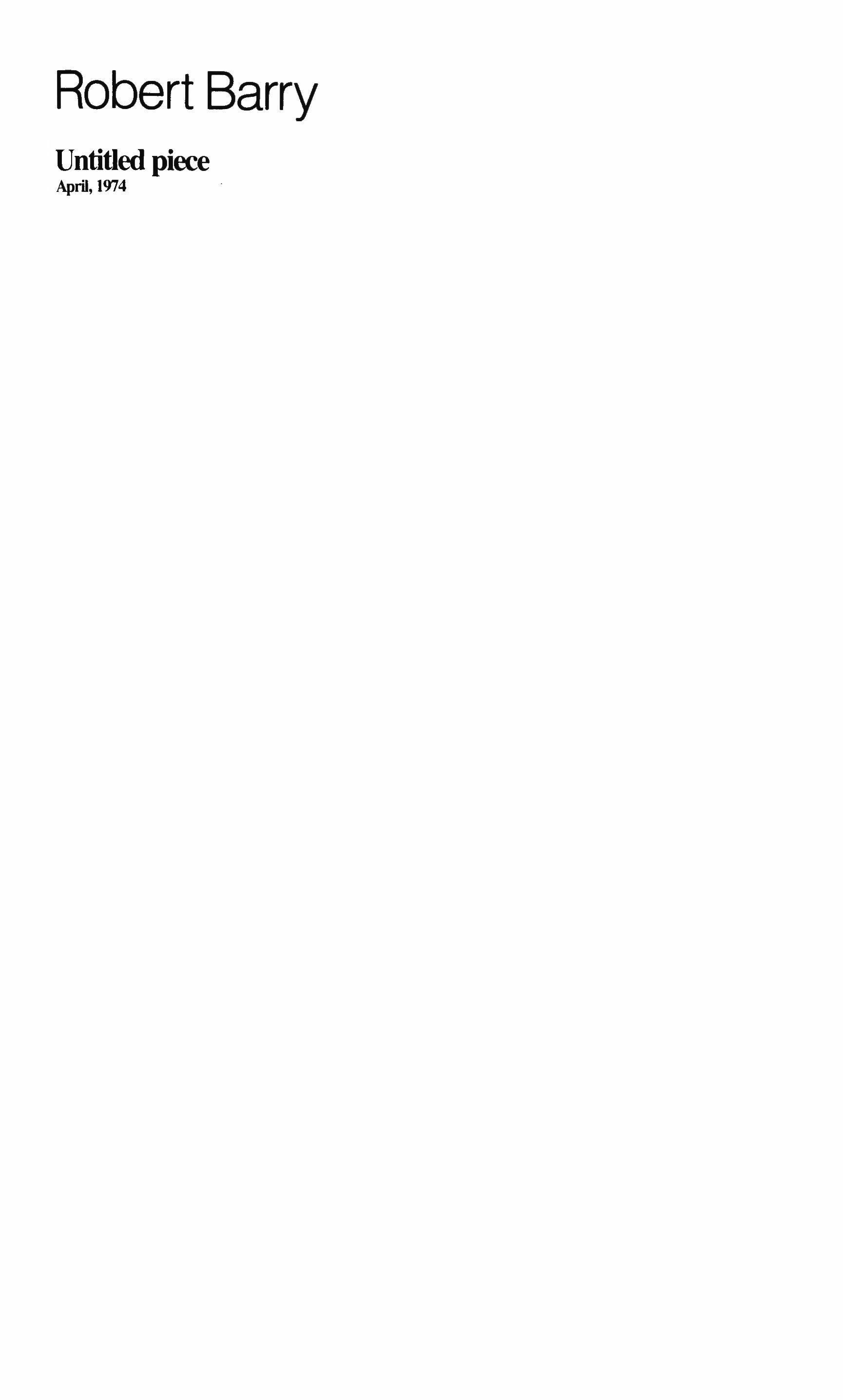
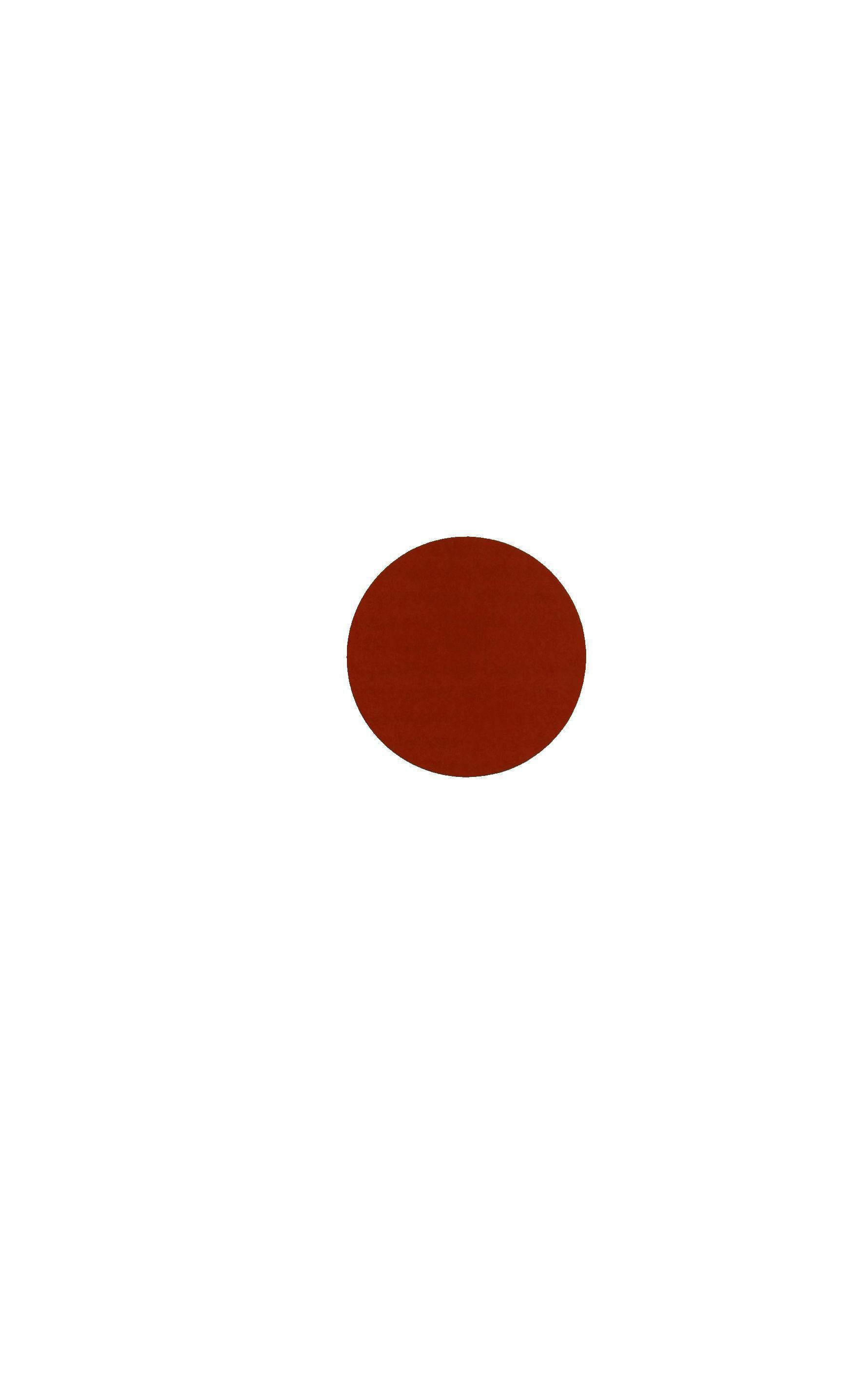

exhaustive
blatant askew spoof
flout
lovelorn
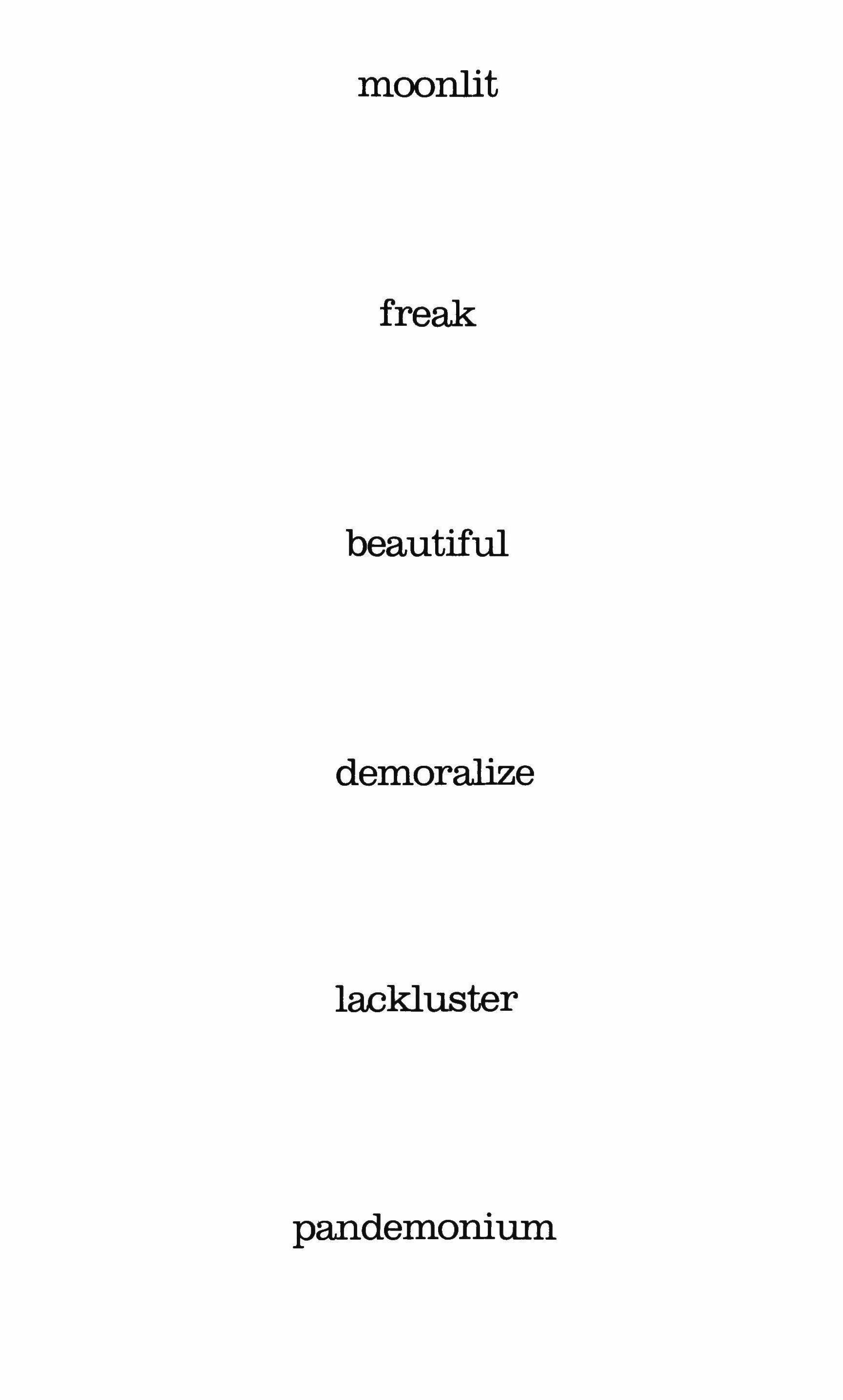
moonlit
pandemonium
freak beautiful demoralize lackluster
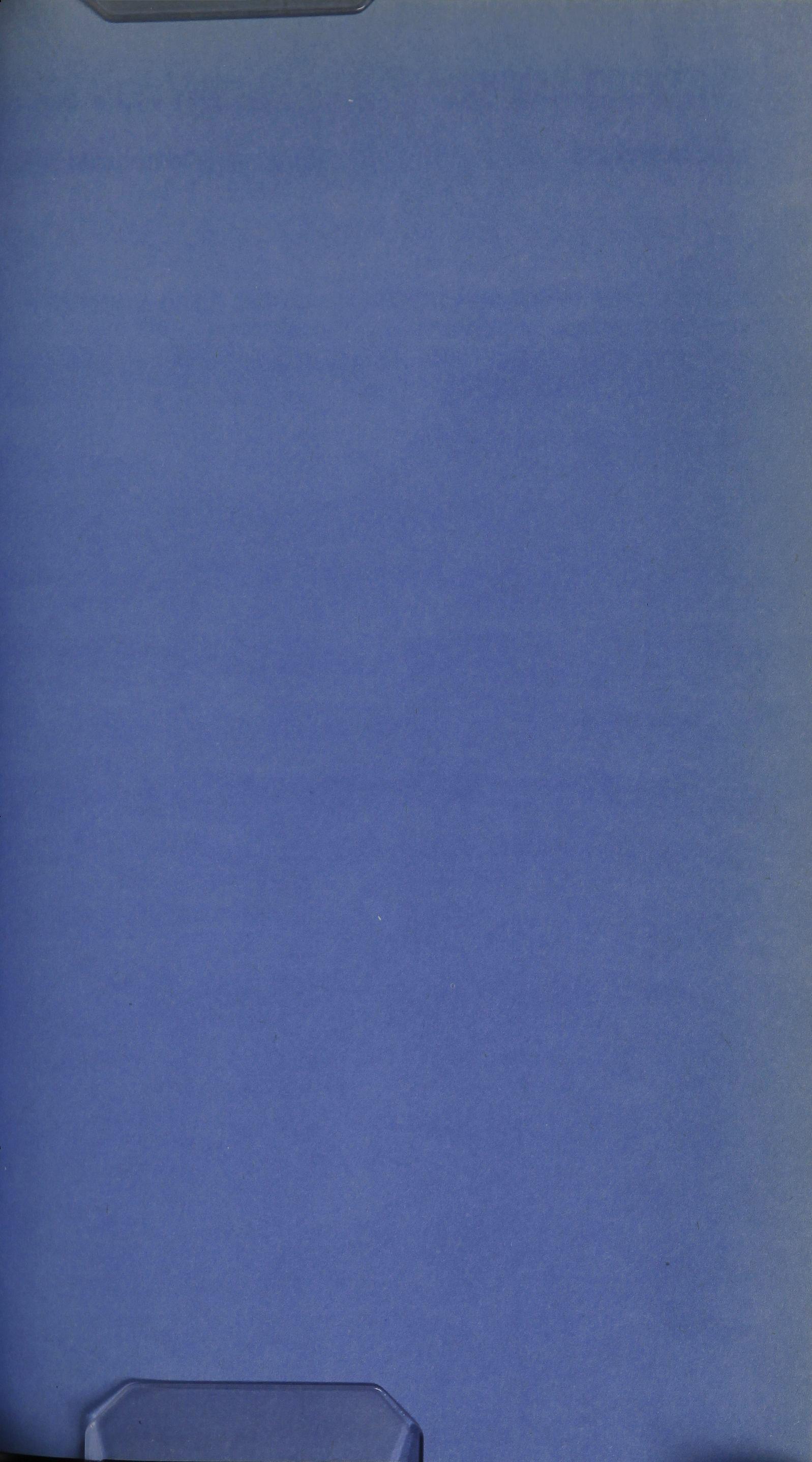

Richard Long
1974
Line in Ireland
Sol LeWitt
The location of a rectangle

A RI?:CTAtv6L£ WU ILI-I is poR-fVI£O ANI) £/vCLOSEJ)
B\-j rout<. L..!tJES I ntf PIRsr DF' WH'(;H I� DRt}wrJ
FQoM It POiN; 111+1.-- pw/t11 BOWE£7IJ A POJl[Jr
)+7+LF/;1)� �£j1A)£t:A.J 11tt cetcttt: O� -nit p;Jf:£
(SQu!i-R£ OQ W/fLL) /1--(vb ntE UPPeR. LEFT Wf2A)-
1:;72. 4(00 1ttE (Vl1 DPO/,vi OF T11£ LEP-, stce fJlVD
1l1£ UPPt'/2. LEP, COI<-AJiEfl.. TD A f:O/NlI11JL;:W�
B£7WfEN 711£ fvl JDPoIAfr OF rm: TVP SfDE !1-IJD
i11E VPPER 1<1 bH-T Wf2-NE1<.1 me JEZON'D t-JN£
PRoM A PoINT ItRLPWff-Ai BElWffTV n-tt ST7H2r
oP nt£ FIRSr LJN� AND A YDlfIJT H1}LI=WAVj BfT
VVCt.1\J 7t1E MID POJNr Dr=- 11tE .W� SIDE A-ND 77tE
VppEJ2_ LEPr CoeNm TD A po IfvT H1tL7=WAL1
BETWEEN 11tE C£1VTl:--(L OF � P�6E (SQUIrR£ ore W/tLL) AND 11t£ L.OfNaL La., CORNEl( 4No
T1tE MID oo(AIr DF 111£ �(fr'1'/)M Sl DE. 1HEn-Il RD
LlrvE r:: �M A 'POINf rn9L.f:ltvf111 � 4pO INT" � L FwI'Y'1 [)eTVvE:Erv 't1t"E J'T""1her OF T11£ rlesr L{ Il£ A-IVD Tl1E. £ND OF rJ11l:: �7A)f\)D '-INc
ANO A FDIll/, H1fLRNt¥} B£VvVI::.'""'CN 11:tE M IDPtJ//IJI OF TIt£" Lq:r J IDE I'9iVD 11� wwerL LEFT UJANm
TD It POI/l!( 1/1) I-f'C l-J I� OAJ AN A-YIS 'Gc'1WrrtJ �- �wt:(2_ LSF r UJI2NE:f( 17) A 'POIIVT f-(qL�-
Vv Rtf BervvaN 'tvn: (VIIDPoINT o f- Tr1f" R 16M
Sl'Dt' /tfvD TH£ UPPC12 «I bHT t[)(2N£R. /A;�£ A
L.-/NE DRAWtv' F'l3Ofvt TIfE C8VTa< OF THE PfME (SG< LJ PrR E 0 YC u:ftLL) IV ,4 to. A.Jr 111+LF/II.;/J-Lt
BETvvrrN ntE /'v11 DfoiAlr- 0/= '1l-tc£ R{ 6t-fi SIDE
ANI) 1ltE Loltver2 RI bH T W(cIV/F:Q WDUL D
CRoSS T'l-MT A XIS 77-tE Four<-.n+ ut«: Fi2CM I It PDINT EQ0lDISTA-PJI Fl20N 111£ EJVD or-
THe G)-HR D LIAJE I THE EIv D OF nt£ SE(.L)IIJD
LINE AfVb A P"DINr ;,rnLtWIf11 t1�EE:N 14-
POINT' J-mLr/llJJC11 J)£WEt}\) ntt GEruTER r2F '11-re" PI) ce ist; U(tRe or< Vv4L-L) 17--/VD rue M(V-

[Sol
LeWitt]

Po I rJ t () 'F TIm; 'BOiTD M S(D£ It-fl/O 1+ roIsrt:
AALl='/Nt'Y1 5-ETlNrrN 11it M I'D PoIII), 0 F- 711£
13oT7DM SIDE !!-ND TH£ LOltvey(. RI u+t W(2Nc"'e..
10 A fOl NT rrALn-v41j BE/WU/lJ 'J11E ST(f-(2TaF
:t'ttE )EWfVD LI IVE A-fVO A po fNT � H1::'lZe J4 L;tV�
WOULD crDSS 171E: t::l res, LI «e I FIT wEJ2£
DRAwlIJ PeoM TIn (Vl/ D(}oIIVT 0 t= JlfE (2lbtfr
S (DE TO !+ P D( N T i-m L Pwf-Y'1 BEVbVLTV 111£
fV1 IDPoII(){Of:: T7� �p SfDC: /tf}O tin: UPPl::.Y<
LEFT W12f\JtJC I 5CL LLlvlTT/1,4FV2IL '2:;-; (Cf7l{ ,
[Sol LeWitt]

Robert Smithson
Spiraljetty
Great Salt Lake, 1'170
 [Robert Smithson]
[Robert Smithson]
Diameter 150 £eel Teeo Lake, 1973
Amarillo ramp

Joseph Kosuth
TJtJed (Art as idea as art) 1966


Joseph Kosuth
Titled
1%6
(Art as idea as art)
[Joseph Kosuth]

The seventh investigation (A.A.I.A.I.)
1969
1. Rawn im aIIgemeinen
Bern, Sonntag, 9. Min 1969
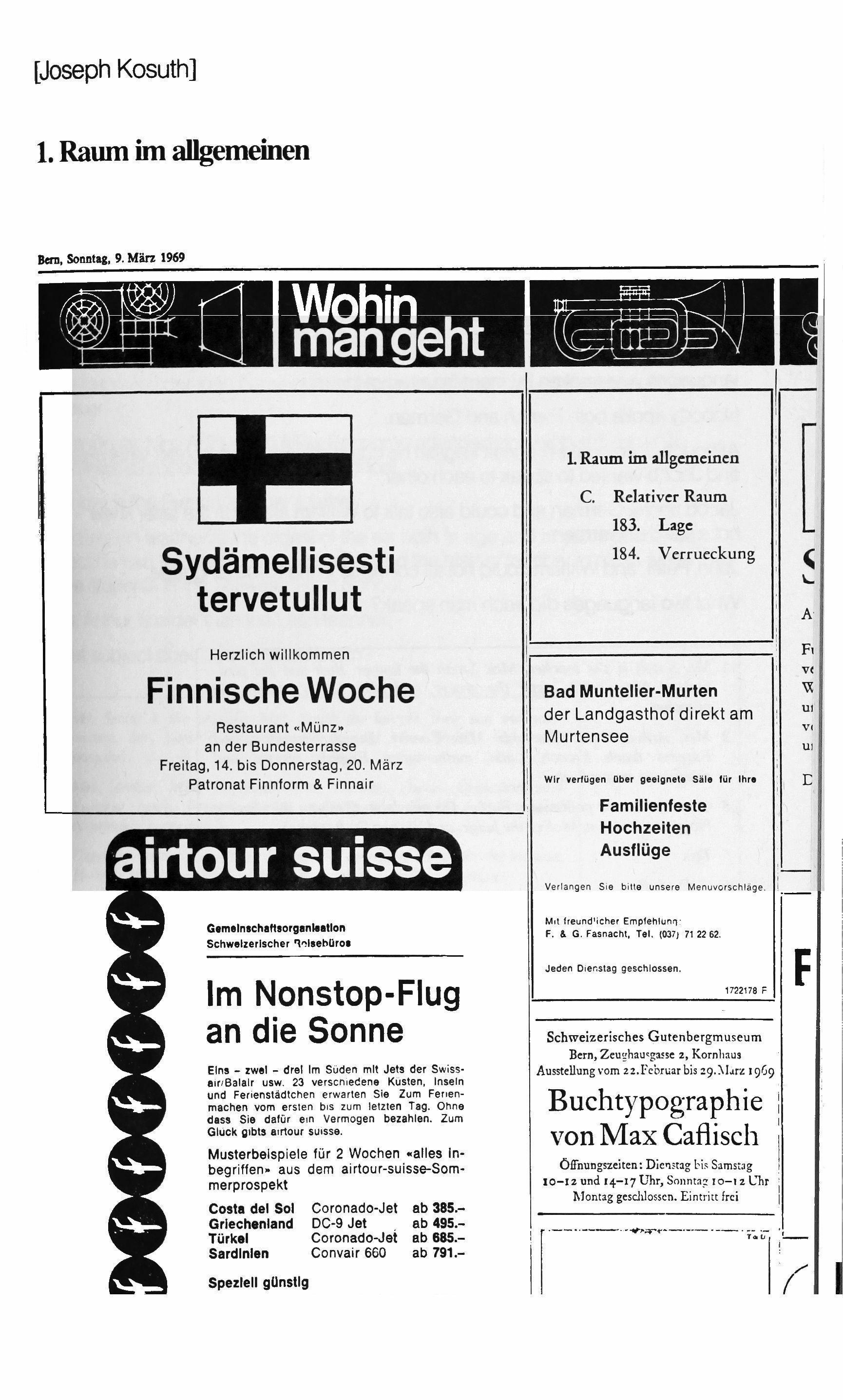
Sydamellisesti tervetullut
Herzlich willkommen
Finnische Woche
Restaurant -Munzan der Bundesterrasse
Freitag. 14. bis Donnerstag. 20. Marz Patronat Finnform & Finnair
L Raum im allgemeinen
C. Relariver Raum
183. Lage
184. Verrueckung
Gtmelnlcha"sorganloltlon Schwelzerlscher 'l."!llebOrOI
1m Nonstop-Flug an die Sonne
Elns - zwel - drel 1m Suden mit Jets der SwissairJ8alair usw. 23 verscniedene Kusten. Inseln und Feriertstadtchen erwarten Sis Zum Fenenmachen vom ersten brs zum letzten Tag. Ohne dlss Sie daWr em Vermogen bezahlen. Zum Gluck glbts amour suisse.
Musterbelspiele fur 2 Wochen -atles Inbegriffen. aus dem airtour-suisse-Sornmerprospekt
Costa del Sol Grlechenland TUrkel Sardlnlen
Spezlell 9Unsll9
Coronado-Jet ab 385.DC-9 Jet ab 495.Coronado-Jei ab 685.Convair 660 ab 791.-
Bad Muntelier-Murten der Landgasthof direkt am Murtensee
Wlr verfugen uber geelgnete Sale fur Ihr. r Familienfeste
Hochzeiten
Ausfliige
Verlangen Sie b.tte unse-e Menuvorscbtaqe
Mil Ireund'Icber Empfeh'un� F. & G. Fasnacht, Tel. (037) 71 2262.
Jeden Oier.slag geschlossen.
1722178 F
Schweizerisches Gutenbergmuseum Bern, Zeugbaasgasse 2, Kornltaus Ausstellung vern az.Fcbruar bis :!9.)'1J.rz 1969
Buchtypographie von Max Caflisch
Offnungszeiten: Dic'1s.rag l-is Samstag IO-IZ und 14-17 Uhr, Sonnta;! 10-12 Chr Montag geschlosscn. Eintritt Irci
[Joseph Kosuth]
I ,...........___-----�I.----_,I[ -Wohin htmange
F
A v.
UI VI UI
[Joseph Kosuth]
1

In one of the famous resort towns of Europe, where tourists from a dozen countries may always be encountered, four travelers once struck up an acquaintance. They were of different nationalities and although each man could speak two of the four languages, English, French, German, and Italian, there was still no common tongue in which they could all converse. In fact only one of the languages was spoken by more than two of the men.
Nobody spoke both French and German.
Although John couldn't speak English he could still act as interpreter when Peter and Jacob wanted to speak to each other.
Jacob spoke German and could also talk to William although the latter knew not a word of German.
John, Peter, and William could not all converse in the same language.
What two languages did each man speak?
I Mr. Smith is the teacher, Mrs. Smith the lawyer, their son the postmaster, Mr. Smith's sister the grocer. and Mrs. Smith's father the preacher.
2 Mrs. Arthur. Miss Bascomb, Mrs. Conroy, Duval. Eggleston. and Furness teach French. Latin, mathematics. English. history. and economics. respectively.
3 Clayton was the policeman. Forbes the murderer. Graham the witness. Holgate the victim. McFee thejudge, and Warren the hangman.
4 Ten.
SCDAB Y x W z
6 Jones and Smith but not Brown.
7 ABC D Y X W Z
8 Mitchell teaches French and history. Morgan teaches biology and English. and Myers teaches economics andmathematics.
9 Jacob spoke German and Italian. John spoke French and Italian. Peter spoke English and French. and William spoke English and Italian.
[Joseph Kosuth]
2

In the Stillwater High SChool the economics, English, French, history, Latin, and mathematics classes are taught, though not necessarily respectively, by Mrs. Arthur, Miss Bascomb, Mrs. Conroy, Mr. Duval, Mr. Eggleston, and Mr. Furness.
The mathematics teacher and the Latin teacher were roommates in college. Eggleston is older than Furness but has not taught as long as the economics teacher.
As students, Mrs. Arthur and Miss Bascomb attended one high school while the others attended a different high school. Furness is the French teacher's father.
The English teacher is the oldest of the six both in age and in years of service. In fact he had the mathematics teacher and the history teacher in class when they were students in the Stillwater High School.
Mrs. Arthur is older than the Latin teacher. What subject does each person teach?
I Mr. Smith is the teacher, Mrs. Smith the lawyer, their son the postmaster, Mr. Smith's sister the grocer, and Mrs. Smith's father the preacher.
2 Mrs. Arthur, Miss Bascomb, Mrs. Conroy, Duval, Eggleston, and Furness teach French, Latin, mathematics, English, history, and economics, respectively.
3 Clayton was the policeman, Forbes the murderer, Graham the witness, Holgate the victim, McFee thejudge, and Warren the hangman.
4 Ten.
5 CD A B Y X W Z
6 Jones andSmith but not Brown.
7 ABC D Y X W Z
8 Mitchell teaches French and history, Morgan teaches biology and English, lind Myers teaches economics andmathematics.
9 Jacob spoke German and Italian, John spoke French and Italian, Peter spoke English and French, and William spoke English and Italian.
[Joseph Kosuth]
3

Bertrand Russell in a whimsical moment once defined mathematics as the subject in which we never know what we are talking about, nor whether what we are saying is true," and here is a puzzle of which the same thing might be said. As a simple exercise in abstraction suppose that four meaningless symbols A, B, C, and 0 correspond in one order or another to the equally meaningless symbols W, X, Y, and Z; and suppose further that
If A is not X, then C is not Y. If B is either Yor Z, then A is X.
If C is not W, then B is Z. If 0 is y, then B is not X. If 0 is not X, then B is X.
In what order do the two sets of symbols correspond?
I Mr. Smith is the teacher, Mrs. Smith the lawyer. their son the postmaster. Mr. Smith's sister the grocer. and Mrs. Smith's father the preacher.
2 Mrs. Arthur. Miss Bascomb, Mrs. Conroy. Duval. Eggleston. and Furness teach French. Latin. mathematics. English. history. and economics. respectively.
3 Clayton was the policeman. Forbes the murderer. Graham the witness. Holgate the victim. McFee thejudge, and Warren the hangman.
4 Ten.
SCDAB Y X W Z
6 Jones andSmith but not Brown.
7 ABC D Y X W Z
8 Mitchell teaches French and history. Morgan teaches biology and English. andMyers teaches economics and mathematics.
9 Jacob spoke German and Italian. John spoke French and Italian. Peter spoke English and French. and William spoke English and Italian.

[Joseph Kosuth]
The fifth investigation
1969
�tion 11, modified 1974)
Opening question: what is the quantity of contexts?
1st Level: Specifics ('content'; apparent meaning)
2nd Level: The Games' Game (choice in relation to 'content')
3rd Level: The Games' Game's Game (choice in relation to context)
4th Level: Consideration of and comparison with information/propositions (art) apparently presented on a same or similar level or context
A. In the immediate vicinity of this installation.
B. Current exhibition.
5th Level: 'Meaning'
A. Responsibility (Joseph Kosuth)
B. Cultural believability/acceptability (generalization necessity as an aspect of information transferral & 'relevancy')
C. Relevancy (simultaneous 'internal/external' heuristic device-myth'decoder', myth-maker & myth)
7th Level: (2nd question)
A. Would an error be relevant to any of the existing contexts?
B. Would any existing context provide a framework for 'proof?
C. Would consideration of the concept of a context be a context added to all of these contexts?
D. Can notions of experience be isolated as a context in a way which would be relevant to the existence of this material as art?
E. Is one capable of considering more than one level at a time?
F. Does a consideration of one context (level) allow one an iconic sense or use of any or all of the others?
G. Are the questions in "A through F" altered by their grouping together under the 7th Level?
H. CoUld Section 'G' of the 7th Level be the 8th Level?
I. Could Section 'H' of the 7th Level be the 8th Level?
J. Could Section 'J' of the 7th Level be the 8th Level?
K. Could the absence of an 8th Level be the 8th Level?
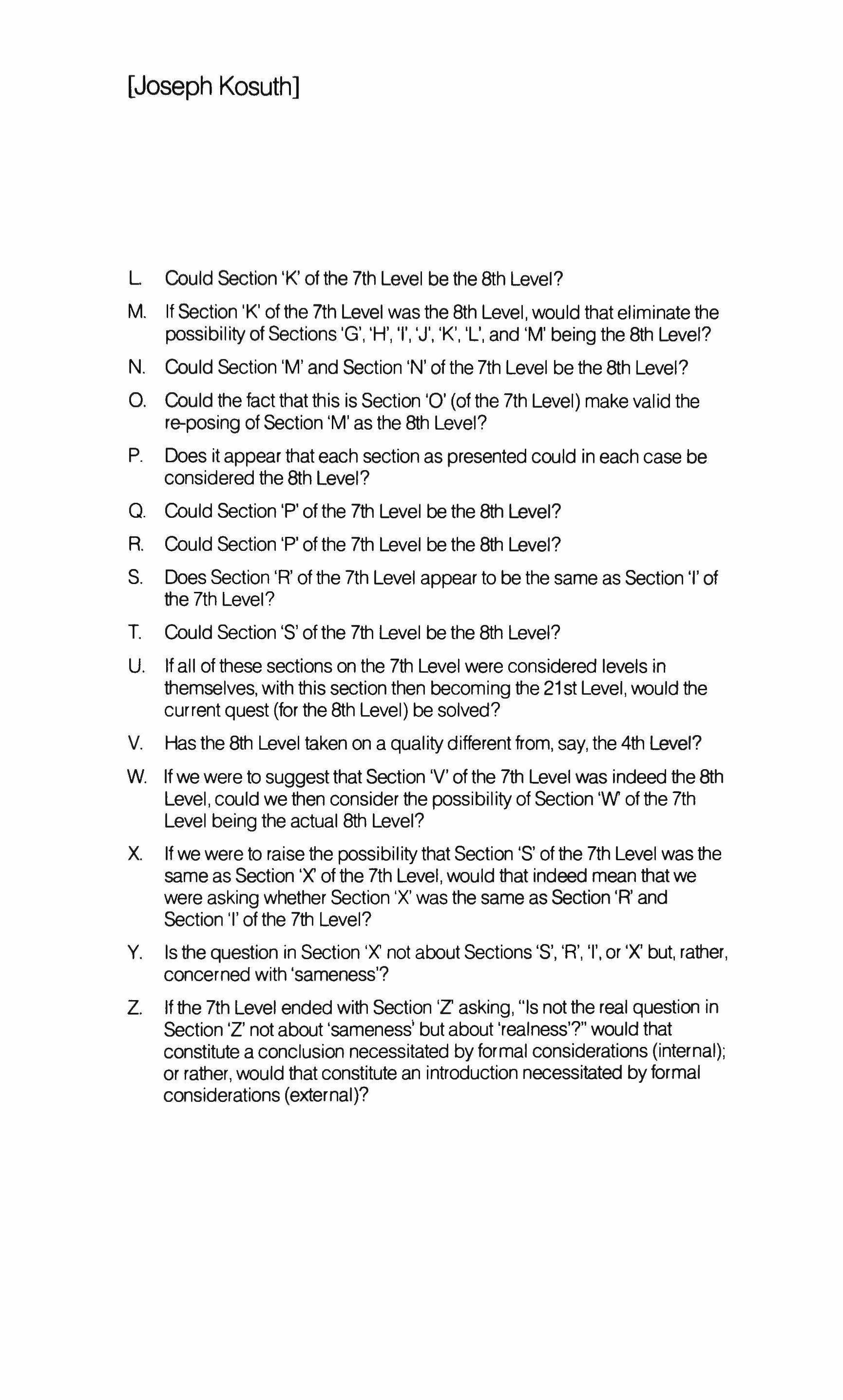
L Could Section 'K' of the 7th Level be the 8th Level?
M. If Section 'K' of the 7th Level was the 8th Level, would that eliminate the possibility of Sections '8', 'H', T, 'J', 'K'. 'L', and 'M' being the 8th Level?
N. Could Section 'M' and Section 'N' of the 7th Level be the 8th Level?
O. Could the fact that this is Section '0' (of the 7th Level) make valid the re-posing of Section 'M' as the 8th Level?
P. Does it appear that each section as presented could in each case be considered the 8th Level?
Q. Could Section 'P' of the 7th Level be the 8th Level?
R. Could Section 'P' of the 7th Level be the 8th Level?
S. Does Section 'R' of the 7th Level appear to be the same as Section 'I' of the 7th Level?
T. Could Section'S' of the 7th Level be the 8th Level?
U. If all of these sections on the 7th Level were considered levels in themselves, with this section then becoming the 21st Level, would the current quest (for the 8th Level) be solved?
V. Has the 8th Level taken on a quality different from, say, the 4th Level?
W. If we were to suggest that Section 'V' of the 7th Level was indeed the 8th Level, could we then consider the possibility of Section 'W of the 7th Level being the actual 8th Level?
X. If we were to raise the possibility that Section'S' of the 7th Level was the same as Section 'X' of the 7th Level, would that indeed mean that we were asking whether Section 'X' was the same as Section 'R' and Section T of the 7th Level?
Y. Is the question in Section 'X' not about Sections'S', 'R', 'I', or 'X' but, rather, concerned with 'sameness'?
Z. If the 7th Level ended with Section 'Z asking, "Is not the real question in Section 'Z' not about 'sameness' but about 'realness'?" would that constitute a conclusion necessitated by formal considerations (internal); or rather, would that constitute an introduction necessitated by formal considerations (external)?
[Joseph Kosuth]
Alice Aycock
New York City orientations: north

View ofNew York City from the Empire State Buildingalong the axis ofmagnetic north as determined by co� readings.
View ofNew York City from the Empire State Buildingalong the axis ofgeographic north as indicated by Hagstrom's New York City map.
View ofNew York City from the Empire State Building along the axis ofgeographic north as indicated by Map 1nd1Nries' New York City map. 11Ji<; was the working map for the orientation ofNew York City according to magnetic north.
View ofNew York City from the Empire State Building along the axis ofthe city grid: uptown.
[Alice Aycock]
New York City orientations: east

View of New York City from the Empire State Buildingalong the axis ofrnagtJelk east as determined byCOIDpIa �
View ofNew York City from the Empire State Building along the axis ofgeographk east as indicated by �'s New York City map.
VieW of New York City from the Empire State Buildingalong the axis ofgeographic east as indicated by Map IndusIries' New York City map. This was the working map for the orientation ofNew York City acoording to magnetic north.
VieW ofNew York atyfrom the Empire State Buildingalong the axis ofthecity grid: east side.
'[AliceAycock]
New York City orientations: south

VieW ofNew York City from the Empire State 8uiIdingalong the axis ofmagnetic south as detennined bycom��.
View ofNew York City from the Empire State Building along the axis ofgeographic south as indicated by Hagstrom's New York City map.
VieW ofNew York City from the Empire State Building along the axis ofgeographic south as indicated by Map Industries' New York City map. TIJi<i W$ the working map for the orientation ofNew York City according to magnetic north.
VieW of New York City from the Empire State Building along the axis ofthe city grid: downtown.
[Alice Aycock]
New York City orientations: west

View of New York City from the Empire State Buildingalong the !Wiofmagnetic west as determined by c.8mpl6l readiJ¥.
View ofNew York City from the Empire State Buildinga10ng the !Wi ofgeograpbic west as indicated by Hagmom's New York City map.
View ofNew York City from the Empire State Building a10ng the !Wi ofgeographic west as indicated by Map Industries' New York City map. This was the working map for the orientation ofNew York City according to magnetic north.
VIeW ofNew York City from the Empire State Buildinga10ng the � ofthe city grid: west side.

A. Ribe
Wind interaction
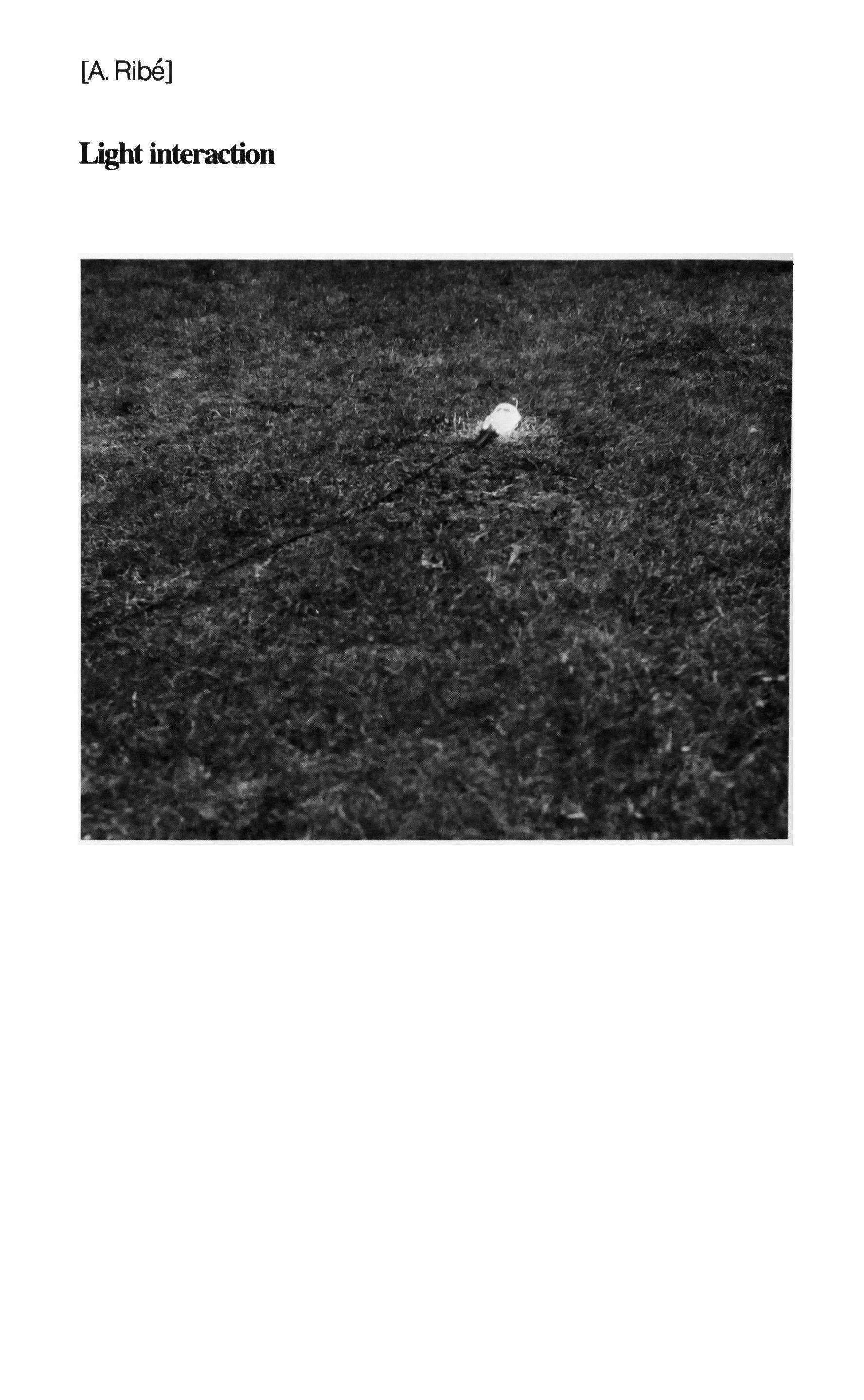
[A. Ribe]
Ught interaction
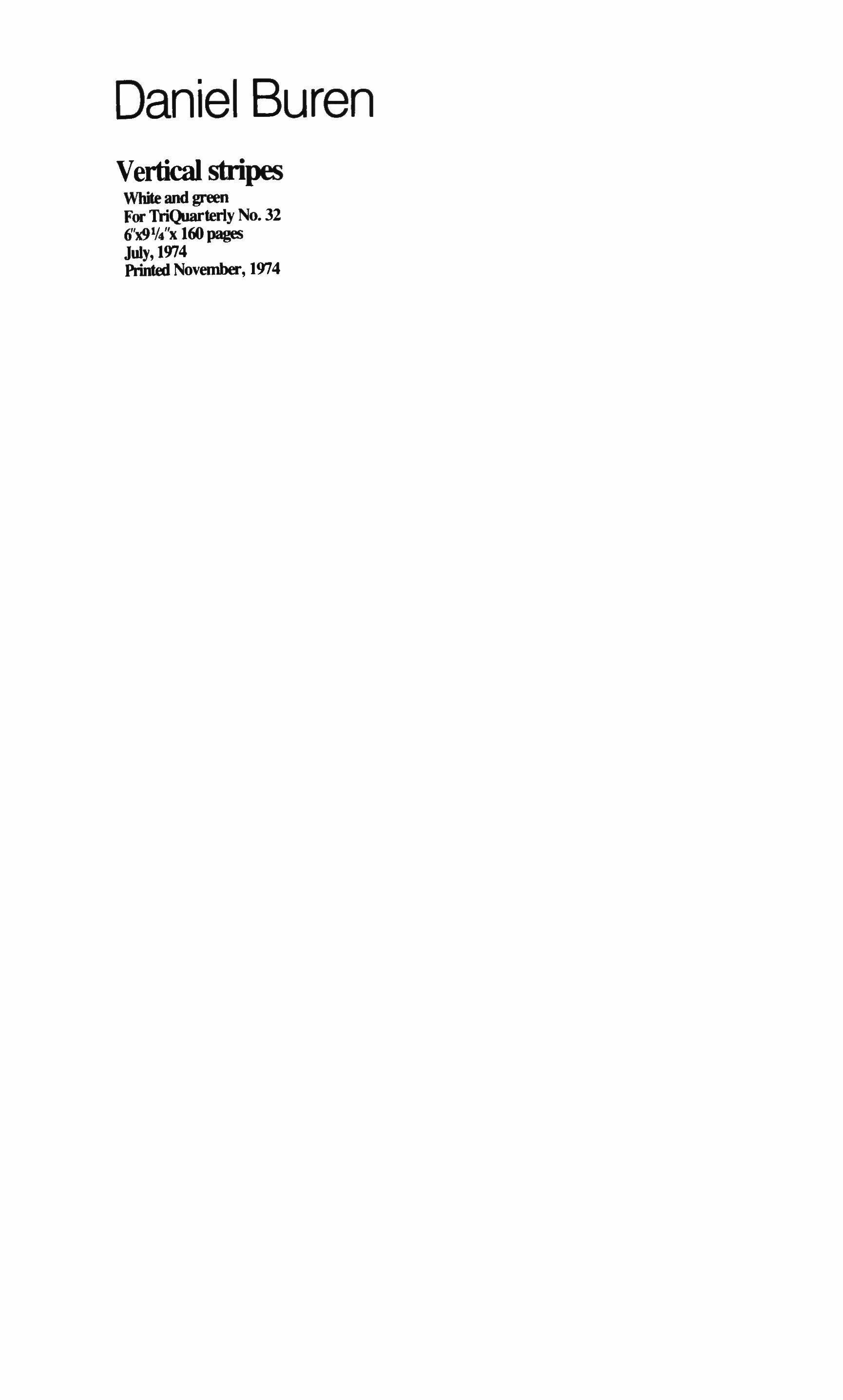
Daniel Buren
Vertical stripes
WIDe and green
For TriQuarterly No. 32
6'x91/4'X 160 pages
July, 1974
Printed November, 1974

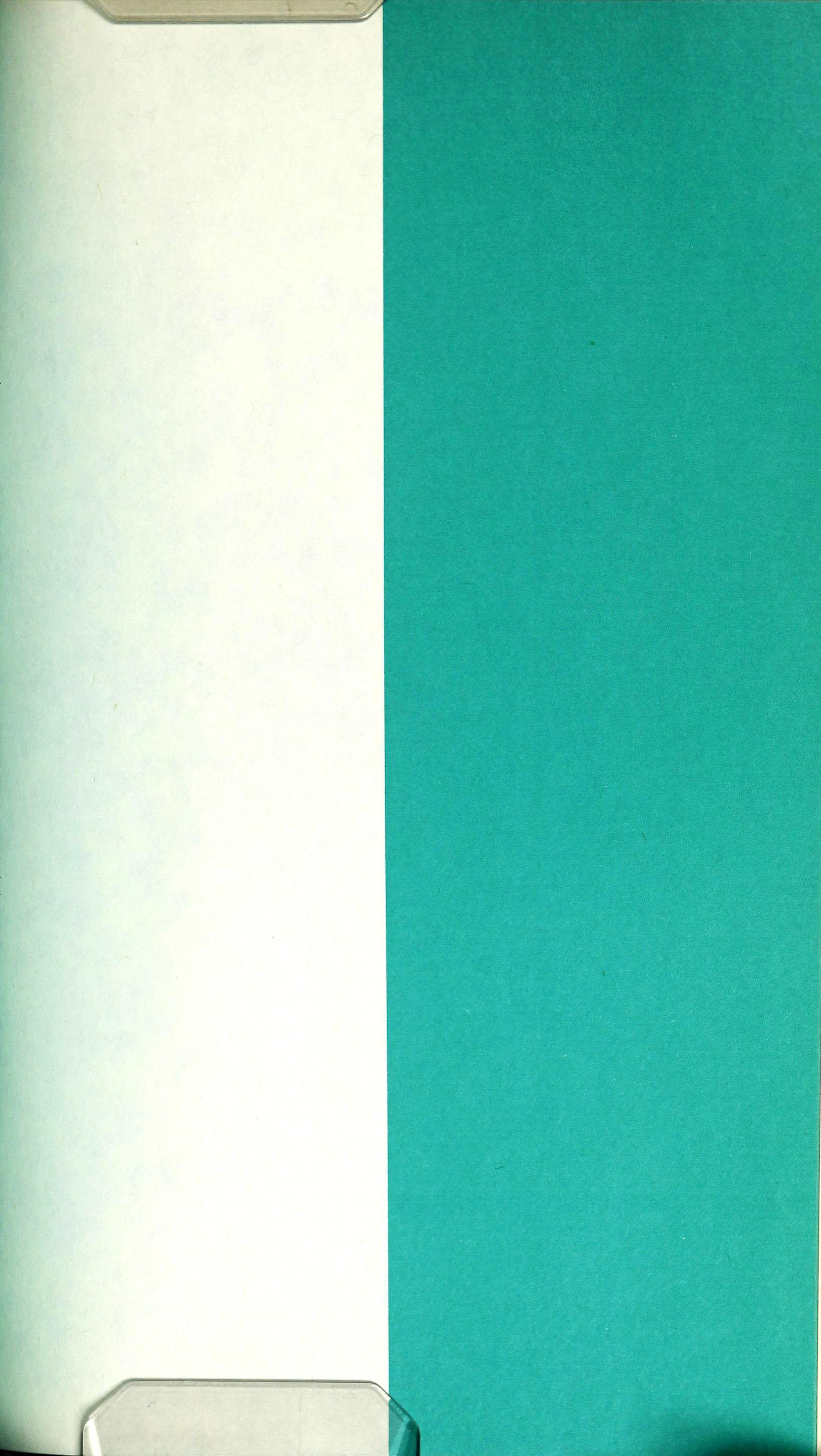


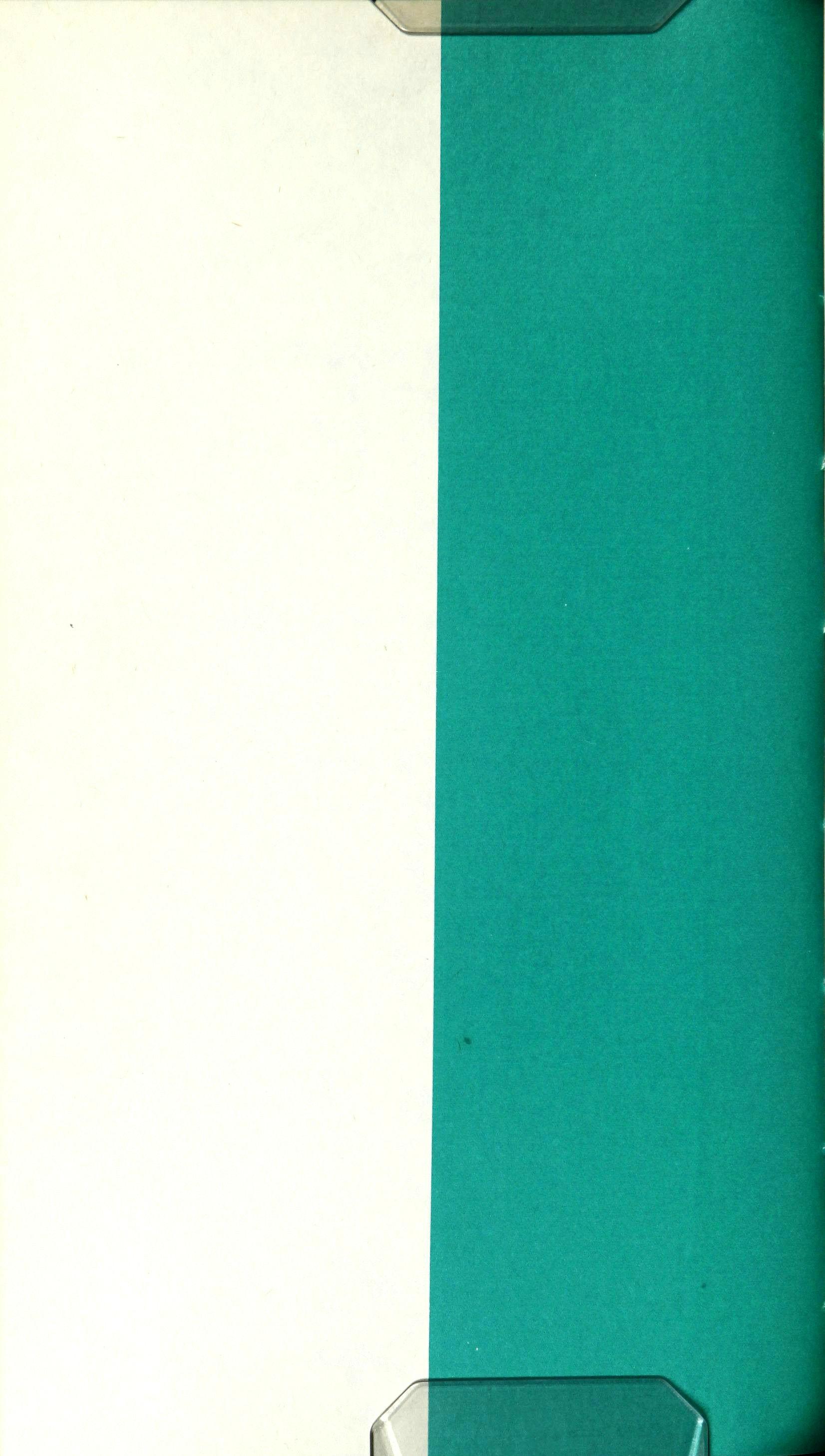


Rafael Ferrer
The mind is a muscle-bound misanthrope
Do you believe in Abstraction? No, please don't laugh. If you want to be an abstract artist the first step is to get THOSE who BEllEVE to believe in your belief in time you may then get to DO, GEOtv1ETRIA
rectangulos circulos triangulos squares Nueva York Malevich or a highly asyndetonic isometric for ART FOR HUM artforhurn HhHhHh
But you will never find ASTRABACUS IN ASTIJRIAS
To have an extreme position you must have two things, extremism and a position.
E X QUI SITE LYE X TRE M E LY NE W YORK PROVINCIA L Provincialism is the most extreme position in Manhattan Island.
Pero las islas y los poetas son libres.
] am not an avant-garde artist. ] am not an avant-garde artist.
I AM NOT AN AVANT-GARDE ARTIST!
Particularly when we know who call themselves avant-garde artists in this hemisphere.
AMERICA IS FROM TIP TO TIP
The poetry ofgeography as an antidote to the provincialism of the aesthetes.
NORTH AMERICA IS FROM PANAMA TO THE ARCTIC OCEAN
The GESTALT ofthe nightmare white straitjacket maze to preserve the honors ofguilts unearned by passions - Rather to preserve all WI-UTE in a void of concentric repetitions Get new THOUGHfS to justify NOTIflNG GET nothing to JUSTIFY guilt GET guilt to deny itself then deny the DENIAL BEGIN again AGAIN stay in the SAME place and then make PlACE an issue without recognizing place in relation to LAND demolish the meaning of WORDS as you admit a FONDNESS for them DENY the denial EARTH destroy it and GUll.T will be relieved RE-UVE never the first time always after the FACT to get AWAY from sweat NATURE to be conquered so as to WIN over guilt -GUll.TY no not necessarily JUST stripes on canvas RANK NAME and SERIAL NUMBER a prisoner of an ABSTRACTION biting the tail of a BOX HA! HA! HA! all 90% of its degrees all NINETY of them neutrally together just so fussily uninvolved DO it for a long time NbT too long wrrn care PEOPLE will care for what your GUll.T can do AND it can do ANY ofthe simplergeometric shapes - "YES SIR." "anytime SIR, no trouble at All except that which is necessary for OUR common guilt." "NO. no gigantism SIR, we keep a close relationship to human scale, without LOSING sight ofthe main goal." "Yes SIR we have managed to eliminate All relationships." INTERNAL and EXTERNAL. WE GOT IT. ALL relationships gone all 986,775,678,147,900,123,456,789 of them.
Rafael Ferrer, Filadelfia, March, 1974
Scott Burton
Furniture landscape
Temporary imtaIIation, JohIL'Jon County, Iowa
SJlOIIiIIl"OOby University oflowa Art Ml1'leUI1l
July31, 1970
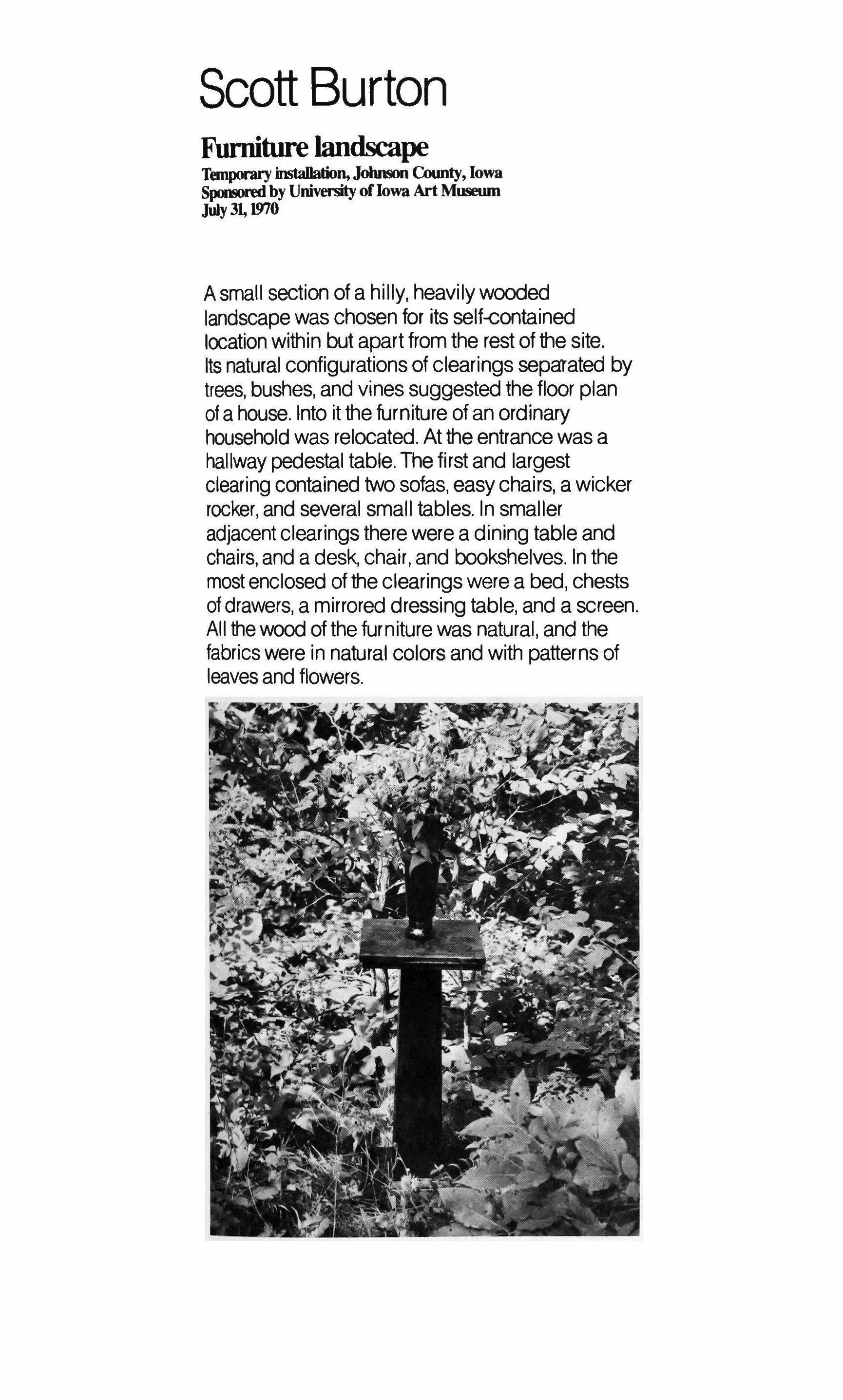
A small section of a hilly, heavily wooded landscape was chosen for its self-contained location within but apart from the rest of the site. Its natural configurations of clearings separated by trees, bushes, and vines suggested the floor plan of a house. Into it the furniture of an ordinary household was relocated. At the entrance was a hallway pedestal table. The first and largest clearing contained two sofas, easy chairs, a wicker rocker, and several small tables. In smaller adjacentclearings there were a dining table and chairs, and a desk, chair, and bookshelves. In the most enclosed of the clearings were a bed, chests of drawers, a mirrored dressing table, and a screen. All the wood of the furniture was natural, and the fabrics were in natural colors and with patterns of leaves and flowers.
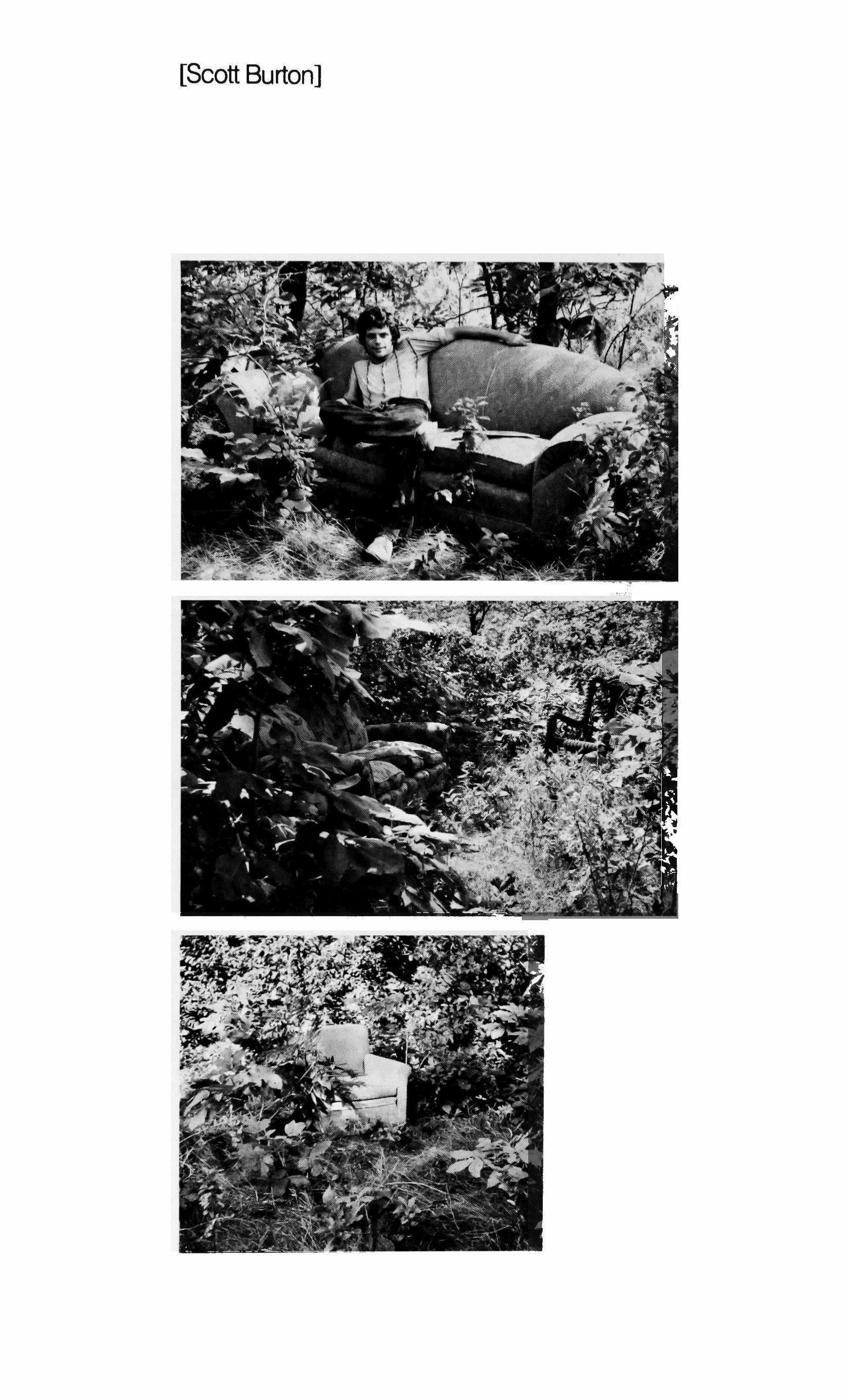
[Scott
Burton]
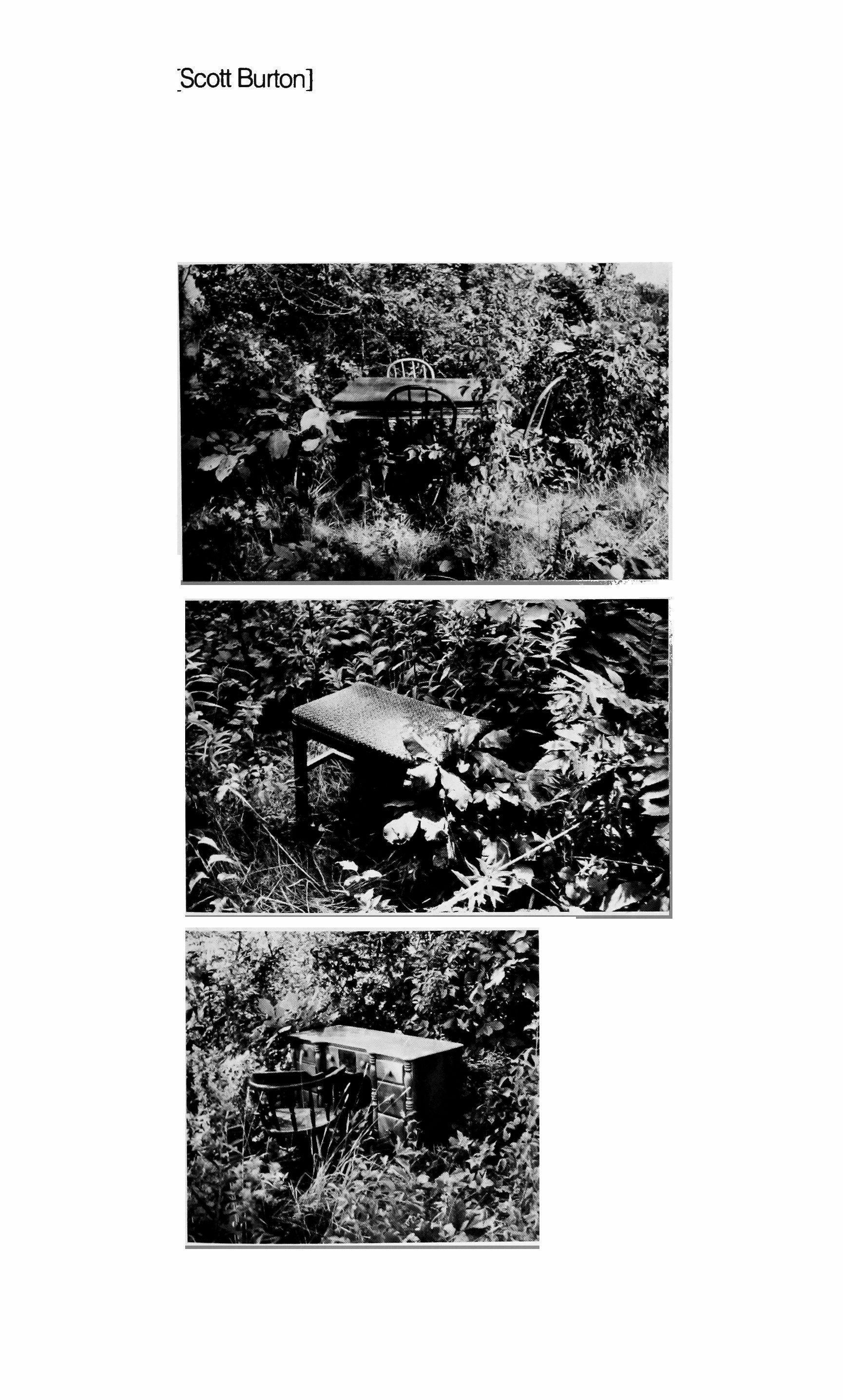
:Scott Burton]

[Scott
Burton]

[Scott
Burton]
[Scott Burton]


[Scott Burton]
Furniture pieces
PerformEd March 4, 1971, New York City. Finch CoUege auditoriwn. Nine SECtions of 15 seconm each,con.si.mng ofthe exhibition ofone or two pieces offurniture-chairs and tables ''found'' for thii purpose. Changes ofpiece> were concealed behind closed curtains.
[Scott Burton]

[Scott Burton]

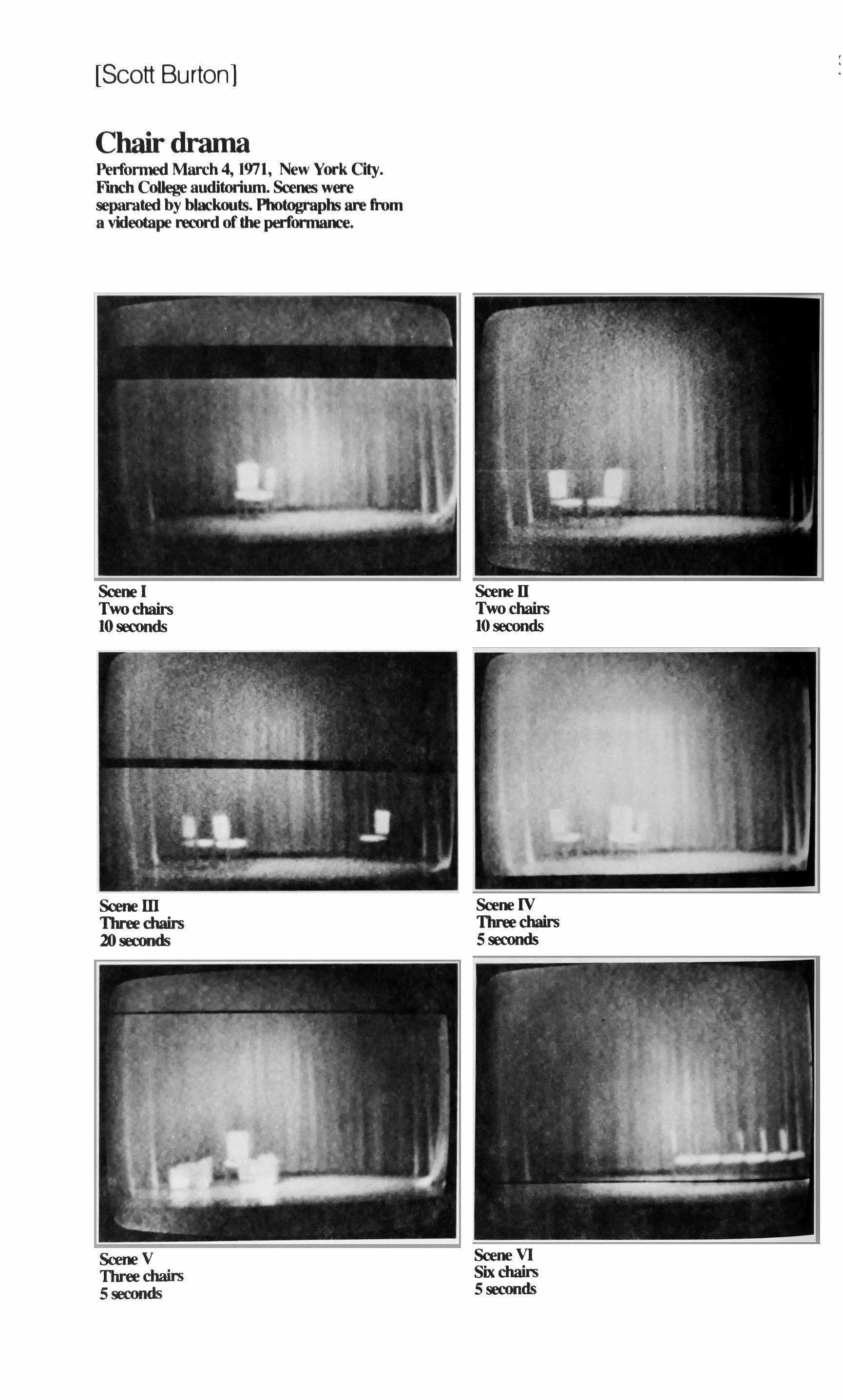
[Scott Burton1
Chairdrama
Performed March 4, 1971, New York City. Finch College auditorium. Scenes were separated by blackouts. Photograpm are from a videotape record of the performance.
Two
10seconds
Scene I
chairs
Two
10
Three
2Oseconds
Seene Il
chairs
seconds SceneID
chairs
Three chairs 5
Scene IV
seconds
Three
5seconds
Scene V
chairs
[Scott Burton]

chairs
SceneVD
Ten
2Oseronds
Ten
30 seconds
SceneVIll
chairs
Scene IX
Onechair
4Oseronds
Scene X One chair
10 seconds
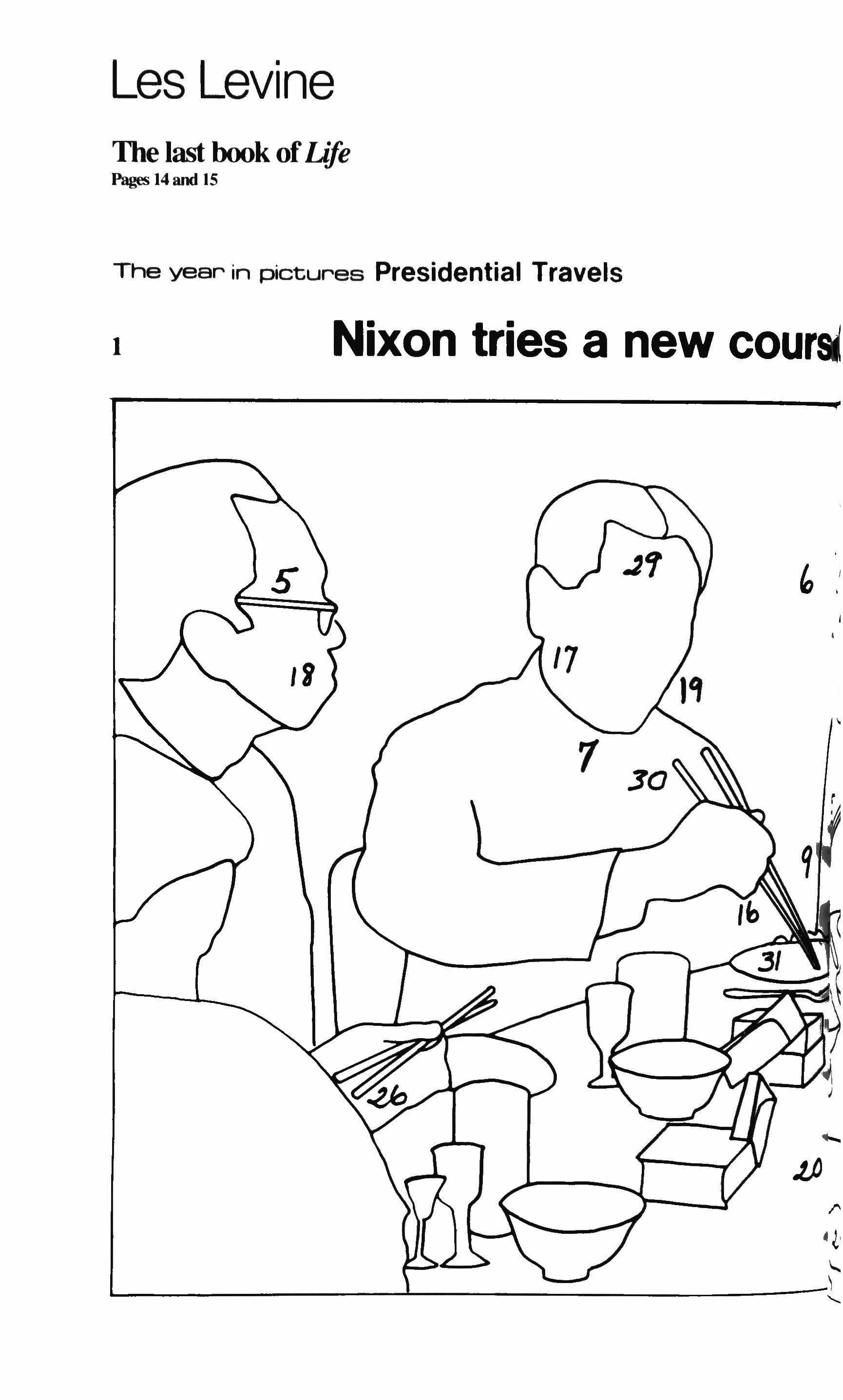
Les Levine
The last book oflife Pages 14 and IS The year in pictures Presidential Travels 1 Nixon tries a new cour� I... L_ L- --�

Puzzled perhaps by an exotic mor••1 of Chin••• CUls,ne but triumphanl Ihat he had ,I hrrnly aecured between hi. chopll,cka, Pre.Ident Nn{on sat down to dinner In Hangchow With Premier Chou En-Ial Nucon', February Journey to China wI' the mOlt vIvid of an hi' foray. in ,nlernal,onll d,plomacy-and il clrt.:nly helped h,m al home In NOllember In hI. enormOUI VictOry over George �cGovem
lewca,
China

1

1 This is a photograph from ilte Magazine. It's pages 14 & 15 from the last issue. The text says, "Nixon tries a new course in China." I'm proposing that this photograph is one point on a cultural map. If we lookat this photograph and analyze it, we can not only say where our culture has been but where it will go to, particularly North America. There is something in the photograph which I know about, that is not very obvious at first glance: There is a kind of protocol involved here that prevails in Oriental circles, particularly at this high governmental level. It is considered a politeness to lower your eyes in formal situations such as greeting people. One of the things that has occurred to me is that Nixon has been told about that. This is a White House photograph. It's not taken by Ute Magazine photographers. It's taken by the White House staff photographers. I wonder who made that choice. I guess a number of people in the White House did. It seems like an odd choice because of the way Nixon is presented. Chou En-Iai has got his eyes down, which is correct it seems to me in terms of the situation, and his chopsticks are on the bowl- he's not actually picking anything up and he's not exactly looking at anything; he's looking down. Whereas Nixon, it would seem, has been told by the protocol service attached to the White House that in situations like this, one should look down; that it's polite to look down. It seems Nixon is looking down at something he has in his chopsticks, which is not the same thing as looking down out of politeness. Does Mr. Nixon look down all the time or does Nixon occasionally look at his guests? Or is this the initial meeting? Well, it wouldn't make any difference whether it's the initial meeting or not. It's a formal situation, they are at a dinner table and they are being photographed.

3

2 He's looking down for the photograph, is that it? Yes, I think it's a role that he's taken for the photograph. Probably he's been told that it's the kind of politeness that should be expressed in this situation. But he's not looking down at nothing, which is part of the elegance of that gesture, he's looking down at something, which destroys the elegance of the gesture.
3 That man to the right seems to be in the process of eating something and has arrested his action mid-stream. In other words, his consciousness has been changed for 1 second. There is something out of place and so he looks over at the cashew nut that Nixon has. If you take the point of his eyes, you can draw a line directly from where his eyes are looking that will cross over the cashew nut. The thing he has in his chopsticks is a cashew nut. The mode of dress is quite different. Mr. Nixon looks like a businessman having lunch with a bunch of Chinese workers or something. Do you think the White House chose this photograph because they felt that it shows Nixon a little uneasy with the Chinese, although it also shows him well-fitted into the situation? The thinking could have been to project a good image of the President in a foreign situation, but also to project the idea that he's not totally surrendered to that situation. There are probably a lot of Americans who are afraid of the idea of entering Red China, and to have Nixon pose that way, with that questioning look, represents their point of view. Is the cashew nut a metaphor for Chinese culture? I just can't see Mr. Nixon sitting down to his evening meal and looking at l1is food like that. There is nothing strange about a cashew nut. Do you think it's a possibility that Nixon has just made a statement concerning the cashew nut? "My, this is a nice cashew nut!" And therefore attracted the attention of the person on his left? That's a possibility. Do you think though that the man at his
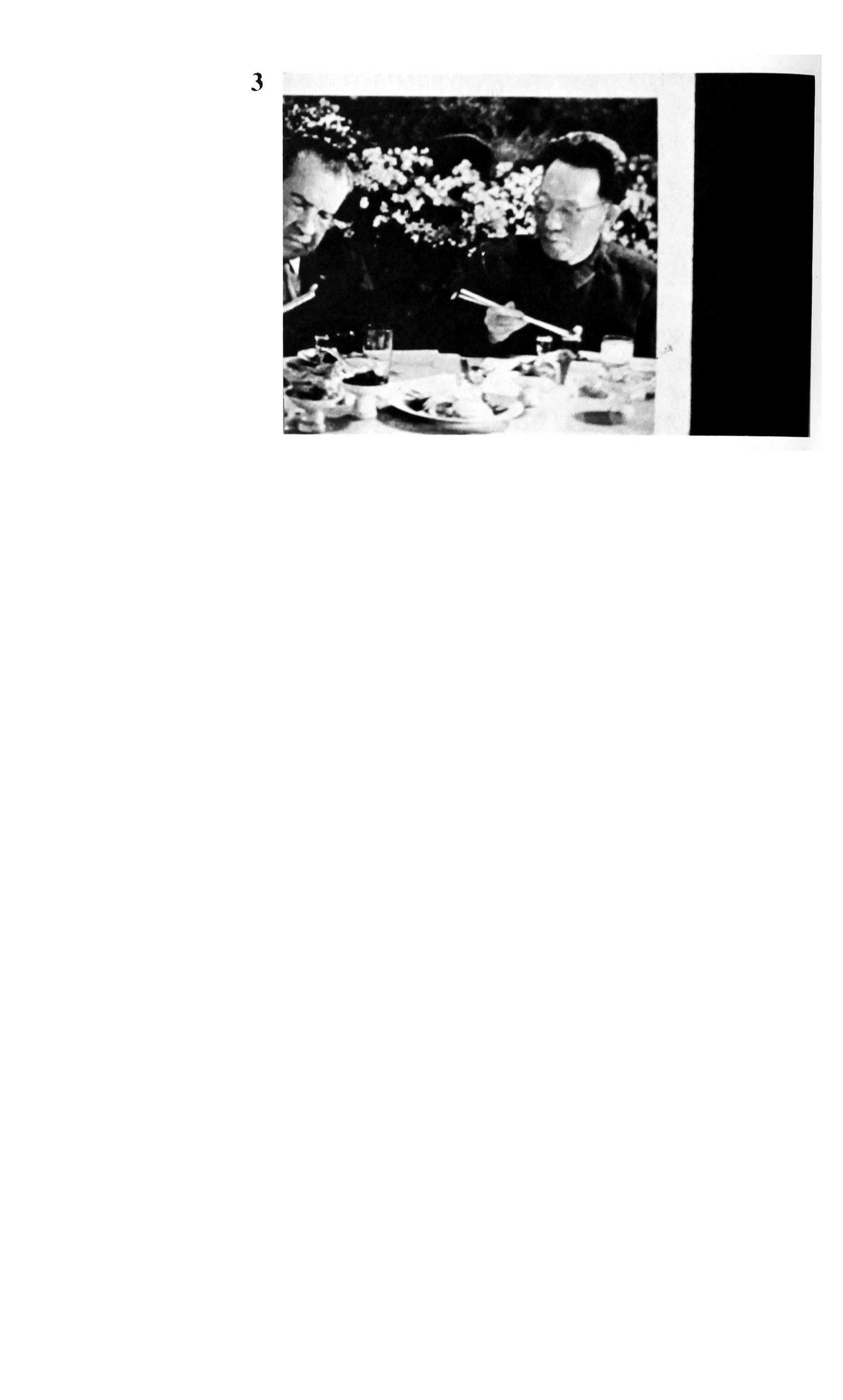
3
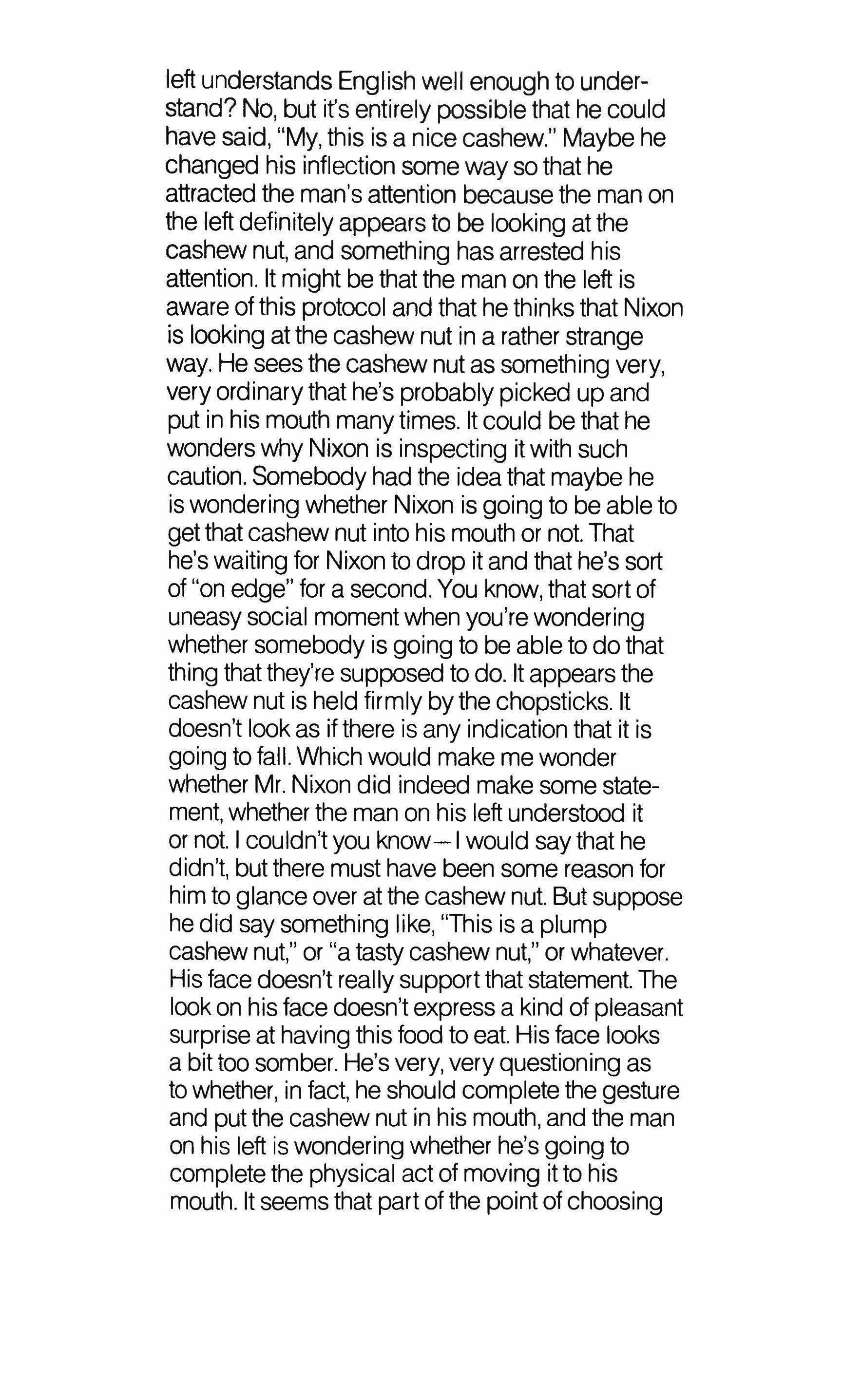
left understands English well enough to understand? No, but it's entirely possible that he could have said, "My, this is a nice cashew." Maybe he changed his inflection some way so that he attracted the man's attention because the man on the left definitely appears to be looking at the cashew nut, and something has arrested his attention. It might be that the man on the left is aware of this protocol and that he thinks that Nixon is looking at the cashew nut in a rather strange way. He sees the cashew nut as something very, very ordinary that he's probably picked up and put in his mouth many times. It could be that he wonders why Nixon is inspecting it with such caution. Somebody had the idea that maybe he is wondering whether Nixon is going to be able to get that cashew nut into his mouth or not. That he's waiting for Nixon to drop it and that he's sort of "on edge" for a second. You know, that sort of uneasy social moment when you're wondering whether somebody is going to be able to do that thing that they're supposed to do. It appears the cashew nut is held firmly by the chopsticks. It doesn't look as if there is any indication that it is going to fall. Which would make me wonder whether Mr. Nixon did indeed make some statement, whether the man on his left understood it or not. I couldn't you know-I would say that he didn't, but there must have been some reason for him to glance over at the cashew nut. But suppose he did say something like, "This is a plump cashew nut," or "a tasty cashew nut," or whatever. His face doesn't really support that statement. The look on his face doesn't express a kind of pleasant surprise at having this food to eat. His face looks a bit too somber. He's very, very questioning as to whether, in fact, he should complete the gesture and put the cashew nut in his mouth, and the man on his left is wondering whether he's going to complete the physical act of moving it to his mouth. It seems that part of the point of choosing


the photograph is to express the idea that Nixon is going to go into China; he's comfortable with the Chinese, but that he's going to be very cautious in getting himself involved. With that cashew nut, if you believe abstractly, as I do, that the cashew nut represents Chinese culture and all that goes along with that, and whether Nixon's going to swallow the Chinese culture pill whole or not is a view that is connected to the idea of placating what is abstractly called the rightwing in America. In this photograph, you've got to believe that Nixon's not losing his heart to the Chinese. Now you can see quite clearly that Mr. Nixon is lookingdown.
4 It's possible that he is looking down at Chinese culture and wondering whether it is possible for him to ingest Chinese culture and survive. It could also mean that this is the only piece of food on the table that he can to some degree relate to. Is the cashew nut bridging culture shock? But Chinese food is very popular in the United States. When I look at the table I don't see Chinese food as I normally know it although it does look very beautiful.
5 Now you can see the man who is on the right of Chou En-Iai is also looking directly over at the cashew nut. He's looking right past Chou En-Iai to the cashew nut. It's interesting why Chou En-Iai does not look at the cashew nut.
6 What I assume is this: these two men who are both very important to world power politics are making gestures or poses that will read well to their constituents. In other words, Chou En-Iai is be
having in a way that he believes a Chinese leader will look well in the eyes of the Chinese people and Mr. Nixon is behaving in a way that he believes an American leader will look well to the American people. So, Mr. Nixon projects that he is comfortable with the Chinese. He can sit down and eat a meal with them and rub elbows with them, but he wants to make sure that the American
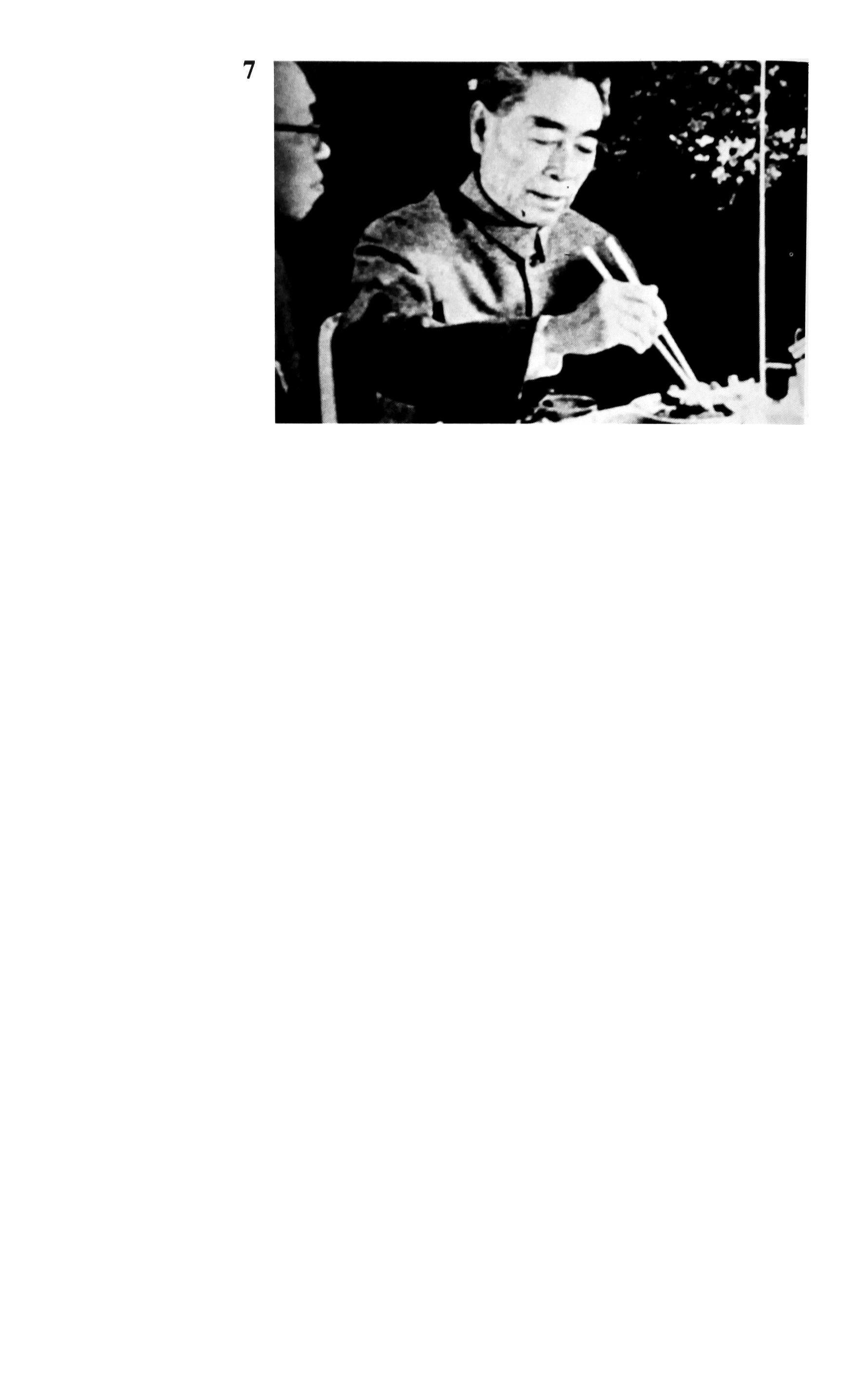

people know that he doesn't swallow Chinese culture whole. He looks at it carefully; he examines it, shows apprehension, and is cautious about getting too far into this thing too quickly.
7 Whereas Chou En-Iai is in perfect position for Chinese protocol; his chopsticks are down; he's not picking anything up; he's looking down; his mouth is open connoting in my opinion an open gesture. He appears relaxed which Nixon does not. That doesn't seem too unusual because Nixon is not in his own home and Chou En-Iai is. It seems reasonable to me that Chou En-Iai would be more relaxed. You have to realize that this photograph was taken by a WhtteHouse staff photographer although it appeared in Life Magazine. What interests me is that the man on the right of Nixon and Chou and the other man on the left both appear to be looking at the cashew nut, and the woman on the lower left appears also to be looking down. The angle of her forehead indicates that she is looking down. She's participating in the protocol or whatever it is. It's like a gesture of polite reticence. I thinkthat that supports the view that a moment of conscious change has taken place. That some slightthing which one can't define at this point has happened to make these two men (who are obviously aides to Chou) notice. Some new element of consciousness has interrupted the normal flow. Now you can see a bit more of what is on the table. And you can see quite clearly now that Chou En-Iai, whose hand is pointing the chopsticks down towards the table, is merely gesturing at the plate. He's touching the plate with his chopsticks but there is no attempt to pick anything up. It's as though somebody said to him, "Pose in this position," or it's as though he knows that this is the correct position to pose in. In Oriental culture it is considered somewhat vulgar to be photographed in the act of eating, and Chou En-Iai as president or premier, is at the height of Oriental


society. You would certainly expect him to understand all these subliminal nuances of Chinese culture. Now you can see, in the front of the foreground, the cashew nuts appear to be a considerable distance away from Nixon. The cashew nuts are in the bottom right-hand part of the picture in front of the lobsters.
8 There's a plate of lobsters on that circular 'lazy susan.' It's a thing you can rotate around a table. They appear to look like shrimps, but then the shrimps are in the bowl that is slightly higher.
9 The relationship of the chopsticks is fascinating. Chou's are pointing downward and Nixon's are pointing upward. Chou's are pointing downward and back up towards himself and Nixon's are pointing across so that your eye can almost form two triangles, one going out and towards the right side of the picture and going back, and the other going down towards the bottom of the picture and going up. So it seems these two sets of chopsticks are forming what is called visual tension against one another in a purely formalistic way. Do you think this is accidental, or do you think it is just the cultural differences between the two people, or is it a logical and natural action or reaction? I think partially it is expressing the cultural differences between the two people, but I think also that it is partially psychological because here you have two men important to world politics and they are both saying to one another indirectly, "Here is an image that is going to be seen by the entire world. Now, how do I want to look to the entire world?" So it seems to me that the way they want to look to the entire world is: they're getting along together, but they're not capitulating to the other's view totally. Now you can see that plate has got some lobsters on it. You can see that quite clearly now. That's part of the 'lazy susan'. You can see also on that plate a swan made out of radishes.

10 11 12

10 There you have that man on Nixon's left chopsticks. He has obviously picked that food up, and is caughtthere, is frozen for some reason or other. What I feel about this photograph is that the chopsticks are the crucial element, that the chopsticks tell you what's really happening in the photograph. 11 First of all, that chopstick there is pointing toward the center which is not an uncommon device that's been used in all kinds of pictorialism throughout the ages. It was normal, for instance, in previous times, that in a painting of a person, the person would be pointing towards something. And indeed, what he was pointing at became the point of interest. It's interesting how formal the composition ofthe total picture is. You can see how the chopsticks move your eye around the table very, very easily, almost the way a drape in a Renaissance painting moves your eye across the painting.
12 Also, the direction of Nixon's head helps to force you over to the left-hand side. I wonder if Pat Nixon was there sitting at another table. There are no women at this table. Usually when Mr. Nixon is in a public dinner situation he is always next to Pat. But then the table they are sitting at is round, so if you photograph a round table you only get part of the circle. That also connotes an interesting cultural difference. In such a situation in North America, a round table would be totally out of place. It would most certainly be a rectangle. The rectangle reads out as a block of power, while in the circle all elements are equal. The circle creates a continuous flow of interaction, while the rectangle divides into 4 sides. Of course, it could simply be that a circle is more abstract in a mathematical logic structure than a rectangle, and that Westerners are more given to logic and efficiency than to abstract symbiosis. A circle can be looked at from too many different points of view. The rectangle demands that you be in a proscenium viewing position. So it's possible that

13 14 15
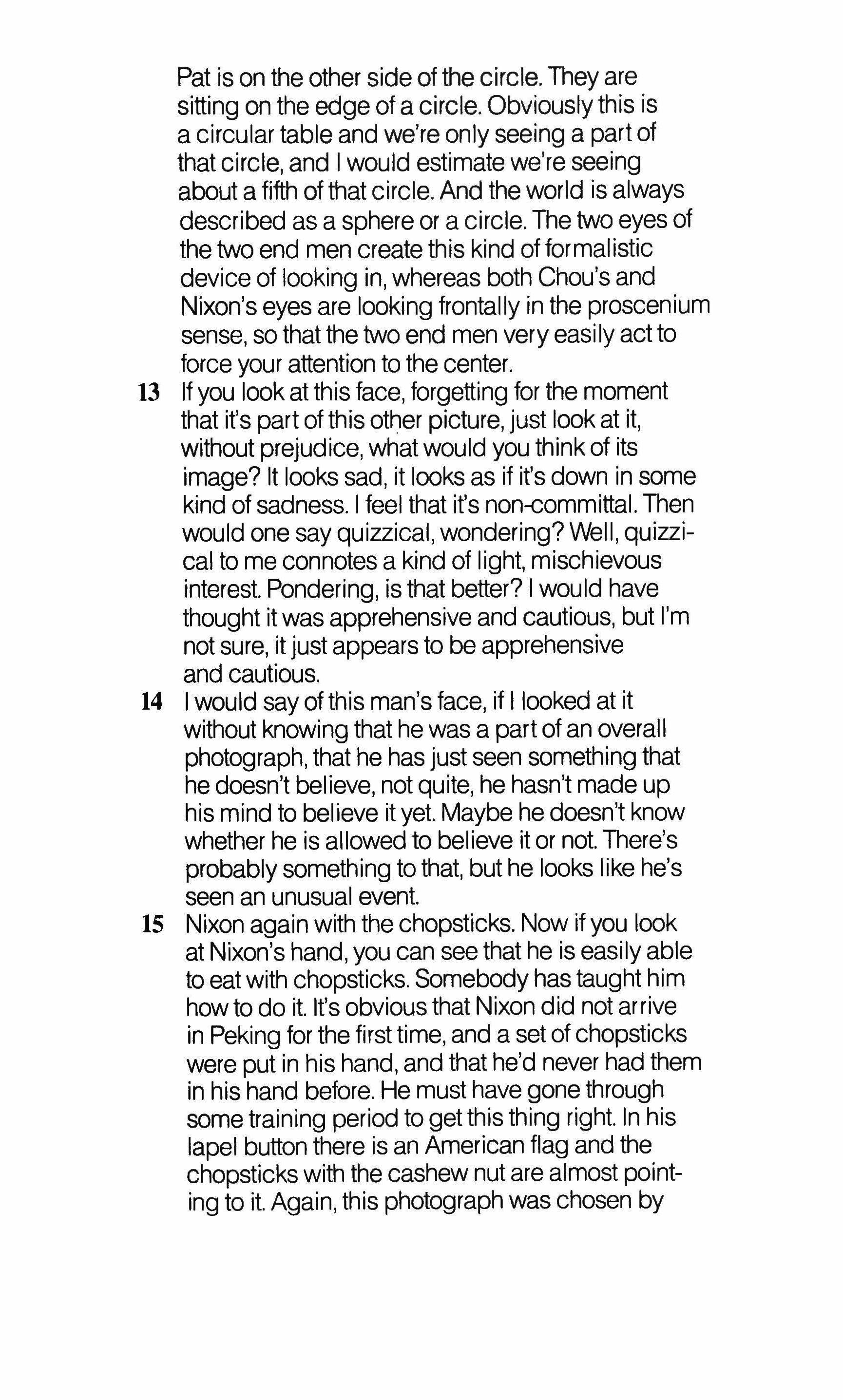
Pat is on the other side of the circle. They are sitting on the edge of a circle. Obviously this is a circular table and we're only seeing a part of that circle, and I would estimate we're seeing about a fifth of that circle. And the world is always described as a sphere or a circle. The two eyes of the two end men create this kind of formalistic device of looking in, whereas both Chou's and Nixon's eyes are looking frontally in the proscenium sense, so that the two end men very easiIy act to force your attention to the center.
13 If you look at this face, forgetting for the moment that it's part of this other picture, just look at it, without prejudice, whatwould you think of its image? It looks sad, it looks as if it's down in some kind of sadness. I feel that it's non-committal. Then would one say quizzical, wondering? Well, quizzical to me connotes a kind of light, mischievous interest. Pondering, is that better? I would have thought it was apprehensive and cautious, but I'm not sure, it just appears to be apprehensive and cautious.
14 I would say of this man's face, if I looked at it without knowing that he was a part of an overall photograph, that he has just seen something that he doesn't believe, not quite, he hasn't made up his mind to believe it yet. Maybe he doesn't know whether he is allowed to believe it or not. There's probably something to that, but he looks like he's seen an unusual event.
15 Nixon again with the chopsticks. Now if you look at Nixon's hand, you can see that he is easily able to eat with chopsticks. Somebody has taught him how to do it. It's obvious that Nixon did not arrive in Peking for the first time, and a set of chopsticks were put in his hand, and that he'd never had them in his hand before. He must have gone through some training period to get this thing right. In his lapel button there is an American flag and the chopsticks with the cashew nut are almost pointing to it. Again, this photograph was chosen by

18

the White House and one of the things that you subliminally see is the American flag as if to remind you this man is a patriot. One notices the knife, which is a very large knife, so presumably there's a fork on the other side. You can see the fork there just a tiny little bit. It's just behind the glass there. There's that little dish of either brown or black things, and there's a glass behind that, and you can just see a Iittle bit of the fork. Now you can see more easily what is on the table.
16 And you can also see that Chou En-Iai is not picking anything up. Now you see his face. What would you say about that face?
17 I feel that Chou looks somewhat relaxed in this picture. I wonder about his mouth being slightly open, whether he has said something or is in the act of saying something. But he looks extremely relaxed and one wouldn't imagine that he would talk with his eyes in that direction. So I would have to assume that his mouth is open for some other reason, because he is a relaxed individual. But I don't know whether he's a relaxed individual or not. One doesn't have sufficient evidence in the photograph to know that he wants his image presented as open and relaxed. So what these people could be doing is projecting an image which might, in fact, not be precisely what they are. You have to assume that this photograph was taken, let's say, from a selection of very many and was chosen for specific reasons. The people who send photographs out of government agencies are reasonably analytical about those images, consciously or subconsciously. You can't imagine that they allow photographs to go out that have not been edited, at least to say, "Should we use this one or should we use that one?" And they must exercise some reason.
18 What interests me about this is the way this man's mouth seems to be closed with determination. He definitely wants you to know, "My mouth is closed." Some parts become painterly

19
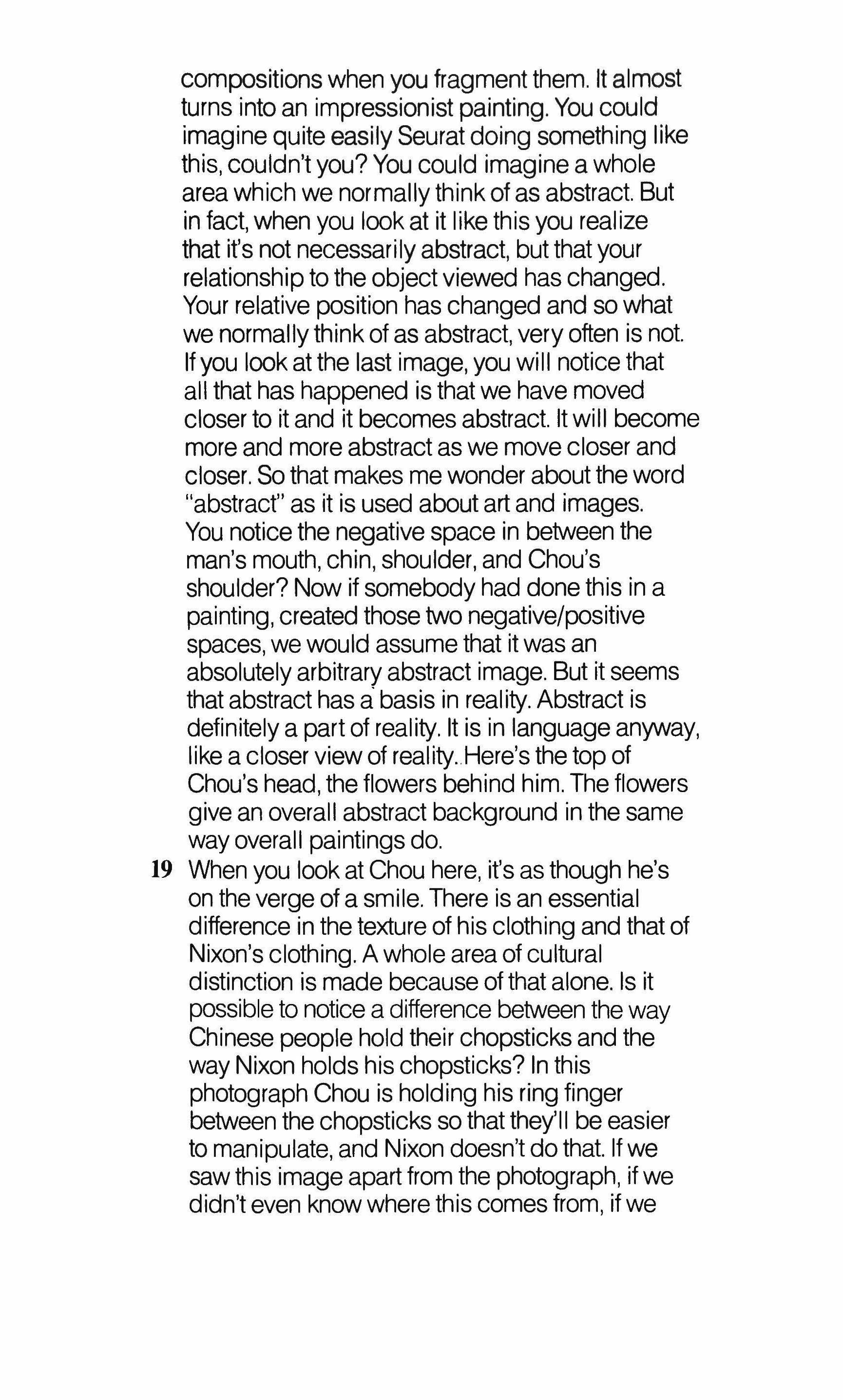
compositions when you fragment them. It almost turns into an impressionist painting. You could imagine quite easily Seurat doing something like this, couldn't you? You could imagine a whole area which we normally think of as abstract. But in fact, when you look at it like this you realize that it's not necessarily abstract, but that your relationship to the object viewed has changed. Your relative position has changed and so what we normally think of as abstract, very often is not. Ifyou look at the last image, you wiII notice that all that has happened is that we have moved closer to it and it becomes abstract. It will become more and more abstract as we move closer and closer. So that makes me wonder about the word "abstract" as it is used about art and images. You notice the negative space in between the man's mouth, chin, shoulder, and Chou's shoulder? Now if somebody had done this in a painting, created those two negative/positive spaces, we would assume that it was an absolutely arbitrary abstract image. But it seems that abstract has a basis in reality. Abstract is definitely a part of reality. It is in language anyway, like a closer view of reality Here's the top of Chou's head, the flowers behind him. The flowers give an overall abstract background in the same way overall paintings do.
19 When you look at Chou here, it's as though he's on the verge of a smile. There is an essential difference in the texture of his clothing and that of Nixon's clothing. A whole area of cultural distinction is made because of that alone. Is it possible to notice a difference between the way Chinese people hold their chopsticks and the way Nixon holds his chopsticks? In this photograph Chou is holding his ring finger between the chopsticks so that they'll be easier to manipulate, and Nixon doesn't do that. If we saw this image apart from the photograph, if we didn't even know where this comes from, if we

20 21 22
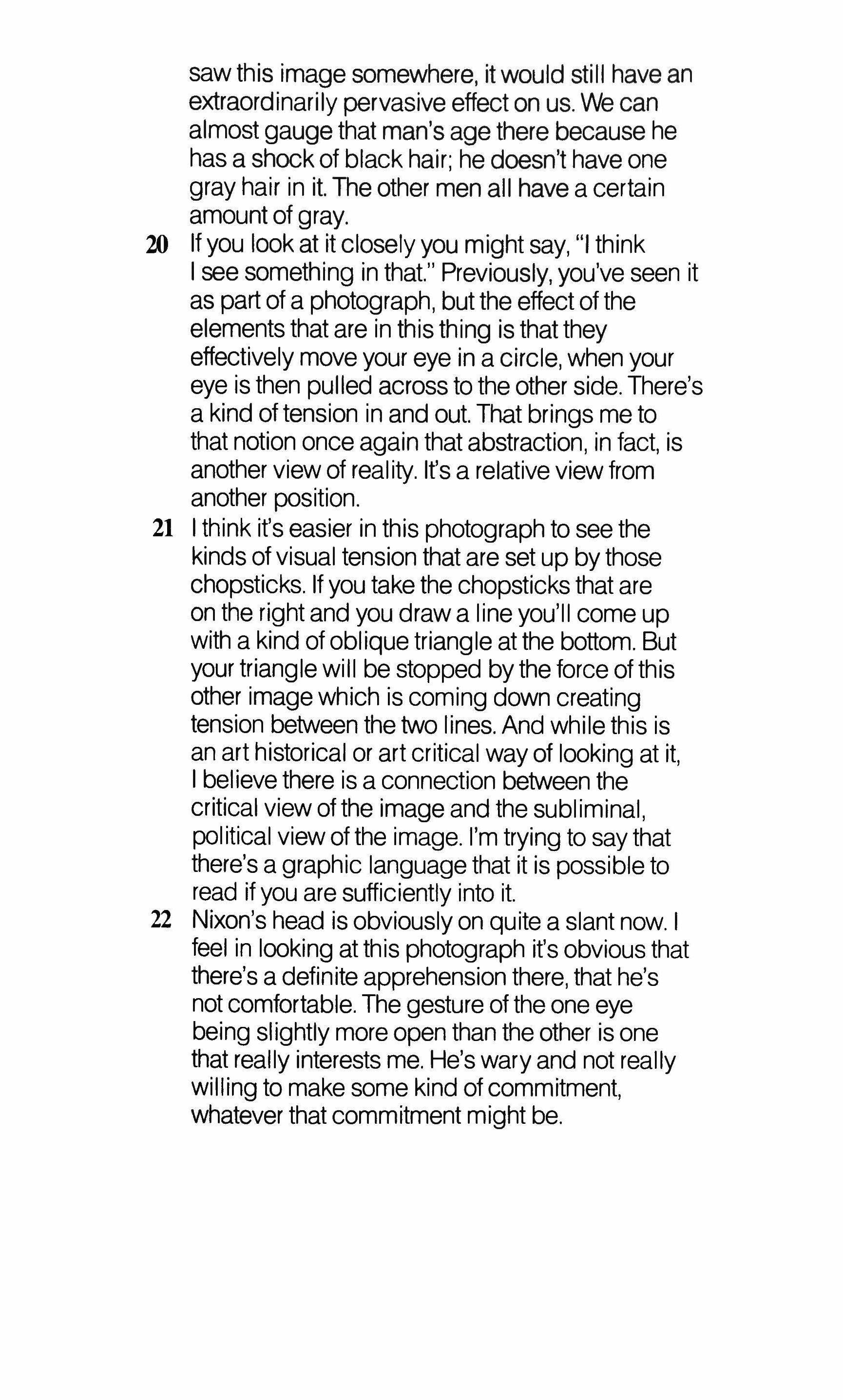
saw this image somewhere, it would still have an extraordinarily pervasive effect on us. We can almost gauge that man's age there because he has a shock of black hair; he doesn't have one gray hair in it. The other men all have a certain amount of gray.
20 If you look at it closely you might say, "I think I see something in that." Previously, you've seen it as part of a photograph, but the effect of the elements that are in this thing is that they effectively move your eye in a circle, when your eye is then pulled across to the other side. There's a kind of tension in and out. That brings me to that notion once again that abstraction, in fact, is another view of reality. It's a relative view from another position.
21 I think it's easier in this photograph to see the kinds of visual tension that are set up by those chopsticks. If you take the chopsticks that are on the right and you draw a line you'll come up with a kind of oblique triangle at the bottom. But your triangle will be stopped by the force of this other image which is coming down creating tension between the two lines. And while this is an art historical or art critical way of looking at it, I believe there is a connection between the critical view of the image and the subliminal, political view of the image. I'm trying to say that there's a graphic language that it is possible to read if you are sufficiently into it.
22 Nixon's head is obviously on quite a slant now. I feel in looking at this photograph it's obvious that there's a definite apprehension there, that he's not comfortable. The gesture of the one eye being slightly more open than the other is one that really interests me. He's wary and not really willing to make some kind of commitment, whatever that commitment might be.

23

23 You have to remember, too, that Richard Nixon, President of the United States, which is a very powerful and worldly position, presumably has eaten cashew nuts before and that he knows what that cashew nut is going to taste like when he puts it in his mouth. So there should be no extraordinary apprehension on his part for reasons of let's say, "Are they giving me a pickled snake to eat here?" which might be cause for worry. Are you sure it's a cashew nut? Yes, I'm quite sure it's a cashew nut. And part of the reason I'm quite sure it's a cashew nut is because I have put a cashew nut in the exact same position and photographed it from 15 different views to see if in fact it is a cashew nut. I thought in the beginning it might be a shrimp, but now I believe it's a cashew nut. Mr. Nixon seems quite competent using the chopsticks. He's got the dexterity of it quite well. He's obviously been told when he comes to China he's going to have to use chopsticks and he's been taught how to do it. It's not likelyyou're going to allow your President or king or highest man in your country to fall into a social situation where he can't organize himself properly. There are staff people who are supposed to do that.
24 The table that's in front of him, and that's what I think are shrimps there in that standing-up bowl, and I think those are cashew nuts in the righthand part ofthe picture in that little bowl.
25 Now there are the cashew nuts, rightthere, in front of the lobsters. You can just begin to see what is on the table and you can begin to see what an extraordinary, exotic vision this must have been to sit there and look down on all this colorful food.
26 You can see quite clearly that that man's chopsticks are pointing into the picture. The thing that interests me about this is, and I haven't quite been able to figure it out yet, are those flowers in the background artificial or real or is it a
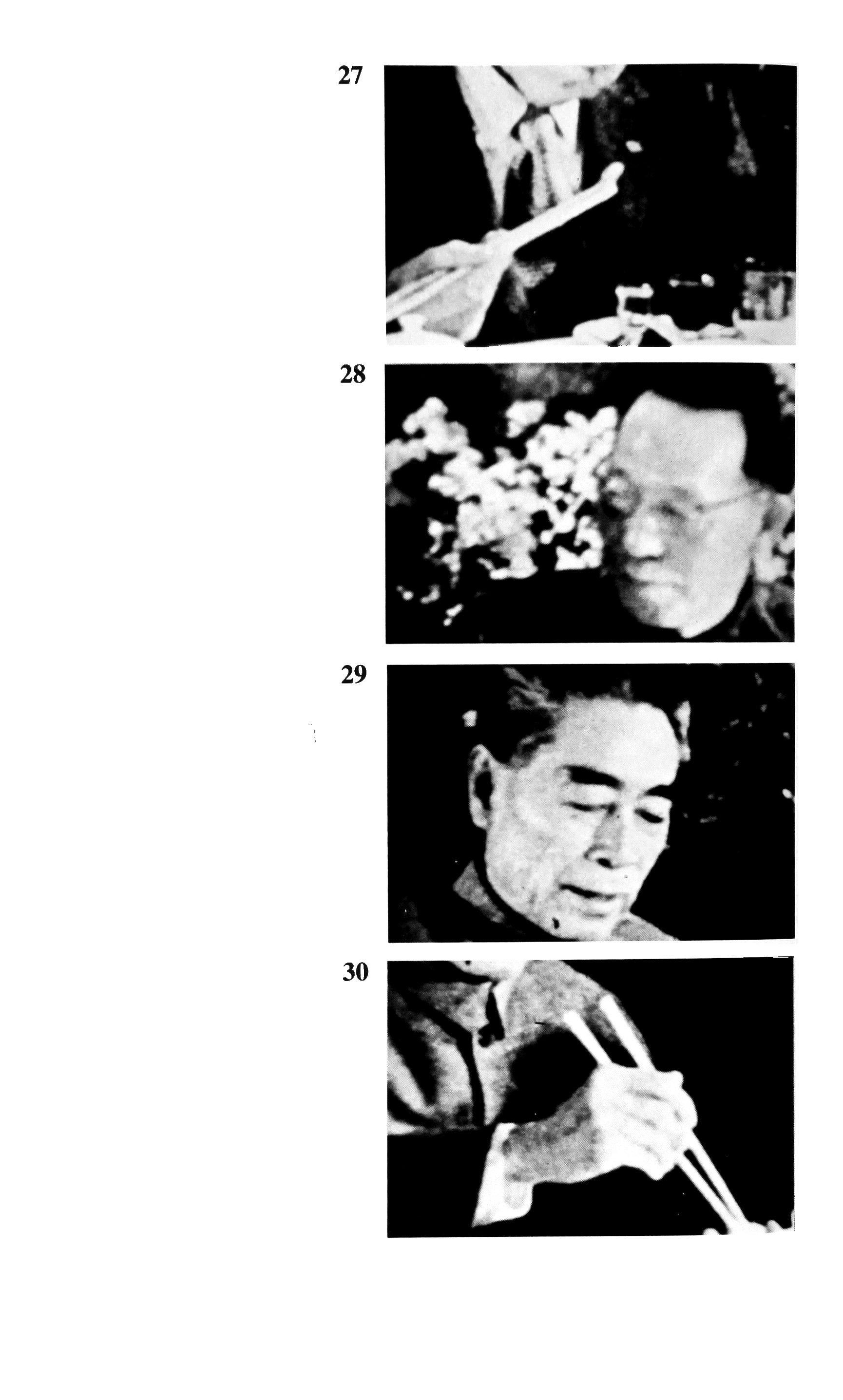

backdrop or what is it? Well, I assume they're real, for obvious reasons. What are the obvious reasons? For various reasons. Because it seems to me that it would be nice with that beautiful meal to have the fragrance ofthe flowers. And I can feel the fragrance of the flowers as I look at this picture. And I look at these men sitting there with all this colorful food sitting in front of them and the whole thing becomes a much more organic sort of thing. Is it possible that Nixon sits down at the table and says to himself, "I should take this point of view," and Chou sits down and says, "I should express this point of view?" I don't mean 'point of view' verbally but a pictorial point of view.
27 You can see it's a cashew nut now.
28 Before when I looked at this man I thought, well, he's really seeing something that he doesn't believe. Now I have the feeling when I look at him that he's seeing something that slightly amuses him. Like he's just starting to smile. Yes, so we could have a cross between amusement and not believing. I think there is that kind of amusement where you become amused because you don't quite believe that somebody has done something they appear to have done, like when somebody falls on a banana peel or your guest at dinner takes a drink and drops to the floor and it's a cross between not believing and being amused.
29 There's Chou. When I look at Chou this time around, he looks like a lot of people I know who like eating, about to get into a really good meal. He's licking his lips a little bit. He knows the stuff is tasty.
30 That's the top of Chou's hand. You notice in this, too, that even though that is just a man's hand with a pair of chopsticks in it, there is a kind of brutal control of that space. It's an unbelievable spatial photograph. It has extraordinary control
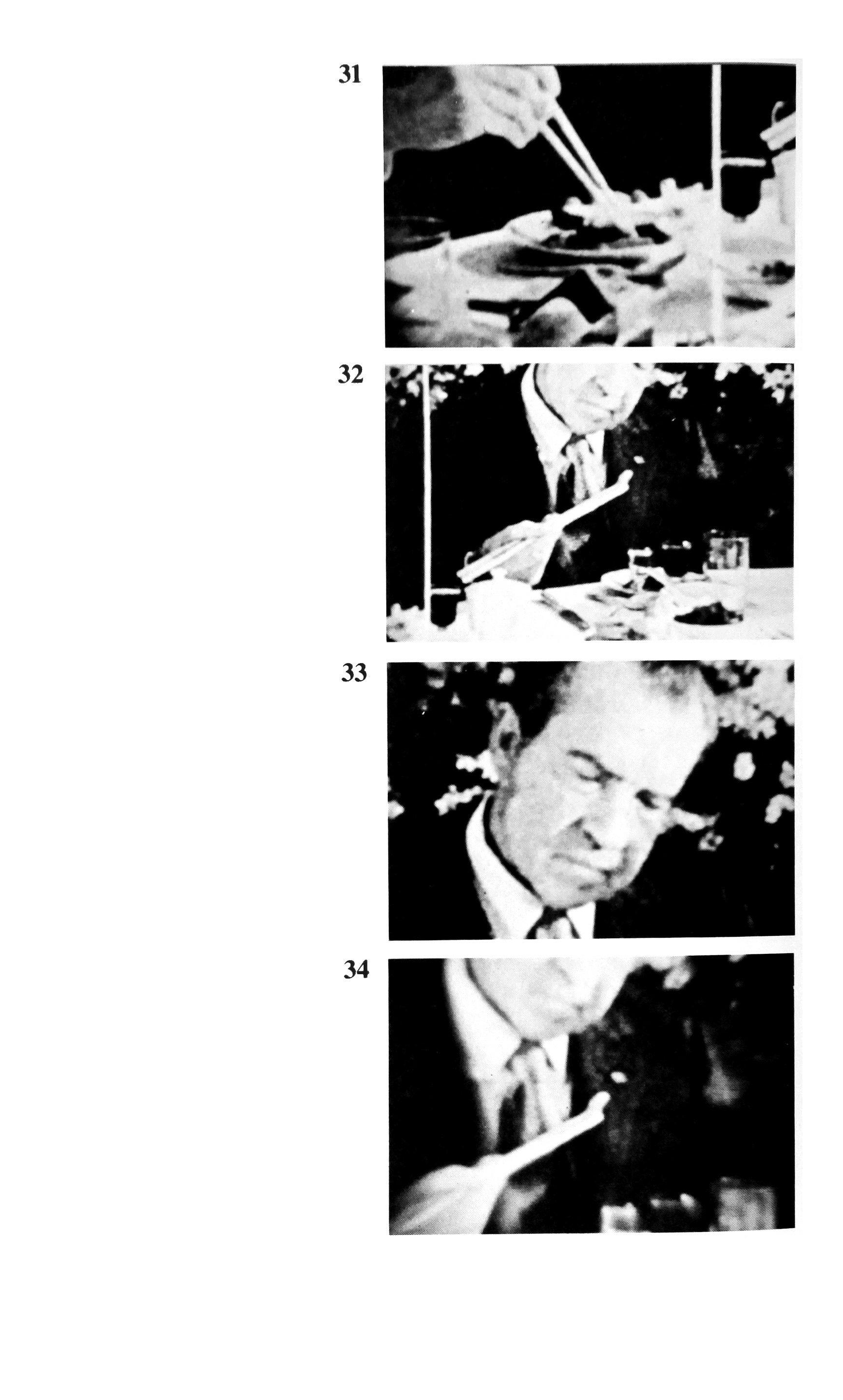
31 32 33 34
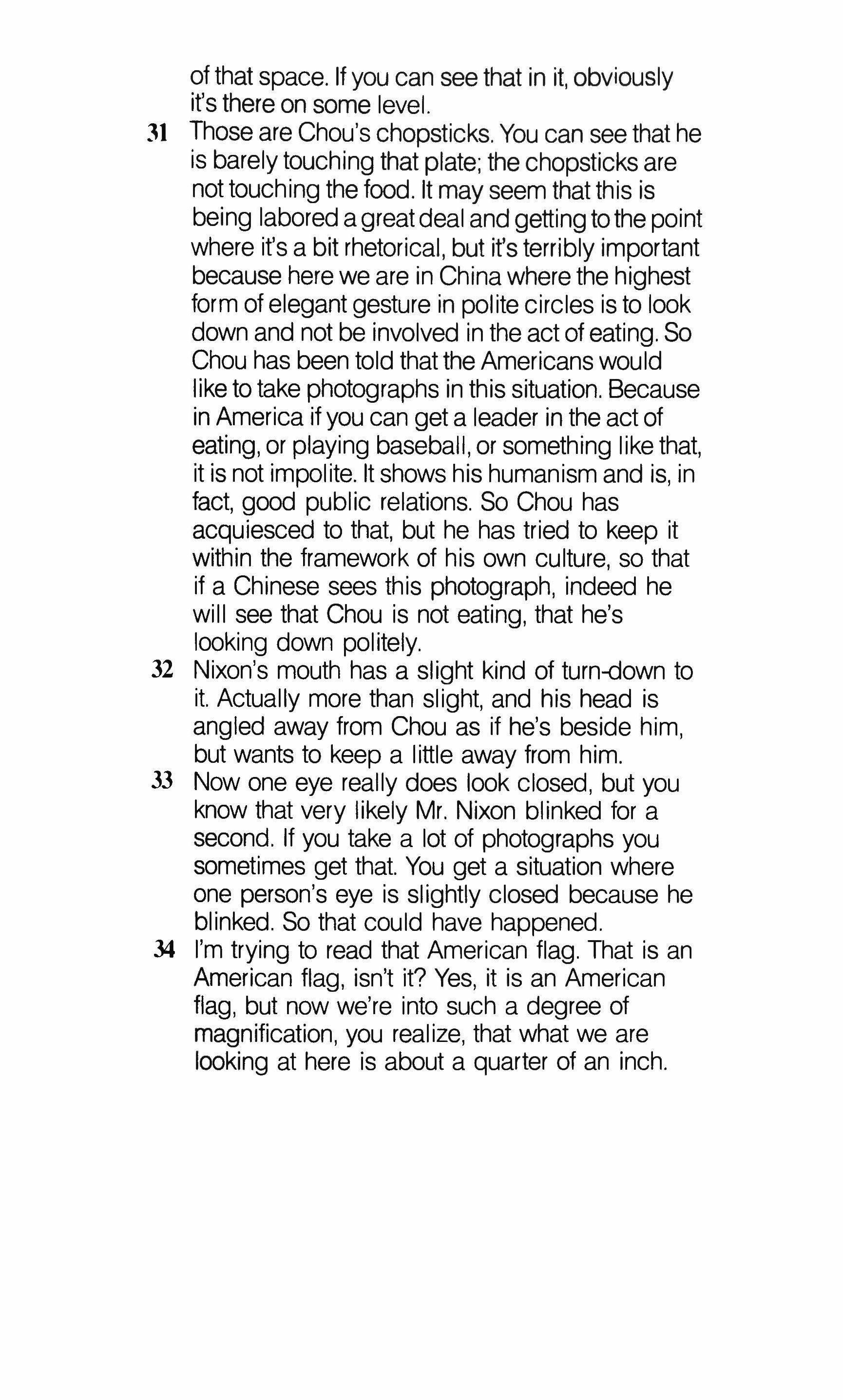
of that space. If you can see that in it, obviously it's there on some level.
31 Those are Chou's chopsticks. You can see that he is barely touching that plate; the chopsticks are not touching the food. It may seem that this is being labored a great deal and getting tothe point where it's a bit rhetorical, but it's terribly important because here we are in China where the highest form of elegant gesture in polite circles is to look down and not be involved in the act of eating. So Chou has been told that the Americans would like to take photographs in this situation. Because in America if you can get a leader in the act of eating, or playing baseball, or something like that, it is not impolite. It shows his humanism and is, in fact, good public relations. So Chou has acquiesced to that, but he has tried to keep it within the framework of his own culture, so that if a Chinese sees this photograph, indeed he will see that Chou is not eating, that he's looking down politely.
32 Nixon's mouth has a slight kind of turn-down to it. Actually more than slight, and his head is angled away from Chou as if he's beside him, but wants to keep a little away from him.
33 Now one eye really does look closed, but you know that very likely Mr. Nixon blinked for a second. If you take a lot of photographs you sometimes get that. You get a situation where one person's eye is slightly closed because he blinked. So that could have happened.
34 I'm trying to read that American flag. That is an American flag, isn't it? Yes, it is an American flag, but now we're into such a degree of magnification, you realize, that what we are looking at here is about a quarter of an inch.

Contributors
Christohas wrapped a considerable portion ofthe Australian coastline in fabric. His Running Fence Project succeeded the Valley Curtain, hung over a highway between two canyon walls in Colorado. Ira Joel Haber's sculpture has been exhibited in several Whitney Museum Annuals, and he has had one man shows at New York's Fischbach Gallery. Lawrence Weiner was born in the Bronx. Currently artist-in-residence at the University ofNorth Carolina at Greensboro, Marjorie Strider has had one woman exhibitions of her sculpture at the Pace and Nancy Hoffman Galleries in New York. Nancy Holt hasjust completed six circular pools of water which she calls "Hydra's Head," on a bank ofthe Niagara River in Lewiston, New York. Ms. Holt also makes filrns and videotapes. Hans Haacketeaches at the Cooper Union in New York. He has exhibited in the United States, Europe, and Japan. His Windand Water Sculpture was the subject ofTriQu(lI1erly Supplement #1. Adrian Piper studied art at the School of Visual Arts and has exhibited her work extensively in this country and abroad. She is presently a graduate student in philosophy at Harvard. Several of Alice Aycock's recent works are semi-architectural and deal with the interaction of structure, site, materials, and perceiver. She has participated in a number ofgroup shows and has had several individual exhibitions. Rafael Ferrer is the founder ofArttorhum and prefers to work in Spanish. He is "the most notorious ofthe Anti-Minimalist-Post-Conceptual Haranguist Poets." Eleanor Antin, whose"100 Boots" was exhibited at the Museum of Modem Art, is currently showing "two ofher selves" - ballerina and king - at New York's Stefanotty Gallery. Les Levine is an Associate Editor ofArts Magazine and President of the Museum of Mott Art. He was born in Ireland and has recently documented the Ulster troubles. Will Insley's piece is an excetpt from"Fragments from the Interior",

his larger work shO\VI1 last year at the Fischbach Gallery. All his work concerns "the theoretical (factual") uncovering of a future civilization." Brenda Miller has exhibited at the Whitney Museum (most recently in fall, 1974), at the Museum of Modem Art and in the Netherlands. Stephen Zaima claims that his works were heavily influenced by his suburban California background. He is presently teaching at the University of Iowa. Douglas Huebler studied at the University of Michigan and the Academic Julien in Paris. He has had shows in Israel and Japan as well as in the United States and Europe. Sol LeWitt "has been making art for some time." LeAnn Bartok Wilchusky's "Skyworks" (1973) featured streamers dropped from airplanes and skydivers. Ms. Wilchusky has recently turned to Earthworks in the Canadian Rockies. Author ofWhy Artists Fail, John Baldessari exhibited work in the recent show "Eight Contemporary Artists" at the Museum of Modem Art. Gregg Powell has studied at Cornell College and the University of Iowa. Michael Crane is working to develop "a vocabulary ofperceptions." Since 1973 he has worked in collaboration with Phil Berkman and A. Ribe. Phil Berkman, a native of Pennsylvania, has worked and shown mostly in Chicago. Some ofhis work has been exhibited in Brazil. A. Ribehas turned from ceramics to sculpture, environmental works, and geometry in that order. Her most recent interest is perception. A native of Barcelona, she now lives in New York. The words inRobert Barry's piece were "invented" or used for the first time by writers such as Milton, Shakespeare, Spenser, Tennyson, Bentham, and Webster. Scott Burton has had one man shows at the Whitney Museum, the Boston Museum of Fine Arts, and elsewhere. Born in Kleve, Germany, Joseph Beuys presently lives in Dusseldorf. Gilbert was born in a small Dolomite village in September of 1943. The son of a shoemaker, he began sculpting at the age ofeight.
George was born in 1942 and believes his father to be a carpenter. Vito Acconci's work is sometimes referred to as Body Art. He has shown in many American and European galleries. The Editor of TDR, Michael Kirby is also a director and a playwright, and is known as a "happenings" artist. His bookHappenings reflects his concern for this art form. Richard Long is English. His work involves the slight rearrangement ofpebbles and rocks on the English countryside. � Denes is known for her "triangulations," graphic works which "posit a synthesis of all knowledge." She is shown regularly in the Stefanotty Gallery in New York. Robert Smithson, who died in a plane crash in 1972, helpedpioneer Earth Art. Perhaps his best known works are the monumental "Spiral Jetty" in the Great Salt Lake and the "Amarillo Ramp." (The photo of Smithson's "Amarillo Ramp" is by Gianfranco Gorgoni.) Richard Serra creates large outdoor works, primarily in lead. Joseph Kosuth is a conceptual artist. Daniel Buren is French. He has worked for several years with two-color stripes. Some ofthese stripes have appeared on urban walls.Jan Sullivanlives in Chicago, and makes snow works in Wisconsin. John Perreault and Lawrence Levy are co-editors ofthis special issue ofTriQuarterly. John Perreault is art critic for the Village Voice, and is the author ofHarry, a book ofpoems. Lawrence Levy has been art director ofTriQuarterly for too long.

Cover photo: Robert Smithson's "Spiral Jetty," November, 1974. (Calvin Briggs, photographer. Courtesy of Utah State Division ofFine Art.)



























 [Joseph Beuys]
[Joseph Beuys]
 [Joseph 8euys]
[Joseph 8euys]
 [Joseph Beuys]
[Joseph Beuys]
 [Joseph Beuys]
[Joseph Beuys]
 [Joseph Beuys]
[Joseph Beuys]





 Ernest C. Harrie, P.E.
Ernest C. Harrie, P.E.










 [Oougla$ Huebler]
[Douglas Huebler]
[Oougla$ Huebler]
[Douglas Huebler]


 [Douglas Huebler]
[Douglas Huebler]
 [Douglas Huebler]
[Douglas Huebler]



 1. Control
1. Control
 2. Beard change
2. Beard change





























 Studio door
Apt building, basement
Mailbox
Bicycle chain
33-14-21
Gallery combination
Studio building, front door
Studio door
Apt building, basement
Mailbox
Bicycle chain
33-14-21
Gallery combination
Studio building, front door































 [Robert Smithson]
[Robert Smithson]



































































